WW1 German Naval Aviation
The Kaiserliches Marine and its Aviation Corps
The Marine-Fliegerabteilung first constituted consisted of Zeppelins (airships), observation balloons and fixed-wing aircraft. The main use of the Zeppelins was in reconnaissance over the North Sea and the Baltic, where the endurance of the craft led German warships to a number of Allied vessels. Zeppelin patrolling had priority over any other airship activity. During the entire war around 1,200 scouting flights were made.
During 1915 the German Navy had some 15 Zeppelins in commission and was able to have two or more patrolling continuously at any one time. They kept the British ships from approaching Germany, spotted when and where the British were laying sea-mines, and later aided in the destruction of those mines. Zeppelins would sometimes land on the sea surface next to a minesweeper, bring aboard an officer and show him the lay of the mines.
The Naval and Army Air Services also directed a number of strategic raids against Britain, leading the way in bombing techniques and also forcing the British to bolster their anti-aircraft defences. The possibility of airship raids were approved by the Kaiser on 9 January 1915, although he excluded London as a target and further demanded that no attacks be made on historic or government buildings or museums. The night-time raids were intended to target only military sites on the east coast and around the Thames estuary, but difficulties in navigation and the height from which the bombs were dropped made accurate bombing impossible, and most bombs fell on civilian targets or open countryside.
Stationed in North Sea coastal airfields, German naval aircraft often fought against their British counterparts of the Royal Naval Air Service. Naval pilots flew aircraft that were also used by the German Army’s Luftstreitkräfte in addition to seaplanes.
-Theo Osterkamp was one of the original naval pilots, the first German pilot to fly a land-based aircraft to England on a reconnaissance mission, and leading ace with 32 victories. In 1918 others naval air aces joined in with their own tally:
-Gotthard Sachsenberg (31 victories)
-Alexander Zenzes (18 victories)
-Friedrich Christiansen (13 victories)
-Karl Meyer (8 victories)
-Karl Scharon (8 victories)
-Hans Goerth (7 victories).
The “one day ace” was Gunther Plüschow, shooting down a Japanese Short floatplane from IJN Wakamiya during the Siege of Tsingtao, only German combatant to escape from a prison camp in Britain also…
List of aircraft that were assigned to naval air service:
- Kaiserliche Werft Danzig 1105 trainers
- Hansa-Brandenburg W.12 fighter floatplanes
- Hansa-Brandenburg W.29 fighter floatplanes
- Marine Feld Jasta I
- Marine Feldflieger Abteilung II
Naval Air Service (Marine Jagdgruppe Flandern):
Overview of Manufacturers
- AEG
- AGO
- Albatros
- DFW
- Euler
- Etrich Taube
- Fokker
- Gotha
- Hansa-Brandenburg
- Halberstadt
- Hannover
- Junkers
- LFG Roland
- LVG
- Pfalz
- Rumpler
- Sablatnig
- Schütte-Lanz
- Siemens-Schuckert
- Zeppelin series
- German Blimps
- Other Manufacturers & prototypes
The Luftstreitkräfte (Air Force)
The German Imperial Air Force grew out of the need to put an end to frequent incursions by French observers during the first weeks of the war, which the Allied Staff greatly benefited from. This resulted from the fact that according to the Schlieffen Plan, the Germans made a vast invasion movement through the Neutral North, and that the French remained the weapon with the foot in defense. They are therefore the first to design hunters, a term also adapted to Germans in French as in English. The latter lag behind in this respect, continuing to design armed observation planes in 1915 instead of true fighters.
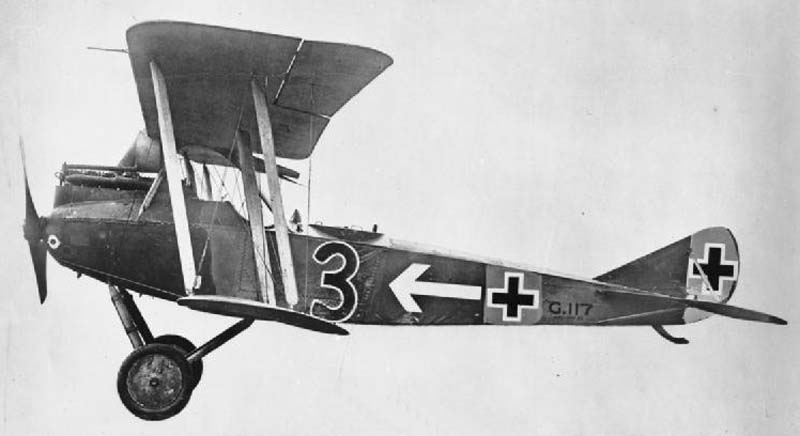
If Germany had since 1870 some experience of ballooning thanks to pioneers of the non-motorized flight like Otto Lilienthal, or pilots trained on French equipment (Déperdussin) and a control of the airships thanks to the count Von Zeppelin, a name is obviously unavoidable in this area: Anthony Fokker. A Dutchman of origin, but living in Germany where his small monoplane devices were echoed, he soon won the contest to replace the Taube (Famous monoplane fighter who sowed terror throughout the year 1914), inspired by the Morane-Saulnier H, the Eindecker I, followed at the beginning of 1915 of the EII, and finally of the EIII, but also applied to conceive biplanes remained famous as the DI, and D.II, and especially the DR.I, first operational triplan, these devices allowing with the planes of Albatros, the great rival, to maintain the “plague Fokker”, a myth of invincibility well maintained by the ace of aces, Manfred Von Richtofen. http://illustrashop.com/aileslegendaires2.com/photos_ferte/
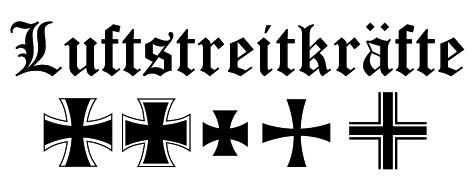
Chance or not, many aristocrats engaged in fighter aviation, patriotic continuation of a national sport. The image of the pilot quickly became that of the “flying gentleman”, and the knights of the sky. A whole romantic mythology plunged on this subject in the German middle-aged past. This domination, initiated in 1916 and continued until the beginning of 1917, began to end with the arrival of new British and French models such as Spad VII, Sopwith Camel and RAF Se.5. But the time of Aces was growing, and with Richtofen, Max Immelman, and a figure of aerobatics to which he left his name, Oswald Boelcke, the first fighter pilot, Rudolf Berthold, who did not engage until 1918 but He obtained – on Fokker D.VII – 44 authenticated victories and could have preceded Richtofen, or Verner Voss.
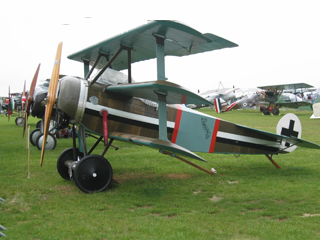 This supremacy in the precocity of the hunter concept was also doubled by the adaptation in 1914, and by Fokker, of the machine gun synchronized with the propeller. This intricate mechanism that the Germans jealously guarded the secret – at least until a device was captured after a crash in the allied lines – allowed to shoot through the propeller, which gave the tractive propeller apparatus a real advantage over allied aircraft whose machine gun at the front forced to push the engine behind the pilot, or the machine gun perched on the upper wing, firing position inconvenient for the pilot. There was also the maneuverability of German aircraft, combined with a quality engine, reliable and powerful (and in this respect, the great engine manufacturers were not lacking, as Mercedes and Siemens for online engines, ensuring a good aerodynamics unlike the rarest air-cooled star motors, such as öberusel or BMW engines, and Albatros had an undeniable advantage in terms of air penetration and top speed.
This supremacy in the precocity of the hunter concept was also doubled by the adaptation in 1914, and by Fokker, of the machine gun synchronized with the propeller. This intricate mechanism that the Germans jealously guarded the secret – at least until a device was captured after a crash in the allied lines – allowed to shoot through the propeller, which gave the tractive propeller apparatus a real advantage over allied aircraft whose machine gun at the front forced to push the engine behind the pilot, or the machine gun perched on the upper wing, firing position inconvenient for the pilot. There was also the maneuverability of German aircraft, combined with a quality engine, reliable and powerful (and in this respect, the great engine manufacturers were not lacking, as Mercedes and Siemens for online engines, ensuring a good aerodynamics unlike the rarest air-cooled star motors, such as öberusel or BMW engines, and Albatros had an undeniable advantage in terms of air penetration and top speed.
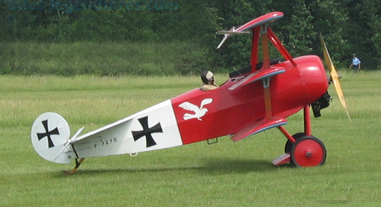 But the armistice put an end to the development of the German military aviation. Fokker was forced to return to his homeland and to civilian productions, Albatros, LFG were dissolved, as well as most of the mass-produced aircraft manufacturers, as well as Von Zeppelin himself, who for a time tried a few heavy civilian aircraft. Only Junkers, who in 1918 produced for the Jasta hunters monoplanes and all-metal assault aircraft, continued his career throughout the years twenty, thirty and forty. It was this last which allowed the German civil aviation to be constituted. More: WWI Central Powers aircraft
But the armistice put an end to the development of the German military aviation. Fokker was forced to return to his homeland and to civilian productions, Albatros, LFG were dissolved, as well as most of the mass-produced aircraft manufacturers, as well as Von Zeppelin himself, who for a time tried a few heavy civilian aircraft. Only Junkers, who in 1918 produced for the Jasta hunters monoplanes and all-metal assault aircraft, continued his career throughout the years twenty, thirty and forty. It was this last which allowed the German civil aviation to be constituted. More: WWI Central Powers aircraft
A.E.G. C.4

This small single-engine biplane was the fruit of the company Aero E G, as an observation device armed in 1915. It was also used as a hunter because of its good performance and light bomber.
Dimensions: Wingspan: 12 m, Length 7.8 m, Height 2.65 m
Weight: empty: 750 Kgs. In charge: 930 Kgs.
Motorization: 1 Mercedes-Benz 43 of 150 hp
Performance: Vmax: 130 km / h at 2000 m, ceiling 4000 m, RA 600 km.
Armament: 2 mitt. Rheinmetall 7.9 mm wing and rear station, 60 Kgs. bombs.
Albatros D.V

Dreadful hunter if any, the Albatros D.V was the descendant of the family of D.II and D.III hunting biplanes. He was taller, more powerful and had the most aerodynamic fuselage of the time, a feat of plywood design and soft spars dressed in light wood. It was operational in April 1917 and more than 1100 copies will be built until the armistice.
Dimensions: Wingspan: 12 m, Length 7.8 m, Height 2.65 m
Weight: empty: 650 Kgs. In charge: 850 Kgs.
Motorization: 1 Mercedes-Benz 43 of 180 hp
Performance: Vmax: 190 km / h at 2000 m, ceiling 4000 m, RA 300 km.
Armament: 2 mitt. Rheinmetall 7.9 mm hood.
Fokker D.VI

This small single-engine biplane was the fruit of the company Aero E G, as an observation device armed in 1915. It was also used as a hunter because of its good performance and light bomber.
Dimensions: Wingspan: 12 m, Length 7.8 m, Height 2.65 m
Weight: empty: 750 Kgs. In charge: 930 Kgs.
Motorization: 1 Mercedes-Benz 43 of 150 hp
Performance: Vmax: 130 km / h at 2000 m, ceiling 4000 m, RA 600 km.
Armament: 2 mitt. Rheinmetall 7.9 mm wing and rear station, 60 Kgs. bombs.
Fokker D.VII

Certainly the best German fighter, and probably the best of the Great War, the D.VII had the honor of appearing in the Armistice Treaty because of the terror it inflicted on the Allied airmen. Arrived late, in November 1917, and operational in large numbers by 1918, he was superior in speed, maneuverability, power, to all that the allies possessed, Spad XIII, Sopwith Camel, SE5a … It is only by the numerical superiority of the allies, and the reinforcement of the American pilots, that its results were diminished and that it did not tilt the control of the sky on the side of the axis. Its production continued after the war under license, Fokker having been forced to leave Germany and reconverting itself to peaceful civilian aircraft. Many were still in service around the world in the late 1920s, and even more so as converted two-seat civil aircraft.
Dimensions: Wingspan: 12 m, Length 7.8 m, Height 2.65 m
Weight: empty: 750 Kgs. In charge: 930 Kgs.
Motorization: 1 Mercedes-Benz 43 of 150 hp
Performance: Vmax: 130 km / h at 2000 m, ceiling 4000 m, RA 600 km.
Armament: 2 mitt. Rheinmetall 7.9 mm wing and rear station, 60 Kgs. bombs.
Fokker D.VIII

Last Fokker fighter, released in mid-1918, the D.VIII took the solution of the high wing that had made the success of Moranes, with sufficient compactness to allow its engine to express itself fully, faster and more Solid biplane, combined speed and maneuverability were excellent and the first drivers were enthusiastic, but it came too late and too few to change the game.
Dimensions: Wingspan: 12 m, Length 7.8 m, Height 2.65 m
Weight: empty: 750 Kgs. In charge: 930 Kgs.
Motorization: 1 Mercedes-Benz 43 of 150 hp
Performance: Vmax: 130 km / h at 2000 m, ceiling 4000 m, RA 600 km.
Armament: 2 mitt. Rheinmetall 7.9 mm wing and rear station, 60 Kgs. bombs.
Fokker DR.1


This unique triplane “dreideker” Fokker owed its legendary reputation to the brilliance of its pilots as well as its maneuverability resulting from the excellent Sopwith Triplane, extrapolation of the Pup in 1916, which outclassed the German fighters and of which a specimen crushed, captured and recovered by Fokker was duplicated. Ace Von Richtofen, Ernst Udet and many others won most of the victories on this device, especially during the glory days of the “flying circus” that made the law in the skies of northern France in April 1917 .
Dimensions: Wingspan: 12 m, Length 7.8 m, Height 2.65 m
Weight: empty: 750 Kgs. In charge: 930 Kgs.
Motorization: 1 Mercedes-Benz 43 of 150 hp
Performance: Vmax: 130 km / h at 2000 m, ceiling 4000 m, RA 600 km.
Armament: 2 mitt. Rheinmetall 7.9 mm wing and rear station, 60 Kgs. bombs.
Fokker EIII

Issudes EI and EII, combat monoplanes, the first Fokker fighters were very inspired by French fighters Morane La. They had a single synchronized machine gun, which was in their advantage, and generally better performance than French planes. On the other hand, in maneuverability, it was outclassed by Nieuport XI, XII and Sopwith Pup.
Dimensions: Wingspan: 12 m, Length 7.8 m, Height 2.65 m
Weight: empty: 750 Kgs. In charge: 930 Kgs.
Motorization: 1 Mercedes-Benz 43 of 150 hp
Performance: Vmax: 130 km / h at 2000 m, ceiling 4000 m, RA 600 km.
Armament: 2 mitt. Rheinmetall 7.9 mm wing and rear station, 60 Kgs. bombs.
Halberstadt D.II

This small single-engine biplane was the fruit of the company Aero E G, as an observation device armed in 1915. It was also used as a hunter because of its good performance and light bomber.
Dimensions: Wingspan: 12 m, Length 7.8 m, Height 2.65 m
Weight: empty: 750 Kgs. In charge: 930 Kgs.
Motorization: 1 Mercedes-Benz 43 of 150 hp
Performance: Vmax: 130 km / h at 2000 m, ceiling 4000 m, RA 600 km.
Armament: 2 mitt. Rheinmetall 7.9 mm wing and rear station, 60 Kgs. bombs.
Junkers J.I
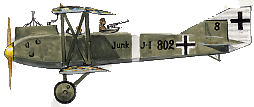
This small single-engine biplane was the fruit of the company Aero E G, as an observation device armed in 1915. It was also used as a hunter because of its good performance and light bomber.
Dimensions: Wingspan: 12 m, Length 7.8 m, Height 2.65 m
Weight: empty: 750 Kgs. In charge: 930 Kgs.
Motorization: 1 Mercedes-Benz 43 of 150 hp
Performance: Vmax: 130 km / h at 2000 m, ceiling 4000 m, RA 600 km.
Armament: 2 mitt. Rheinmetall 7.9 mm wing and rear station, 60 Kgs. bombs.
LFG Roland C.VI

This small single-engine biplane was the fruit of the company Aero E G, as an observation device armed in 1915. It was also used as a hunter because of its good performance and light bomber.
Dimensions: Wingspan: 12 m, Length 7.8 m, Height 2.65 m
Weight: empty: 750 Kgs. In charge: 930 Kgs.
Motorization: 1 Mercedes-Benz 43 of 150 hp
Performance: Vmax: 130 km / h at 2000 m, ceiling 4000 m, RA 600 km.
Armament: 2 mitt. Rheinmetall 7.9 mm wing and rear station, 60 Kgs. bombs.
Pfalz D.III

This small single-engine biplane was the fruit of the company Aero E G, as an observation device armed in 1915. It was also used as a hunter because of its good performance and light bomber.
Dimensions: Wingspan: 12 m, Length 7.8 m, Height 2.65 m
Weight: empty: 750 Kgs. In charge: 930 Kgs.
Motorization: 1 Mercedes-Benz 43 of 150 hp
Performance: Vmax: 130 km / h at 2000 m, ceiling 4000 m, RA 600 km.
Armament: 2 mitt. Rheinmetall 7.9 mm wing and rear station, 60 Kgs. bombs.
Pfalz D.XIII

This small single-engine biplane was the fruit of the company Aero E G, as an observation device armed in 1915. It was also used as a hunter because of its good performance and light bomber.
Dimensions: Wingspan: 12 m, Length 7.8 m, Height 2.65 m
Weight: empty: 750 Kgs. In charge: 930 Kgs.
Motorization: 1 Mercedes-Benz 43 of 150 hp
Performance: Vmax: 130 km / h at 2000 m, ceiling 4000 m, RA 600 km.
Armament: 2 mitt. Rheinmetall 7.9 mm wing and rear station, 60 Kgs. bombs.
Siemens-Schukert D.II

This small single-engine biplane was the fruit of the company Aero E G, as an observation device armed in 1915. It was also used as a hunter because of its good performance and light bomber.
Dimensions: Wingspan: 12 m, Length 7.8 m, Height 2.65 m
Weight: empty: 750 Kgs. In charge: 930 Kgs.
Motorization: 1 Mercedes-Benz 43 of 150 hp
Performance: Vmax: 130 km / h at 2000 m, ceiling 4000 m, RA 600 km.
Armament: 2 mitt. Rheinmetall 7.9 mm wing and rear station, 60 Kgs. bombs.
German WWI Aircraft Manufacturers
AEG
 AEG Planes
AEG Planes
About Allgemeine Elektricitäts-Gesellschaft
The “General electricity company” (AEG), was a German electrical equipment specialist founded as the Deutsche Edison-Gesellschaft für angewandte Elektricität in 1883 in Berlin by Emil Rathenau (An Edison-patented company). After being relocated post-1945, the company evolved and eventually joined in 1996 Daimler-Benz AG, later DaimlerChrysler, then Adtranz and Deutsche Aerospace, DASA, and now EADS.
The company was credited with a number of inventions and innovation in electrical engineering and full expansion, it entered the automobile and airplane markets as well as supplying the German railways. In the Aviation field, the company expanded the aircraft business at the request of the German authorities, in dire need of more manufacturers, but AEG started already in 1912.

The AEG G.IV heavy bomber
AEG Planes
AEG manufactured a wide range of aircraft from 1912 to 1918 starting with a Wright brothers ripoff with a wingspan of 17.5 m (57 ft) and powered by an 8-cyl. 75 hp engine, lifting its 850 kg empty. Top speed was 65 km/h (40 mph). Construction moved to plywood and steel tubes covered with fabric, and tractor biplanes. The Riesenflugzeug (“giant aircraft”) AEG R.I. was one of the most impressive of the serie, a heavy bomber, four times 260 hp (190 kW) with Mercedes D.IVa engines using a combed leather cone and dog clutch gears.
It first flew on 3 September 1918, but broke up in flight, killing seven, which stopped the program. The best AEG design was certainly G.IV Grossflugzeuge heavy tactical bomber, of which 320 were built, one being preserved to this day. During WW2 AEG made reconnaissance aircrafts, including an interesting tethered “helicopter” used in U-Bootes.

The AEG B.I recce biplane, first model of the serie in 1914
AEG models in detail
The B.I was the first two-seat biplane by AEG. It was an unarmed reconnaissance aircraft but production was very limited in 1914.
It was 10.5 m (34 ft 5 in) long by 14.5 m (47 ft 7 in) wingspan, and weighted 650 kg/1,040 kg propelled by a Mercedes D.I 6-cyl. water-cooled in-line piston engine rated for 74.5 kW (99.9 hp), capable of 100 km/h (62 mph; 54 kn) and capable of a 2,500 m (8,200 ft) ceiling.
It was soon overshadowed by the AEG B.II, same two-seater of 1914, slightly smaller but more successful. A few were built from 1914 to 1915, and soon replaced, lacking any armament and being slow. It had a more powerful Mercedes D.II 6-cyl. rated for 89.5 kW (120.0 hp), giving a 110 kph top speed. The B.III was not a large production plane in early 1915, an evolution of the B.II, with a new tailplane assembly but was still slow and unarmed and was used for reconnaissance and later as a trainer in 1915.
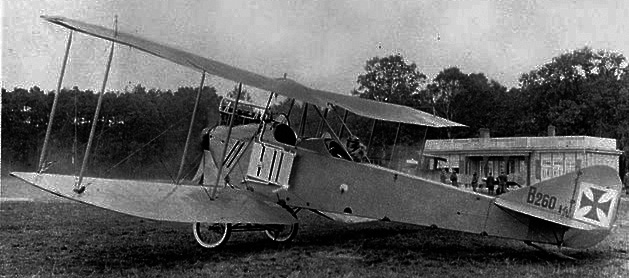
The AEG B.II recce biplane of 1914
The next logical step was for AEG to arm the next iteration, the C.I with a single 7.92 mm (.312 in) Parabellum/Bergmann machine gun mounted over the observer’s cockpit for the observer and a more powerful engine while power was increased with a Benz engine allowing to achieve 130 km/h (81 mph). Production was limited but stopped mid-1915 and by October 1915, it was already replaced by the C.II.
The latter was slightly smaller which allowed better performance, and redesigned cockpits with a rear-mounted 7.92 mm (.312 in) Parabellum MG14 MG and able to carry four 10 kg (22 lb) bombs. The next C.III was a single prototype featured an unusual fuselage design stretched between the upper and lower wings. This provided a better pilot’s vision, while the observer had a wider field of fire, the pilot seating behind him. The C.III failed its tests and was never ordered despite a better 158 km/h (98 mph) top speed.
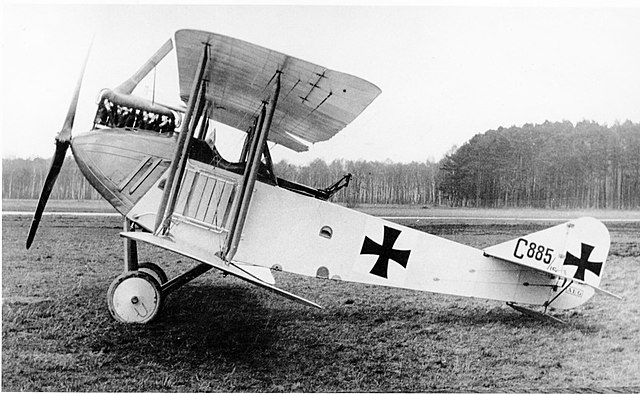
The AEG C.II recce biplane of 1914
The AEG C.IV was the most produced of this serie. It entered service in 1916, based on the AEG C.II, but with a larger wingspan, and two forward Spandau-type 7.92 mm (.312 in) machine guns. From reconnaissance, the model was used as an escort fighter, although underpowered. This was the most successful AEG model of the war with some 687 delivered and in service until the last days of the war.
The C.IV.N was a prototype night bomber of 1917 powered by the Benz Bz.III engine (of the C-types) and lengthened wingspan while the other experimental C.IVa, was given a 130 kW/180 hp Argus As III engine. This model also see action with the Bulgarian Air Force and the Turkish Flying Corps (46 in all). About 91 spare stock C.IVs were captured by the Polish in 1919, assembled, entering service with the Polish Air Force in the Polish-Soviet War.

The AEG C.IV recce biplane of 1916
The next C.V remained at prototype stage. It first flew in February 1916, and used a Mercedes D.IV 8-cyl. water-cooled engine rated for 164 kW (220 hp). The C.VI was another developement in 1916 from the AEG C.IV, which did not entered production. It had a Benz Bz.IV 6-cylinder, water-cooled, inline engine rated for 200 hp, or 150 kW. The next c.VII was also a prototype two-seat reconnaissance biplane developed from the C.IV, tested with two different wing arrangements, but never entered production. The following C.VIII was also a derivative with a new engine, for which two prototypes were built, one in biplane configuration, the other a triplane but none justified any production.
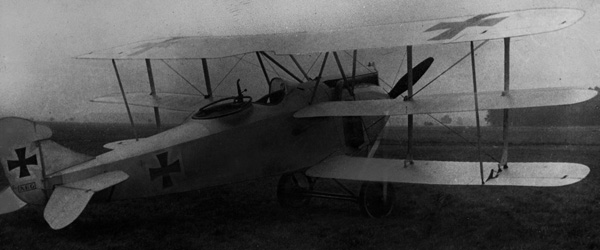
The AEG C.VIIIdr triplane prototype of 1916
AEG also worked in 1915 on bombers. The experimental G.I was a twin-engined, designated at the beginning the K.I designed as a three-seater biplane bomber, tested, flew in early 1915 and found viable in the latter half of 1915, but performances were weak, leading the G.II. This new model was tested from July 1915. it had basically more powerful engines and was armed with three 7.92 mm (.312 in) machine guns. It could carry 200 kg (440 lb) of bombs but suffered stability problems. Additional vertical tail surfaces on the fin and rudder fitted on many models later had better handling.
In all, twenty were built and in service for the duration of the war. They were propelled by a pair of Benz Bz.III 6-cyl. water-cooled in-line piston engines rated for 112 kW (150 hp), and armed by up to three 7.92 mm (.312 in) machine guns. The next G.III was flew in December 1915, and it was powered by two Mercedes D.IV 8-cylinder water-cooled inline piston engines rated for 164 kW (220 hp), which could carry a 50% increase in bomb load were built in small numbers and seeing limited operational use. Production records are unknown.
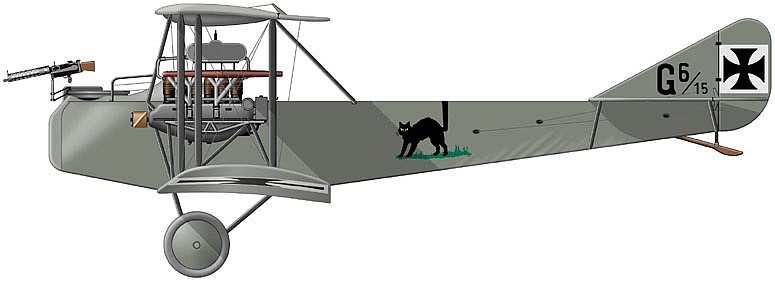
Profile of the AEG G.II bomber of 1916, wikimedia commons Blueprint
The next C.IV serie was however a different story. It was developed from G.III with more powerful engines, a higher bomb-load (Twice higher than the G.II) and increased dimensions. It entered service in late 1916, and featured a bomb capacity twice as large as that of the AEG G.II.
It was arguably the most modern german bomber of that era, having onboard radios and electrically heated suits for the crew, and being of all-metal, welded-tube frame, construction. It was also innovative as having the rear gunner’s cockpit position given a hinged window in the floor to spot pursuing aircraft.
However by 1916 standards, Idflieg considered it still inadequate both for performances and payload, and improvements led to the development of the G.V, which was tested but did not became operational before the end of the war. The AEG G.IV was the most produced of the whole serie, and achieve operational success both in long-range reconnaissance and combat.

AEG G.IV bomber in Canada Aviation and Space Museum.
One variant was known as the antitank gunship G.IVk (Kanone) fitted with two 20 mm Becker cannon, never operational. Another variant was called the G.IVg, fitted with an increased span three-bay wing. More easy to fly than the heavy Friedschafen, the served as tactical bomber close to the front lines in day and night operations. Outside the western front, the G.IV also served in Romania, Greece and Italy. Considered obsolescent in 1918 it was chiefly used for night raids. And at that stage they served mainly as nuisance raids without true objective.
As proof of its comfort and ruggedness, G.IVs of Kampfgeschwader 4 flew seven times in a single night on the Italian front. A single one is now preserved at the Canada Aviation and Space Museum. The G.V had a 600 kg (1,320 lb) bombload, but was ready too late in the war, although it was tested and a small production took place. None became operational. Instead, they joined the postwar Swedsih Air Force. Several were also converted into 6-passenger airliners for the Deutsche Luftreederei, the only large German WWI aircraft to see such service, for which passengers sat soon in an enclosed Limousine version was soon developed while the nose was fitted with a hinged door for baggage and a toilet installed aft of the passenger cabin.

AEG D.I fighter
Of course, AEG attempted to create a single-seat high performances fighter, the AEG D.I, and three prototypes were ordered on blueprints. The first two experienced serious crashes killing the ace Walter Höhndorf on September 1917, and the whole development was cancelled. But a triplane version was developed, named the Dr.I. All three were powered by a Daimler D.IIIa 6-cylinder, liquid-cooled, inline piston engine, 160 hp/120 kW. At the end of the war, AEG attempted to convert a C.IV as an armoured fighter, specialized for ground attacks. The DJ.I as it was known, was a highly streamlined biplane which undergone evaluation from September to the Armistice, and therefore never passed this stage.

AEG J.I fighter
After successful experiments during the Battle of Verdun in 1916, the Flieger Infantry advocated for the formation of tactical support squadrons, whose equipment became a priority. To meet this urgent need, AEG developed from the C.IV a two-seater propelled by a 200 hp Benz Bz IV engine. The crew and engine were protected by no less than 390 kg of armor. The aft fuselage floor was open to a twin-mount 08/15 with 7.92 mm machine guns able to swivel to an angle of 45° while the observer’s Parabellum MG was preserved, and the hood LMG 08/15 suppressed.
Produced started in 1917, waiting for the arrival of the better adapted AEG DJ.I. The J.II Structurally similar to the J.I the J.II introduced ailerons aerodynamically balanced by large horn extensions at the wing-tips, increased fin area to improve directional stability and a re-located aileron link strut. A grand total of 609 were built from both series. The AEG J.Ia variant featured additional aileron controls on the lower wings.
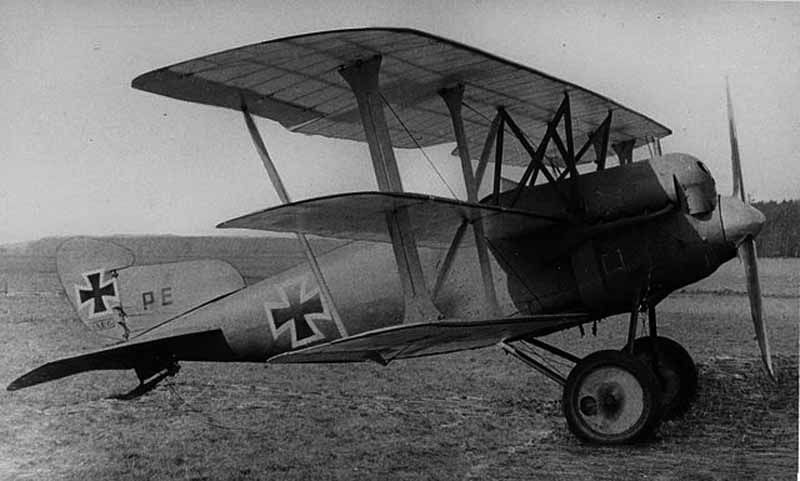
AEG PE Triplane
The AEG N.I was a German biplane night-bomber which saw limited action as a total of 37 only were built, but several were used postwar as airliners. The AEG PE was the Panzer Einsitzer, “armoured one-seater” triplane, a ground-attack aircraft designed from the outset for that role. It was found too heavy for the Idflieg and was rejected for poor maneuverability, making it an easy prey to enemy.
The R.I heavy bomber or Riesenflugzeug 1 was a multi-engined aircraft that carried all its Mercedes D.IVa 6 cyl. water-cooled in-line piston engines, rated 194 kW (260 hp) within the fuselage while a system of drive shafts driving the external propellers. It was protected by five 7.92 mm (.312 in) machine guns and could carry up to 3,800kg (8,377lb) bomb load.
A first prototype was tested in 1916, which was successful, but on 3 September 1918 was plagued by excessive vibrations resulting in the breakup of the aircraft, with the whole seven crew dead. Seven further AEG R.1 were under production in various stages when the war ended, but only R.21 was completed, never operational. The R.II remained on the drawing board. It was completely different, with a thick all-metal wing. This monoplane recalled some all-metal Junkers and Staaken projects and its design were very advanced in November 1918.

AEG Eule – http://www.muzeumlotnictwa.pl
The Eule (“Owl”) was designed by engineer Wagner as a two seater, mid-wing monoplane. Its fuselage was made of welded steel tubs wrapped with fabric, and oak wood, fabric covered wings. The 4.77 meters long fuselage had a 110 cm x 98 cm cross section. The wings featured a scalloped, bat-like trailing edge and curving leading edge.
The overall shape was reminiscent of a bat. The first prototype used a Gnome rotary engine and only made taxi tests but was lost in a fire. The second prototype was given an inline 4-cylinder engine, possibly from a Ford Model T. The few tests gave no satisfaction and the whole program was dropped. Structurally, it inspired however the next B, C and J classes. The Eule prototype display in the AEG aircraft assembly hall, donated to the German Aviation Collection in Berlin, moved to German-occupied Poland, captured by the Russians, and then in storage in the Polish Technical Museum shipped in 1963 to the Krakow Aviation Museum.
- AEG B.I reconnaissance 1914 (c10?)
- AEG B.II reconnaissance1914 (c50)
- AEG B.III reconnaissance 1914 (c100)
- AEG C.I reconnaissance 1915 (c100)
- AEG C.II reconnaissance 1915 (c100)
- AEG C.III reconnaissance 1915 prototype
- AEG C.IV reconnaissance 1916 (687)
- AEG C.IVN night bomber (1)
- AEG C.IVa reconnaissance 1916 (1)
- AEG C.V reconnaissance 1916 (1)
- AEG C.VI reconnaissance 1916 (1)
- AEG C.VII reconnaissance 1916 (2)
- AEG C.VIII reconnaissance 1916 (1)
- AEG C.VIII Dr reconnaissance triplane 1917 (1)
- AEG D.I fighter 1917 (3)
- AEG G.I/K.I bomber 1915 (1)
- AEG G.II bomber 1915 (20)
- AEG G.III bomber 1916 (c15)
- AEG G.IV bomber 1916 (320)
- AEG G.V bomber 1918 (c50)
- AEG J.I/J.II ground attack aircraft 1917 (609)
- AEG DJ.I armoured ground attack fighter 1918 (1)
- AEG Dr.I triplane fighter 1918 (1)
- AEG N.I night bomber 1917 (37)
- AEG PE armoured triplane ground attack fighter 1918 (1)
- AEG R.I heavy bomber (2)
- AEG R.II heavy bomber (Project)
- AEG Wagner Eule (2)
Read More/Sources
https://en.wikipedia.org/wiki/Allgemeine_Elektricit%C3%A4ts-Gesellschaft
https://www.militaryfactory.com/aircraft/contractor.asp?thisCompany=AEG
https://en.wikipedia.org/wiki/AEG_G.IV
https://www.ranker.com/list/aeg-aircraft-and-jets-and-planes/reference
https://web.archive.org/web/20051003210047/http://www.luftfahrtmuseum.com/htmi/itf/aegb1.htm
AGO
Gustav Otto, creator of AGO

Otto C.I 1914
In 1910, Gustav Otto founded the “Aeroplanbau Otto-Alberti” workshop at the Puchheim airfield, southern Germany. They flew their own planes made of wood, wire, and canvas powered by a small engine and while helping their passion gradually extended their workshop activities to an industry. Ernst Udet, the second best German ace leaned his license with Gustav himself. In 1911, the growing company was relocated and renamed “Gustav Otto Flugmaschinenfabrik” in Munich.
Its office was seated at 72 Karlstrasse, but the workshop was again moved to 37 Gabelsberger Strasse and 135 Schleissheimer Strasse on a much larger area. In 1914 Gustav started settling a brand new factory this time at 76 Neulerchenfeldstrasseand eventually on Lerchenauer Strasse, east of the Oberwiesenfeld troop maneuver area around Munich (soon main Munich’s airfield and later airport). Gustav also managed to be closer to the German government’s procurement process. In 1915, the company became the “Otto Werke, Gustav Otto, München” and he established another company, AGO Flugzeugwerke in the North, at Berlin’s Johannisthal Airfield.
Early Otto designs were successful but he was never able to reach a cost-effective production. Otto Werke supplyed the German Air Force, but production problems accumulated to the point officials from the government agencies urged him to nationalize it. Pressure would ultimately had severe consequences on Gustav’s health and after a while as no solution was in sight, the Bavarian and Prussian War Ministries ordered the company was taken over and run by the German Government, while Gustav Otto was forced to resign. The company was reorganized into Bayerische Flugzeugwerke AG in March 1916 and the company was later merged with BMW AG in 1922.
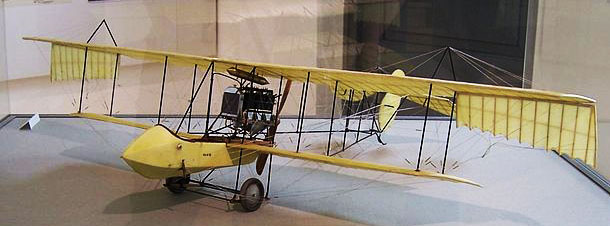
Otto Doppeldecker pusher 1913 model
Otto models
Production was limited both in numbers as seen above, and in types.
- Otto 1913 pusher biplane (90+ ?)
- Otto B 1914
- Otto B.I
- Otto C.I 1915
- Otto C.II
Otto Models
Otto Doppeldecker 1913
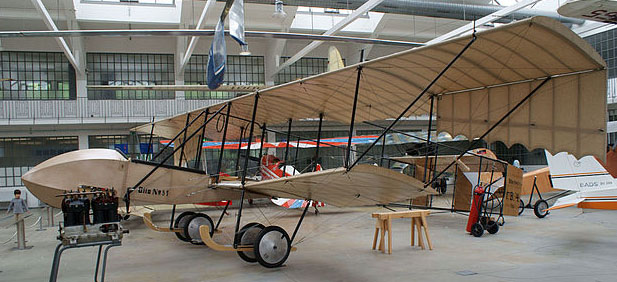
Otto Doppeldecker pusher N°8l at Flugwerft Schleißheim
Otto Doppeldecker Model B 1914

Otto Doppeldecker pusher N°8l at Flugwerft Schleißheim
http://flyingmachines.ru/Site2/Crafts/Craft29012.htm

AGO C.III 1915
AGO FlugzeugwerkeAktien Gesellschaft was preceded by Otto, or Aeroplanbau Gustav Otto & Alberti which was eventually taken over by the Government reorganized and run as Bayerische Flugzeugwerke AG, later to join BMW in 1922. AGO was the Berlin 1915 subsidiary, which became a major aircraft company, without the manufacturing and financial problems of Otto.

AGO Doppeldecker 1914
- AGO C.I & C.IW – pod and boom pusher reconnaissance biplane
- AGO C.II/W – pod and boom pusher reconnaissance biplane
- AGO C.III – pod and boom pusher reconnaissance biplane
- AGO C.IV – reconnaissance biplane
- AGO C.VII – reconnaissance biplane
- AGO C.VIII – reconnaissance biplane
- AGO DV.3 – fighter
- AGO S.I – prototype ground attack aircraft
- AGO Ao 192 Kurier – light liaison
- AGO Ao 225 – cancelled heavy fighter project
Read More/Sources
https://en.wikipedia.org/wiki/Otto_Flugmaschinenfabrik
https://en.wikipedia.org/wiki/AGO_Flugzeugwerke
Albatros
Albatros vs. Fokker
When asked to cite two WW1 German Planes, those who came to mind are immediately either Albatros or Fokker. So much they definitely printed their path in aviation history, as much as Zeppelin. However both companies were quite opposite in many way. Whereas the first made well-polished, very refined and innovative plywood wonders with inline engines in a coherent and homogeneous incremental path, very “German” in a way, so to speak, the second, Dutch in origin, was a bit more artistic and eclectic in its approach, testing many configurations, using mostly radial engines, preferring large productions of simpler models and leaning towards a “pilots plane” hands on approach rather than the colder, more scientific, engineer’s dream approach of Albatros.
But both were complementary, and both equally cleaned the sky of any entente competition. Only because they were less in numbers and less visible in the press, Albatros didn’t carved its path shining as Fokker, but the company delivered nonetheless a long lineage of excellent fighters that shaped the industry by their very modern and innovative approach, hell-bent on aerodynamic efficiency.
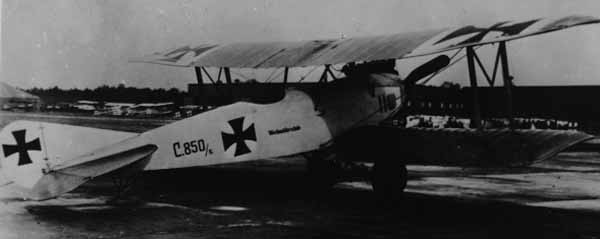
The C.IV was a prototype made in-between early production types, sharing most parts with the C.III, but changed the design of the wings and cockpit, with the position of the observer and pilots swapped, not a satisfactory solution as it was found.
Albatros-Flugzeugwerke GmbH was funded in 1909, in Berlin, by Walter Huth and Otto Wiener, with its facilities based in Johannisthal. The company had a subsidiary, Ostdeutsche Albatros Werke (OAW)). Not only it produced about 10,000 aircrafts but also some of the finest fighters of World War I. The parised Albatros D.III and Albatros D.V, were both untouchable when in service and ruled the skies without opposition for a time. Both had been designed by Robert Thelen.
Such was its reputation that Albatros went on after the war until 1931, before merged into Focke-Wulf. The company first product was a licensed production of the French Antoinette, a popular sports monoplane. Soon the company licence-built its own version of the prolific Etrich Taube, and derived a biplane from it in 1910, called Albatros Doppeltaube. In 1912, Albatros built and tested five Albatros F-2 (modified French Farman IIIs) fitted with an Argus in-line engine.
Four went to Bulgaria and fought in the Balkan wars of 1912-1913. The first production model of the company was, understandably, not a fighter but an observation plane, the Albatros B.I, according to the accepted national nomenclature, which saw a small production in 1913. It was followed by the B.II (1914) and III (1917), and also in 1914 the company started the long lineage of its multi-purpose C models (C.I to C.XV). The last from 1918 were twice faster and more powerful, still standard biplanes with inline water-cooled engines.
Basically they all shared the same plywood construction fuselage, finely shaped, and were agile and sturdy twin-seats armed with a forward firing 7.92 mm (.312 in) Spandau LMG 08/15 machine gun and observer’s rail-mounted 7.92 mm (.312 in) Parabellum MG14 machine gun. The most produced were the C.V (400) and C.VII (600) followed by the C.X (300).

The Albatros C.IX was an interesting development of reconnaissance planes powered by a Mercedes D.III Inline piston engine, 118 kW (158 hp) for a 155 km/h (96 mph; 84 kn) top speed. It had a swept top wing, without central strut mated to fuselage. Three were built for testings, one was Manfred Von Richtofen’s own personal transport plane to see the Kaiser in 1917.
But of course Albatros is best remembered by its fighters. Driven by the same desire to improve on aerodynamics, but the company started relatively late in the game, delivering the D.I in 1916. The serie would go on until the end of the war and before the Albatros D.XI was operational, always using the same formula and little changes in the wings and tail shapes or structure. The absolute best sellers became the legendary D.III (1866 built), D.V (More than 2500) while other intermediate models remained mostly as incremental prototypes.
But in 1917 just like its nemesis, Fokker, the company embarked in the promising triplane bandwagon and delivered the Albatros Dr.I and II prototypes, without attracting any orders. The company also in 1916 delivered three of the G light bomber series, and in 1917 two of the ground-attack J series and floatplanes for the navy with the three W series.

Albatros C.XIV the only fighter-attempt in the C-serie. This was indeed the only Albatros fighter made with a two bay layout, flat sided fuselage. It was propelled by a Benz Bz.IVa 6-cylinder water-cooled inline, 160 kW (220 hp), so speed would have not been its strong point.
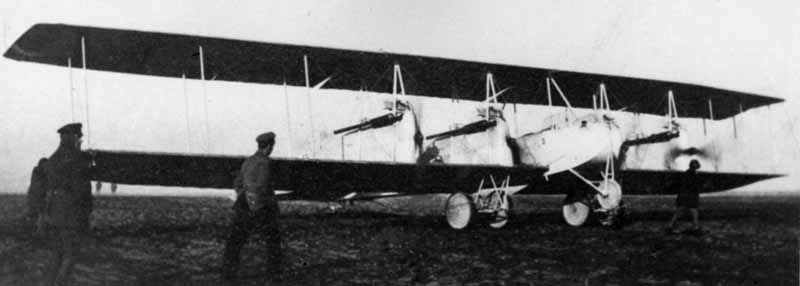
Albatros is certainly not as well known for its heavy bombers. The only attempt was designed by Otto Wiener and Dr. Walter Huth at Ostdeutsche Albatroswerke G.m.b.H., Schneidemühl from a request to copy the Russian Ilya Murometz. It was first flown on 31 January 1916 by Alexander Hipleh, showed poor flying qualities and performances. The next G.II and G.III were in no way related it, being lighter twin-engined planes.
Models
As usual like the other pages, this list comprised prototypes or very short series which will not be seen in detail, and production ones, expressed in bold. Production figures are ellusive.
US Army Signal Corps, Albatros Manufacture Production archive
- Albatros Taube (1910) (40)
- Albatros Doppeltaube (1911) (60)
- Albatros F-2 (5)
- Albatros B.I (1913) (300?)
- Albatros B.II (1914) (approx. 4,900?)*
- Albatros B.III (1917) (200?)
- Albatros C.I (1915) (50?)
- Albatros C.II (1915) (1)
- Albatros C.III (1915) (2271)
- Albatros C.IV (1916) (1)
- Albatros C.V (1916) (400)
- Albatros C.VII (1917) (600)
- Albatros C.IX (1917) (3)
- Albatros C.X (1917) (300)
- Albatros C.XII (1917) (50?)
- Albatros C.XIV fighter (1917) (1)
- Albatros C.XV (1918) (50?)
- Albatros D.I (1916) (50)
- Albatros D.II (1916) (291)
- Albatros D.III (1916) (1866)
- Albatros D.IV (1917) (3)
- Albatros D.V (1917) (2500)
- Albatros D.VI (1917) (1)
- Albatros D.VII (1917) (1)
- Albatros D.VIII (1918) (paper project)
- Albatros D.IX (1918) (1)
- Albatros D.X (1918) (2)
- Albatros D.XII (1918) (2)
- Albatros Dr.I (1917) (1 prototype)
- Albatros Dr.II (1917) (1 prototype)
- Albatros G.I (1916) (1)
- Albatros G.II (1916) (1)
- Albatros G.III (1916) (15?)
- Albatros J.I (1917) (240)
- Albatros J.II (1918) (?50)
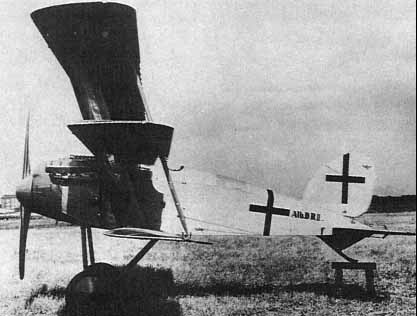 Albatros Dr.II
Albatros Dr.II
Albatros Taube (1910)

A photo of the rare Albatros Taube A23/13 (Europeana coll. src). The current plane was shot uring a North Sea coast mession started at Ostend. The engine was fired upon and shut down, after which the plane started a glide flight to Zeeland; it has made an emergency landing at Oostburg and is therefore the very first German planes captured, on 20-08-1914 in the Netherlands (Oostburg); The aviator was Leutnant Hans Hesse. The aircraft was confiscated, well guarded and housed in one hangar in Oostburg; the aircraft was handed over to the fledgling Aviation Department, which consisted of a mixed bag of captured aircraft; that is why it was transferred to Soesterberg, transported but found unusable for the LVA. The German pilot was interned, but as a gesture of “good relations” was soon offered to return home
Dr. Igo Etrich (Igo Etrich) believed that the right flying wing deisgn and three axes control were the future of aviation. To solve the problem of a light and durable wing to carry ailerons was solved by Etrich by transverse control using wing warping. He borrowed the idea of the inclination and wing shaped from the seed of the tropical palm Zanonia macrocarpa. But the plane was soon nicknamed “Taube” (Dove) and it stuck. ironically the dove, associated with peace in Europe, became the first german warplane. The first Taube was built in 1909, made successful tests and the production started the following year while after some controversy about copyright, and licencing, the model was made free of charge. Albatros Werke soon take on the task of building a serie of planes imitating the model. This early plane was under fine-tuning by an engineer from company Furnier, therefore often the plane was called Furnier-Taube or Albatros FT. in 1911 this was a purely sport plane with a plywood fuselage and significant design differences from the basic design, Albatros were proud of.
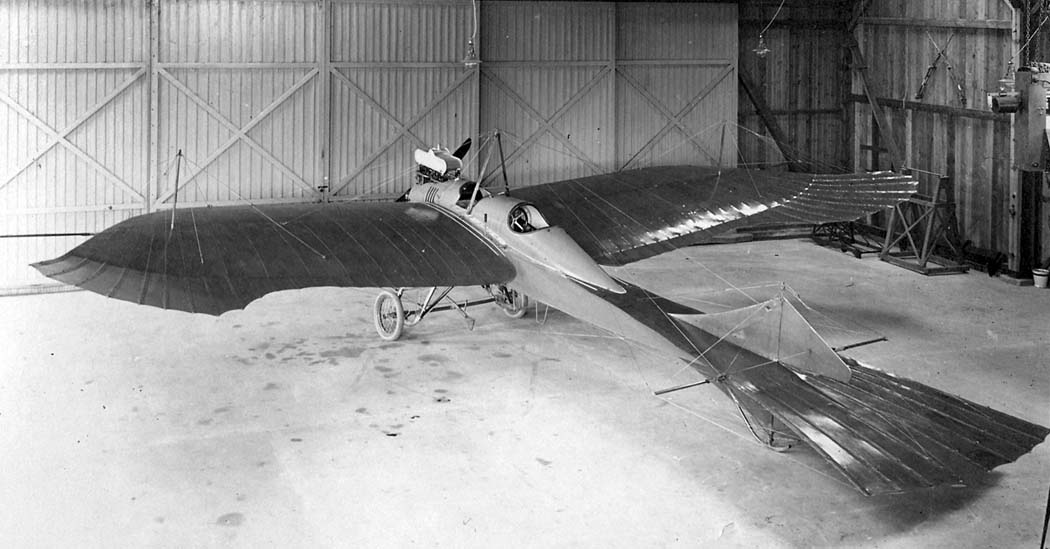
In 1913, Albatros Werke GmbH acquired the license for the production of Taube and began the serial production of the Albatros Taube (sometimes “Taube II”) used later as a sports and training aircraft, also used for reconnaissance and bombing. The same year, the specialized military version Taube EE received a Mercedes D.I engine, 100 liters, 75 kW. The Taube EE took part in the early War as training aircraft, reconnaissance aircraft sometimes making strafing attacks with small bombs and grenades. In total, more than 40 Albatros Taube EE were produced. Largely outdated by 1914, some already encountered enemy planes and have experimented with steel arrows at enemy targets, but this was not a success.
Albatros DoppelTaube (1911)

The Albatros Doppeltaube (here tested at Johannistal).
In 1909, engineer Igo Etrich (Igo Etrich) built a Taube monoplane with warp control over wings using a dove-like profile. Very famous in Germany, the Army soon saw its potential and ordered the licence was first transferred to Rumpler, before he decided to abandon the copyright to the project. Albatros, DFW, Gotha, Halberstadt, Jeannin, Kondor, Krieger, LVG and Lubeck-Travemunde immediately jumped in the bandwagon and launched their own mass production. Therefore the Taube was the most current German aircraft in service in 1914. Albatros Werke Gmbh had already built their own Albatros EE (Eindecker), and thought about creating a training aircraft with better maneuverability. The decision was then made to to turn the monoplane into a biplane.
As a result, in 1911, several copies of the aircraft, designated Doppeltaube (Double Dove), were built. This model was equipped with an Argus As.I engine rated for 100 hp. Its Maximum speed was 75 kph, and cruising speed 60 kph. It was a sesquiplane with the lower wing still using the same design, but less pronounced. The solid wheeltrain (two pairs of roadwheels) was doubled by landing skis. The Doppeltaube had the reputaion of a slow but stable and reliable aicraft, well suited to the job. In January 1912, the Doppeltaube was shown to the public at the Paris Air Show. Several were purchased by the military under the designation MZ.1 (Militär Zweidecker), which caused confusion with another MZ.1 (training aircraft built by Albatros based on Farman biplane). Its Wingspan was 13.20m, Length 10.58m, Height 3.70m and Wing area 40.88 m2. It was unarmed, and used until 1915 and declared obsolete.
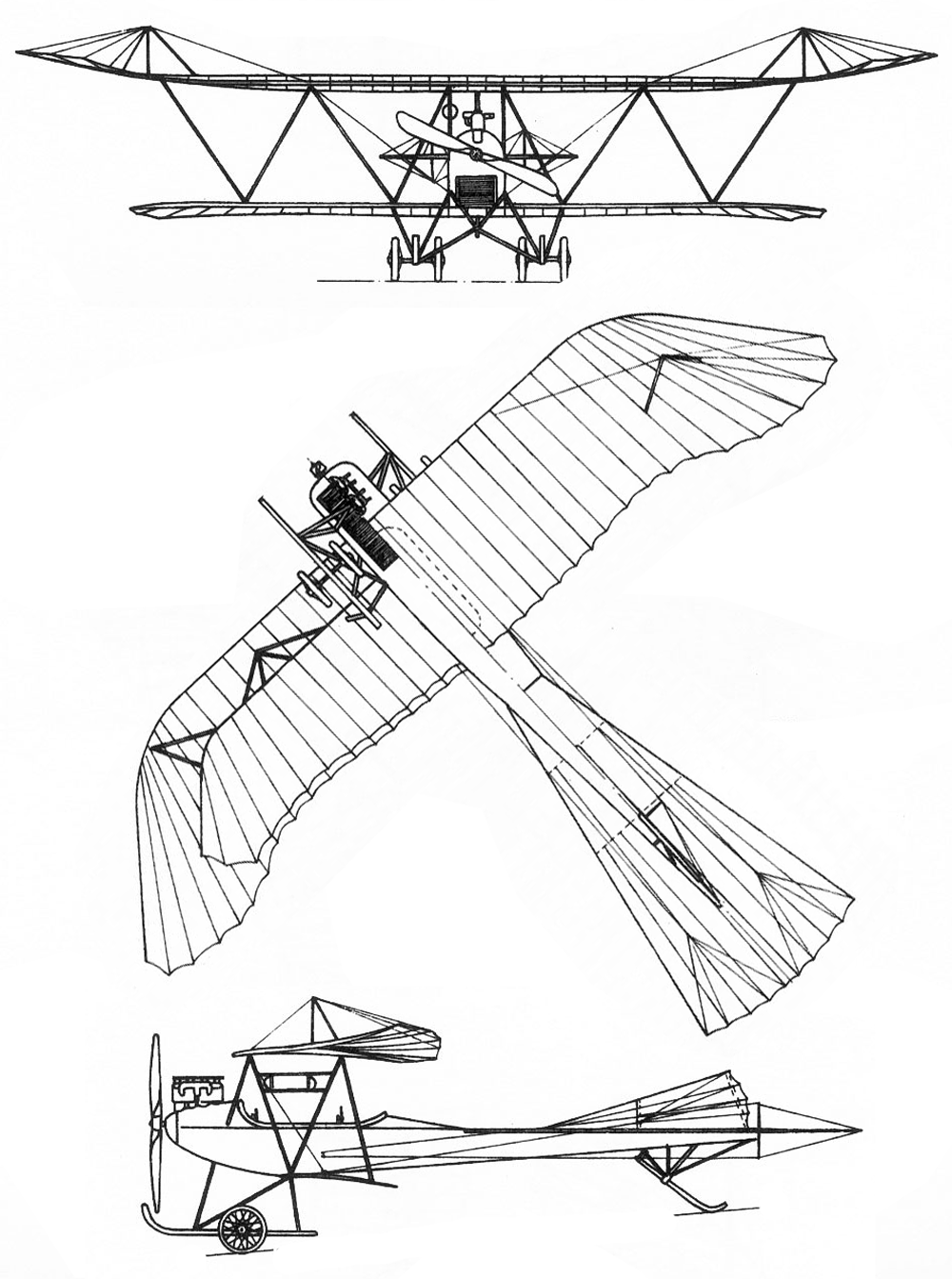
Read more/Sources
https://en.wikipedia.org/wiki/Albatros_Flugzeugwerke
http://jn.passieux.free.fr/html/AlbatrosCI.php
http://www.wingnutwings.com/ww/product?productid=3149
http://chezpeps.free.fr/musee/modelflight-01/1903-06.htm
https://www.militaryfactory.com/aircraft/ww1-german-military-aircraft.asp
https://forum.axishistory.com/download/file.php?id=5948&sid=9b0c65d8924aec47e4c0526c929fe170
DFW – Deutsche Flugzeug-Werke

DFW C.Vc (wikimedia commons)
Deutsche Flugzeug-Werke, usually known as DFW was a German aircraft manufacturer of the early twentieth century. It was established by Bernhard Meyer and Erich Thiele at Lindenthal in 1910, and initially produced Farman designs under licence, later moving on to the Etrich Taube and eventually to its own designs. One of these, the DFW C.V reconnaissance aircraft, was produced to the extent of several thousand machines, including licence production by other firms. Plans to develop civil aircraft after the war proved fruitless, and the company was bought by ATG shortly thereafter.
The DFW Mars (from the Roman god of War) was a pure military monoplane designed in 1912 and first flying in 1913, the only alternative to the Taube at the beginning of the war. It was built in larges series and was characterized by the fact the same fuselage could be adapted to monoplane and biplane configurations. A biplane variant also flew of this model. Therefore they were known as “DFW Mars E” and “Mars D”. These two-seaters also served for liaison, but thy were unarmed reconnaissance aircrafts.
The DFW B.I was on of the numerous unarmed “B-types” used for observation over the Western front in 1914. This was a conventional two-bay, two-seat biplane powered by a Mercedes D.I 6-cylinder water-cooled in-line piston engine rated for 75 kW (100 hp). Production records are unknown. The B.II built as a trainer, fitted with the more powerful Mercedes D.II engine. By the fall of 1915 the B type was declared obsolete and replaced by the C type. The armed DFW C.I was basically the same, but with the crescent-shaped wings, replaced by straight leading edges. On the next C.II, the observer and pilot seats were swapped. On the rear seat, the observer could man a scarff-mounted 8mm Parabellum MG14 machine gun. It was also a bit faster with a Benz Bz.III rated for 112 kW (150 hp). There was a C.III, but only on paper. The serie leaped directly forwards to the mass-produced C.IV, a preserie for the C.V, perhaps the best “product” of the company and also the largest production of a reconnaissance C type of WW1 (see later). It was produced until 1918 also by Aviatik, Halberstadt, LVG, and Schütte-Lanz.

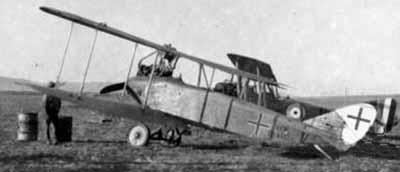


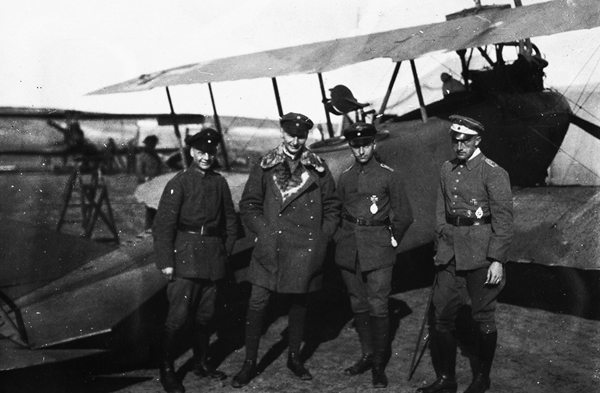
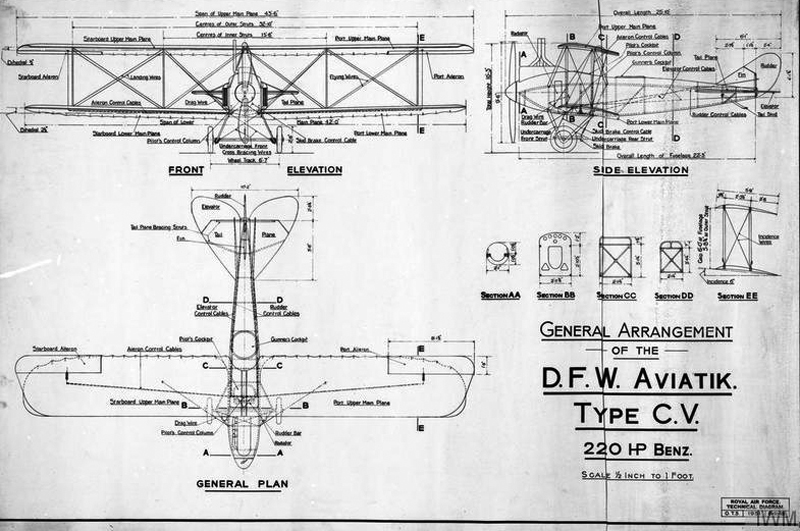
photos of the DFW C.V. Banking, captured at Afule in 1918, with crew and officers in Ukraine 1918, and blueprint
The D series, or DFW fighters remained at the prototype stage. The only attempt by DFW to enter this prestigious division was not met with success. The planes were not bad in 1918, but did not offered significant advantages over the competition, both in speed and agility. The D.F.W. D I was a 1917 prototype with ply-covered fuselage and car-type radiator at nose for its 160 h.p. Mercedes D III engine. It was relatively slow because of the drag and offered little forward visibility for the pilot.
As a result it was not accepted and send back to be modified with a larger rudder and a 160 h.p. Mercedes D III with modified cooling. Both were armed with twin Spandau machine-guns cowl-mounted and synchronized. But its still did not offered considerable advantages and was modified again, revision of the tail surfaces and lower wingtips ailerons deleted. It was tried at Adlershof in January 1918, but again; was not considered worth for production. The next “D.II” was in reality factory-called F 34 and was completed April 1918 as a private venture.
That’s why the designation D.II should not apply. It had the same 160 h.p. Mercedes D III engine a 9.08 m. (29 ft. 9 1/2 in.) wingspan and 23 sq.m. (248.4 sq.ft.) total wing area, was 5.5 m. (18 ft. 0 5/8 in.) long .and could reach 177 km.hr. (110.5 m.p.h.). and climb at 1000 m in 2 min or five more time in 20 min. These were not impressive figures by 1918 so the model was not chosen for production.
The Experimental D.I which flew in 1917 but was modified two times. The F 34 was very close but was never ordered either.
The The DFW Dr.I was the sole attempt to design a super-agile fighter, following the success of the Fokker. The company took the shortest path to have one presented to the Idflieg in time, converting their F.34 model to a triplane to be ready for the competition at Adlershof under the factory name of F.34-II in January 1918. This D types had the same 160 h.p. Mercedes D III engine twin Spandau machine-guns. But it competed against the rotary-powered Euler Dr I, 185hp Austro-Daimler powered Hansa-Brandenburg L 16 and Korting-engined DFW Dr I, with little success. That was the end of the fighter adventure for DFW.
The The DFW F 37 was another private venture as a late reconnaissance model. It was a development of the C.VI, itself a single sturdier prototype with modified ailerons, followed by three aircraft designated F37 in 1918 pending the Idflieg designation DFW C.VII to enter competition. It was never ordered in production.The DFW F37 was modified after the war with the 220 kW (295.02 hp) BMW IV engine (as DFW 37-III) and broke the world altitude record in 1919 (7,700 m (25,262.47 ft)), never recognized by the FAI because of the breach of the Versailles treaty. Back with its former engine, the F37 became a passenger “flying limousine”, called DFW P1 Limousine, showcased at ELTA exhibition in Amsterdam in 1919.
The Experimental T.34-II/Dr.I flew in 1918 at Adlershof.
DFW also ventured into heavy bombers (R types), to support the blitz over Great Britain and especially London, the industrial hub of the Empire, an answer to the naval blockade. The R.I was a sold prototype, private venture of a was a large biplane, with four engines inside the fuselage and transmission shafts for the propellers in tractor (upper wing, leading edge) and pusher on the lower wing (trailing edge).
Internal engines were not neew but apparently these engines drove a separate propeller each instead of being connected to the other engines. The R.I started trials on 19 October 1916, purchased by the Luftstreitkräfte but it was terribly disappointing as the crankshafts repeatedly broke or failed. New engine mountings and universal joints were fitted and extended wings. Once modified, the R.I (R 11/15) was sent on the Eastern front, flying with the Rfa 500 squadron based at Alt-Auz, from April 1917 to September 1917. It raided Riga once during the summer of 1917 but crashed due to the failure of two engines on the second trip.
The next R.II was developed based on the experience of the R.I at the request of the Luftstreitkräfte. But they asked for a better payload, of 3,400 kg (7,500 lb), compared to the 2600 kg carried by the R.I. The same arrangement of four inline engines in the fuselage and tractor/pusher propellers via long driveshaft was retained and the first R.II flew in August 1918. Again, it showed problems with the driveshafts and excessive vibration. Therefore these systems were enclosed within steel tubesand soon the new Mercedes D.IVa engines were fitted.
However again the shafts vibrated up to 3000 rpm and bearings were fitted; and later Reduction gears to keep them to 900 rpm. Six were ordered by the Luftstreitkräfte, but two were completed before the end of the war, based at Cologne for training. After the war, a short-lived passenger version was planned but never executed. The improved R.III bomber also existed on paper only.
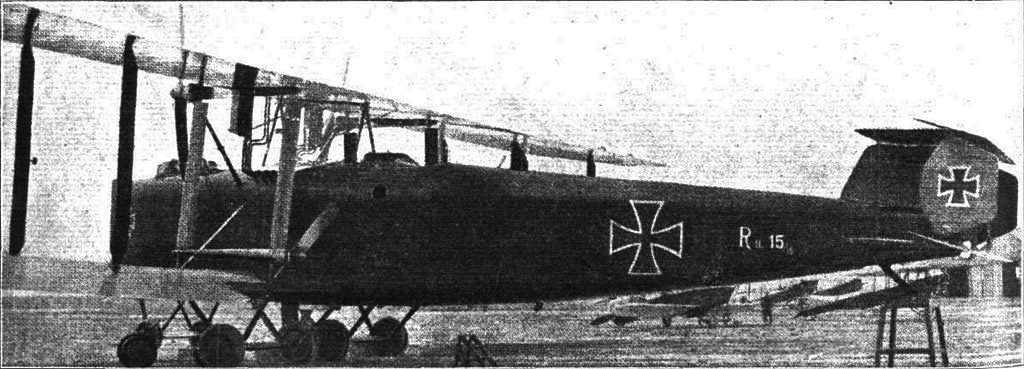
The Experimental R.II in 1918, before bein sent in Cologne (Köln) for training.
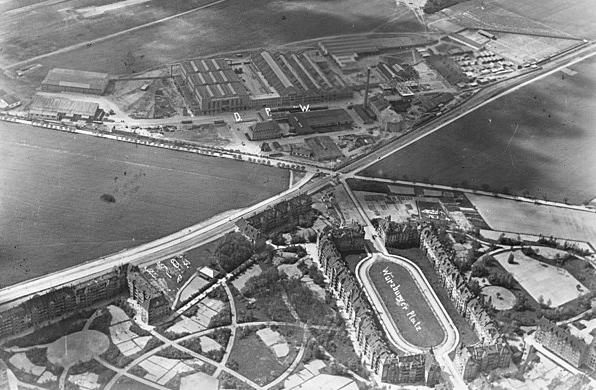
The DFW Factory after the war (wikimedia commons)
- DFW Mars 1913- reconnaissance (c100)
- DFW B.I/II 1914- reconnaissance (c250)
- DFW C.I/II 1915- reconnaissance (c800)
- DFW C.IV/V/VI 1916- reconnaissance (3250)
- DFW D.I 1917- fighter (1)
- DFW F 34 (D.II) 1918- fighter (1)
- DFW F 34-II (Dr.I) 1918- triplane fighter (1)
- DFW F 37 1918- reconnaissance (3)
- DFW R.I 1916- heavy bomber (1)
- DFW R.II 1918- heavy bomber (2)
- DFW R.III 1918- cancelled heavy bomber
- DFW T.28 Floh – fighter prototype (1)
Read more/Sources
DFW on wikipedia
About the DFW R.IV
Euler-Werke
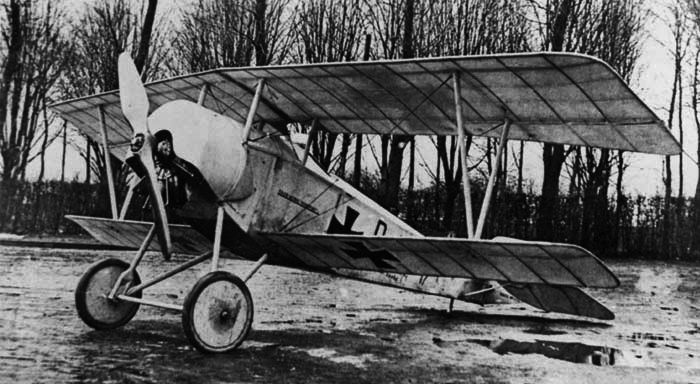
Euler .II (wikimedia commons)
Euler, born in Westphalia and educated at Oelde and in Aachen started an engineering carrer in 1885, for Seidel & Neumann, a sewing machine company. Later the company turned to cycles and motor cars. Euler himself took over the cycle racing and later motor racing activities, which bring him to aviation. In January 1908 he settled a workshop at Mainz castle to produced licenced-built Voisins. In February he created a 2,400 Marks factory at Griesheim Airport and started large scale aircraft production. He won in 1910 the longest flight at 3hr 6min. 18sec and obtained the first German Pilot’s brevet while creating his own flying school. He moved his factory to Frankfurt and joined the newly formed German aircraft manufacturers’ association. After the war Euler became Secretary of State for Air and created the ministry for transportation, and after the Versailles treaty was ratified in 1920 he resigned.
Euler models
The first model from Euler was a private venture outside any order, prewar. It flew in exhibitions and was soon noted for its excellent performances, and praised by Oskar Ursinus (of the german magazine Flugsport) for its aesthetics to match. This civilian sport model was later developed into the Euler B.I in wartime, tested and adopted by the German Army. The Euler B.I was its official Idflieg designations, and the company manufactured 6 according to a photo, another showing a row under construction. The next Euler B II produced at the end of 1914 was a different plane, a close copy of the L.V.G. Instead of a tricycle undercarriage it had a standard one, and a 100 h.p. Mercedes D I inline engine capable of carrying the plane up to 120 kph (75 m.p.h.) and climb at 3.000 m (9,840 ft.) in 29 minutes, for 4 hours of autonomy. The Euler B.II Weighted 757/1,172 kg. empty and loaded. The next Euler B.III was built in 1918 for training as a licence-built L.V.G. B.III, but with a considerable stagger, and a 120 h.p. Mercedes D II. engine. Production unknown. Another prewar model (1913) was the Euler Hydro-Triplane a pusher configuration amphibious triplane flying boat featured in the French magazine L’Aérophile. It was propelled by a 70 hp engine Gnome engine, and was made famous also by the Magazine Flight as the best of its kind, this time motorized with a 100 hp (75 kW), nine cylinder Gnome Delta rotary engine. It was remarkably the first true amphibian, with the mainwheels placed on the upper and lower pairs of struts. But it was never used by the Military.
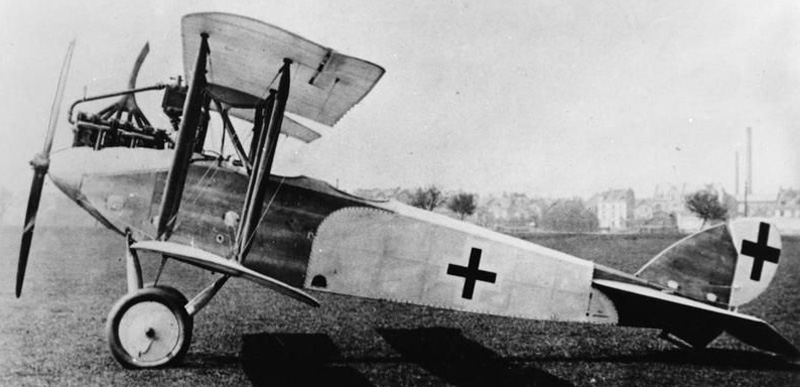
Euler B.II (IWM)
The Euler D.I was a single-seat biplane fighter closely based on the French Nieuport 17. After seeing the success of the French fighter, German designer August Euler start working on a German version on this design. The Euler D.I first flew in late 1916 powered by an 80 hp engine and single synchronized machine gun on the front. The two prototypes were in frontline service by October 1916, and after excellent results, 50 were ordered the same month, and 50 more in early 1917, largely transferred over to the Euler D.II. However being late in the game and few in numbers, the D.I was relegated as an advanced fighter trainer until the war’s end. The Euler D.II was a German single-seat fighter, the successor to the earlier Euler D.I. The D.II was essentially a re-engined Euler D.I, the air-frame being virtually unchanged and the power plant being a 100 hp Oberusel U I seven cylinder rotary. Thirty were delivered to the German air force in March 1917, but due to slow production they delivered up to December 1917 and it was seen as obsolete and relegated to the role of a trainer for the remainder of the war.

Euler D.III (pinterest)
Little information is available on the model C. The Dr.I series however was largely an experimental triplane serie of fighters. The Euler Dr 1 was powered with a 160 h.p. Oberursel U III engine but apparently stayed at prototype stage. The Dr 2 was another prototype, powered with a 160 h.p. Mercedes D III engine and the next Dr.3 was a development of the latter, fitted with a 100 h.p. Oberursel U I engine. The last one, Dr.4, emerged in 1916 and was ungainly and only intended for training. It featured side-by-side seats and was propelled by a 220 h.p. Mercedes D IV with reduction gears. None of these designations were official since none was accepted for service. All of these were designed by Julius Hromadnik, the first being under test in the summer of 1917. Competitors were the Hansa-Brandenburg Dr.I and DFW Dr I. It seems the 1918 Pusher Einsitzer (single seat) “Gelber Hund” (yellow hound) lacks any clear information. The “Vierdecker” was a unique experimental quadriplane version fighter.
- Euler B.I reconnaissance 1914 (6)
- Euler B.II reconnaissance tractor 1915 (c50)
- Euler B.III trainer 1918 (?)
- Euler C reconnaissance pusher 1914 (?)
- Euler D.I fighter 1917 (c75)
- Euler D.II fighter 1917 (c30)
- Euler D.III fighter 1917 (?)
- Euler Dr.I – triplane fighter 1917 (1)
- Euler Dr.II – triplane fighter 1917 (1)
- Euler Dr.III – triplane fighter 1917 (1)
- Euler Dr.IV – triplane trainer 1918 (1)
- Euler Dr.V – triplane project 1918 (1)
- Euler Pusher Einsitzer fighter 1918 (1)
- Euler Vierdecker (Quadruplane) fighter 1918 (1)
Read more/Sources
https://en.wikipedia.org/wiki/Euler_D.I
https://en.wikipedia.org/wiki/Euler_D.II
Erich Taube
The first German war planes
The Etrich Taube was in practice the first largely available plane to the german Military when the war broke out in August 1914. The plane itself would vary in design, and be named after several manufacturers, such as the Rumpler Taube, first military aeroplane mass-produced in Germany. This very popular monoplanebefore the war was also used by Italy and Austria-Hungary and tested once by the Royal Flying Corps. A Taube became in 1911 the first ad how bomber over Libya.
From 1914 onwards the Taube was used at best for the first few monthes before it was realized how old the design was and iits limitation under these new conditions became apparent. The type was replaced relatively quickly but left its mark at least until the winter of 1914. The first pistol and rifle aerial duels happened from Taube planes, against French Bleriot XII and others of these early models.
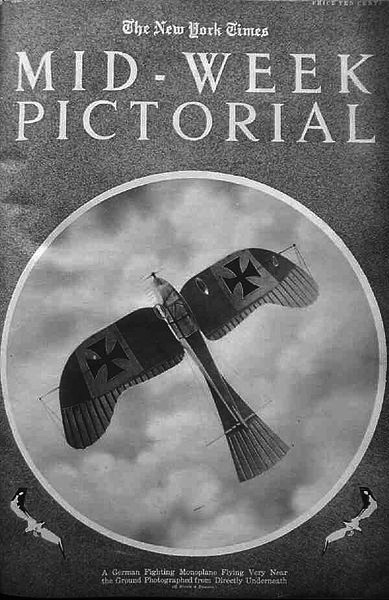
A 1909 design
Just like the Blériot XII, the Taube was of the same generation of sportsmen, engineers, daredevil adventurers which pioneered aviation. By then the monoplane configuration was the most “natural” one and was widespread. But the irony was this design was not German, but Austro-Hungarian, by Igo Etrich in 1909. The Taube (“dove”) first flew in 1910. This model was directly inspired by the many gliders that followed otto Lilienthal early grounbreaking works in aerodynamics and primitive controls. However despite its name, the wings shape was in reality modelled after a particular seed, of Alsomitra macrocarpa, which can flew quite great distances from the mother tree. Karl Jatho and Frederick Handley Page also worked on similar “natural” shapes.
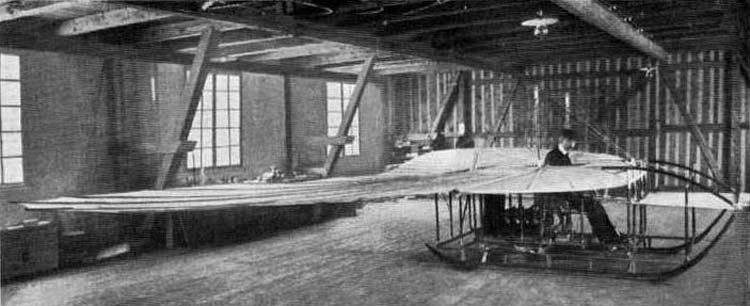
Etrich-Wels glider prototype
About the plane
The wing has three spars and was braced by a steel tube truss (Brücke) under each wing. The uprights ends of this structure rose above the upper wing surfaces to carry bracing and warping wires for the enlarged wingtips. Etrich also added to his model the crosswind-capable main landing gear developed by Blériot. In addition there was sometimes a small landing wheel mounted under both kingposts to prevent damages in case of rough landings.
Later models adopted a simpler V-strut main gear format. For the sake of production simplification and aerodynamic efficiency, the underwing “bridges” were also often omitted. Wing warping was used for roll control as well as the rear half of the stabilizer for elevation control. Twinned triangular rudder surfaces however were hinged. The Taube was inherently a stable platform, ideal for observation and the thin, somewhat translucent wings made it difficult to spot above 400 meters, its usual service ceiling.
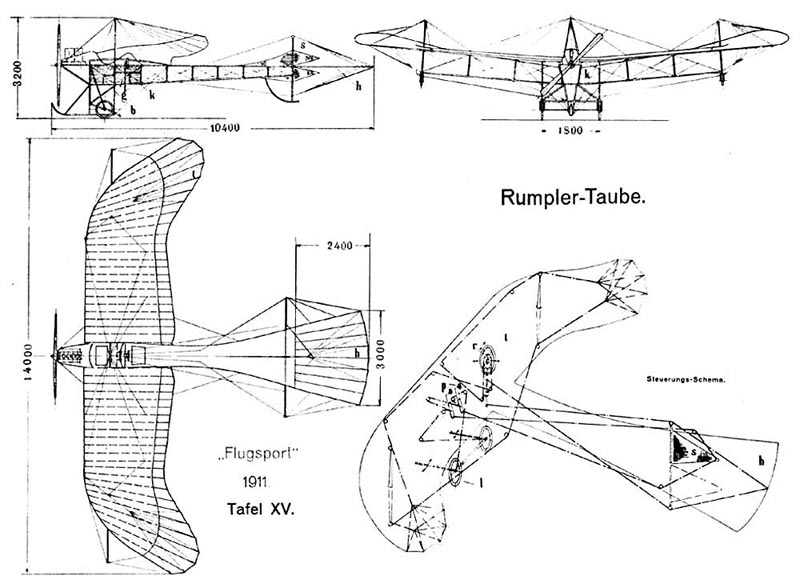
Rumpler-Taube general design. This was the most common version
Manufacturers (Variants)
Outside Germany, the Taube was also used by Austro-Hungary and Italy as indicated before, but also Turkey, China, Japan, Norway, Switzerland, Argentina, and Bulgaria.
- Albatros Taube
- Albatros Doppeltaube (Biplane version)
- Aviatik Taube
- DFW Stahltaube (Stahltaube, with a steel frame)
- Etrich Taube
- Etrich-Rumpler-Taube (initial production in 1910)
- Gotha Taube (LE.1, LE.2 and LE.3)
- Harlan-Pfeil-Taube
- Halberstadt Taube III
- Jeannin Taube (Jeannin Stahltaube, steel tubing fuselage)
- Kondor Taube
- RFG Taube
- Roland Taube
- Rumpler Taube
- Rumpler Delfin-Taube (Rumpler Kabinentaube “Delfin”, with a closed cabin)
- Isobe Rumpler Taube (Captured, repicated in Japan)
Operational History
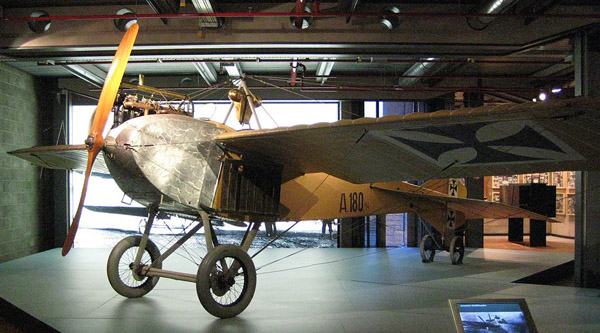
Jeannin Stahltaube, Technikmuseum Berlin
Before WW1, an Italian Taube bombed an enemy position in 1911 in Libya, dropping grenades. Taube were also used as bomber/observation planes in the Balkans war in 1912–13. Despite the initial reticence of the prussian old guard present in the general staff and high command, the Taube made quite an impression. One of these planes indeed detected the advancing Imperial Russian Army in East Prussia before the battle of Tannenberg took place.
Taube were the first, in the fall of 1914, to bomb Paris (or drop propaganda leaflets). Dozens of Taube flew everyday on every part of the front, and at first if pilots exchanged amiabilities when crossing each others, soon, pistols and rifles, or even grappling hooks and flechettes were exchanged… However the Taube was too slow and too stable to be a fighter.
This plane had poor rudder and lateral control and quickly became a very easy target for more modern Allied fighters. Just six months into the war, the Taube, used until then as an observation or surveillance plane, but also had oc fighter or Bomber, was removed from the front line and went to the rear to train pilots. Generations of future German aces made their teeth on this platform.
Ironically the first operational unit was not even on the Western front, but at Qingdao in China, near to German naval assets. The unique Rumpler Taube capable of flying was confronted to the Japanese there, with an eight aircrafts strong force. On October 2, 1914, Lieutenant Gunther Plüschow tried to attack Japanese warships and later took off to flew top secret documents to Shanghai, but made a force landing in Jiangsu instead.
Specifications:
-Length: 9.9 m (32 ft 6 in), Wingspan: 14.3 m (46 ft 11 in), Height: 3.2 m (10 ft 6 in), Wing area: 32.5 m2 (350 sq ft)
-Empty weight: 650 kg (1,433 lb), Gross weight: 850 kg (1,874 lb)
-Crew: 2
-Powerplant: 1 × Mercedes Typ E4F[12] 4-cyl. water-cooled piston engine, 64 kW (86 hp)
-Performances: Max speed: 100 km/h (62 mph; 54 kn), Range: 140 km (87 mi; 76 nmi), Service ceiling: 2,000 m (6,600 ft)
-Armament: Rifles, pistols and hand dropped bombs.
Fokker had two faces, it is remembered as a long-lived Dutch transportation company, but also during the first world war, Germany’s premium fighters manufacturers, which legendary models were flown by the best pilots of the era, imposing their domination over the western front and beyond.
Origins
This Dutch aircraft manufacturer took a very special place in aviation history. On its time, it was the largest, most successful aircraft manufacturer worldwide, living up to 1996 and meeting bankruptcy, but leaving an amazing imprint in many areas nonetheless. Interestingly enough, the company was founded in 1912 in Schwerin, Germany by Anthony Fokker, and for what we are concern for, moving to the Netherlands in 1919 to escape sanctions and convert back to the civilian market, dominating it completely in the 1920s and 1930s. Indeed the 1925 F.VIIa/3m trimotor passenger aircraft was used by 54 airline companies worldwide and got 40% of the American market in 1936.
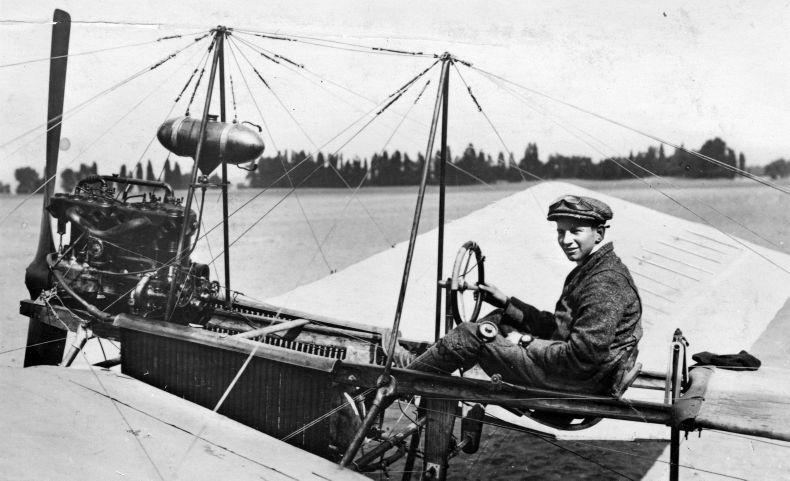
Anthony Fokker in his first Spin 1908
German Fokkers: Ruling the skies (1915-1918)
Anthony Fokker was Dutch but studied in Germany, well aware of the works of Lilienthal and others. He has created the Spin (spider) in the Netherlands, but found better opportunity and Germany and moved there. In Berlin he created the Fokker Aeroplanbau, later relocated southwest of Schwerin for more room, and eventually settled with Fokker Aviatik GmbH, on 12 February 1912. After a serie of Fokker Spin monoplanes tried by hte German government, he proposed an improved copy of the French Morane-Saulnier G which became the Fokker M.5. This monoplane was used for obervation with some modifications like the outline of the rudder, undercarriage and new aerofoil section.
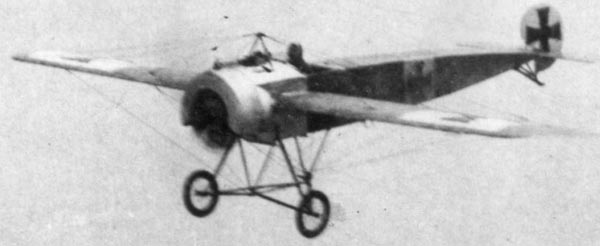 When it was realized observation planes already fought each other with any possible ways, Fokker quickly realized placing a machine-gun on the hood was the best solution, using the 1913 patented Swiss Franz Schneider synchronization system, way more practical and safer than Roland Garros own armoured propeller solution… Thus was born the first “Fokker scourge”, from July 1915 until early 1916. It was bring up by the famous Fokker Eindecker or “monoplane”. The first flew on 23 May 1915, it was a modified M.5 A.16/15 flown by Otto Parschau, and a total of 416 were built. The first tactics were devised with this plane, the first aces all flew it. Allies felt a strong inferiority complex from then on, until the arrival of the Nieuport 11 and Airco DH.2.
When it was realized observation planes already fought each other with any possible ways, Fokker quickly realized placing a machine-gun on the hood was the best solution, using the 1913 patented Swiss Franz Schneider synchronization system, way more practical and safer than Roland Garros own armoured propeller solution… Thus was born the first “Fokker scourge”, from July 1915 until early 1916. It was bring up by the famous Fokker Eindecker or “monoplane”. The first flew on 23 May 1915, it was a modified M.5 A.16/15 flown by Otto Parschau, and a total of 416 were built. The first tactics were devised with this plane, the first aces all flew it. Allies felt a strong inferiority complex from then on, until the arrival of the Nieuport 11 and Airco DH.2.

Fokker engineered another observation plane, single-bay sesquiplane two-seats built to around 20 powered by 60 kW (80 hp) Oberursel U.0 rotary engine, used by the Kaiserliche Marine and Austro-Hungaria. The Fokker A.1 also called M.8 was another observation plane, but two-seats monoplane developed in early 1915 which enjoyed better production. The next observation model was the M.10Z also used by Austro-Hungary under the name B.II. But the bulk of the production went to the E series, from the E.I to the E.IV.
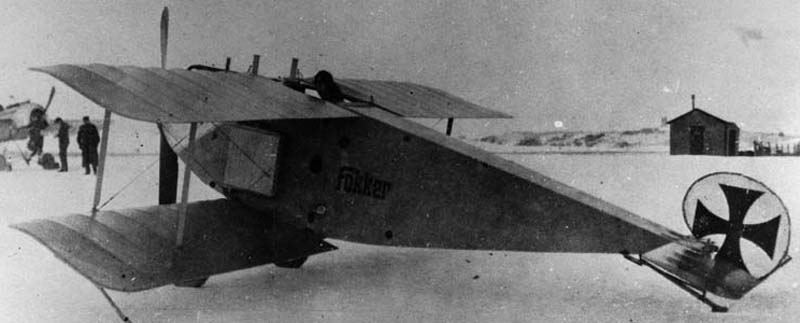
There was one attempt to devise a two-seat prototype with a particular fuselage linking both upper and lower wings, but a small production of the M.16Z took place for Austro-Hungary with the 119 kW (160 hp) Mercedes engine or Austro-Daimler. under the M.16E as the B.3. At least with the D.II Fokker unveiled a capable fighter biplane dervived from the B.7 in 1916 but having only a 75 kW (100 hp) Oberursel U.I meant it was slow and underpowered. The Army purchased 177.
The D.I was in the same vein, it was an unstaggered single-bay, or Einstielig equal-span biplane, using a more potent liquid-cooled Mercedes D.I six-cylinder in-line engine. But it was still not enough to best Nieuport 11, or at least being equal to the the Albatros D.II and production was stopped. The next Fokker D.II, III and IV had the same production but the D.V gave Anthony Fokker the best hopes. It was cheaper, lighter and smaller, but still lacked performances compared to the Albatros.
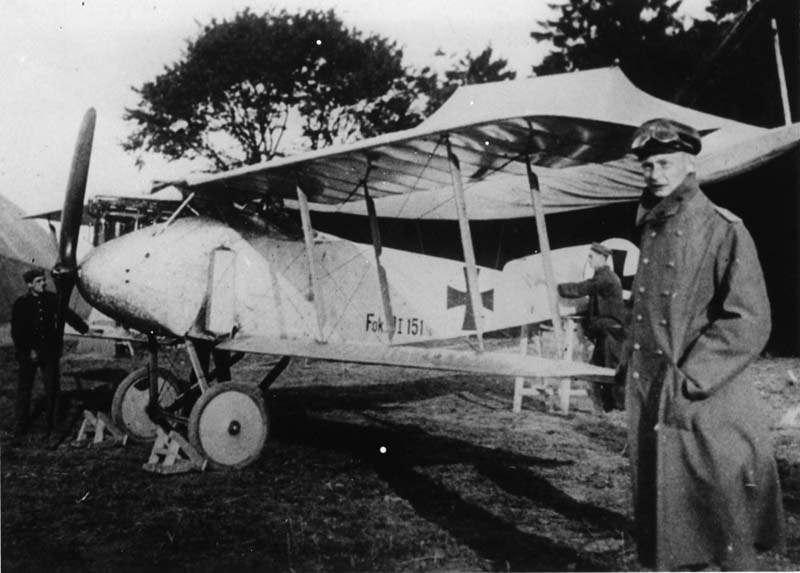
By early 1917 Fokker was in deep troubles. The army paid successive series of its D series, but performances were still not there to climb in the prized top best fighters a position lost since the E series. Even pilots were not impressed and preferred the Albatros and AEGs. But this phase left Fokker testing new solutions, and especially four prototypes, the second and third returning to the 89 kW (120 hp) Mercedes liquid-cooled inline engine, for better performances, and compensate for the engine weight, the center of gravity was placed further back, and the fuselage was circular in cross section, the wings being covered with plywood for extra rigidity. But both were still too slow to earn their fighter title. However for the Fokker V.4 this was a completely new start.

Perhaps short of ideas, Anthony Fokker decided to have a close look on the successful British Inspired by the successful Sopwith Triplane, just introduced. This time, Reinhold Platz was responsible for the design, and conceived around the small Oberusel a very light airframe with steel tubes inspired by Junkers’s work (The result of government-mandated collaboration) and there three cantilever wings, the upper one having a slightly larger span.
The rudder was balanced, but the ailerons and elevators lacked horn balances and at that stage there were no interplane struts. It was further developed as the F.I or V.5, an improved version with still lacked a subtle convex curve on the outlines of the tailplane’s leading edge platform. In fact three of these V.5 experimental serie were built, ending with the amazing Dr.I for “Dreidecker”. On 14 July 1917, Idflieg issued an order for 20 pre-production aircraft.
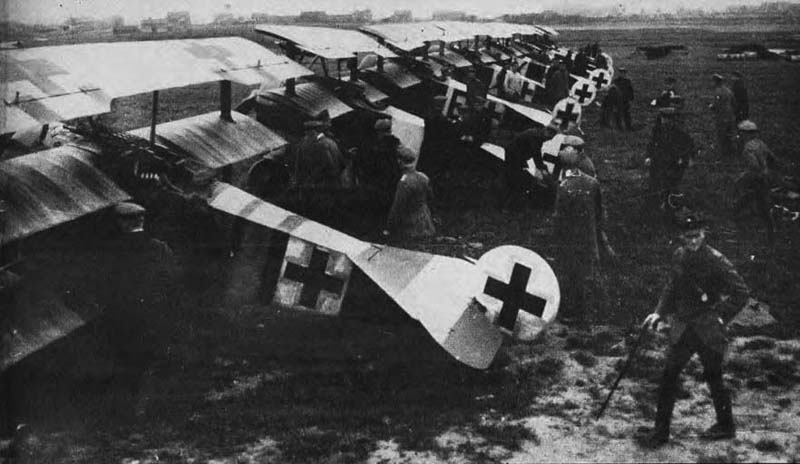
The Fokker Dr.I was the first return to an absolute winner since the infamous Eindecker. It was mid-1917 and the Dr.1 bring the company again in the first seat. But the fearful triplane, soon made legendary by some aces for its unreal, impossible feats of agility took some time to reach this level, in the end of 1917. From then on, the Dr.1 dominated the skies over Europe, largely contributed to the second allied eclipse. Richthofen first flew the preserie F1 number 102 on 1 September 1917 and all only praised for it. It was introduced in Jasta 10 ad 11 but on 15 September Leutnant Werner Voss was killed in one of the most earth-shaking last stand and dogfight in history.
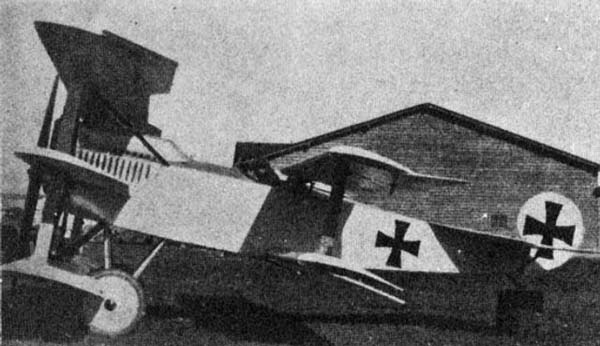
Above: The V.8 was an attempt to devise a “Quintuplane”, a five-wings variant which shocked Reinhold Platz, chief engineer for Fokker, which designed it, partly made of the V.6 and it was powered by a 120 hp (90 kW) water-cooled Mercedes engine. Anthony tested it despite Platz objections, which only confirmed his early opinion and the whole project was abandoned, later qualified as a monstrosity. What followed was a serie of experimental aircrafts using the same Dr.I cell but various engine and wings configurations. The serie comprised the V.9, V.11, V.12, V.13. V.14, V.16. The last V.33 development from the V.9 with both 82 kW (110 hp) and 108 kW (145 hp) Oberursel engines. All these prepared the ground for the arrival of the D.VI, a brand new biplane fighter.
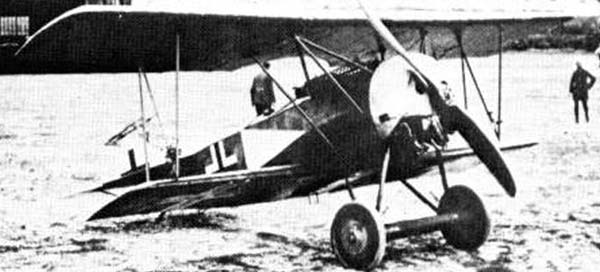
This model, which was soon eclipsed by the next fighter was developed from the prototype serie V.13. The idea was to marry the scaled-down D.VII wings with both the fuselage and empennage of the Dr.I. two prototypes with different engines were presented at the Adlershof fighter trials in late January 1918, and it was approved on the ground it was cheaper than the model VII and certainly the best of the rotary engine models. In fact only a token production of 59 was done, the Idflieg waiting for the more powerful Goebel Goe.III to arrive. Meanwhile, the new plane has to make due with the old Oberursel Ur.II. Deliveries lasted from April to August 1918, but the small biplane stood no chance. What followed were the Fokker V17-25 prototypes, cantilever mid-winged fighter and assimilated features.
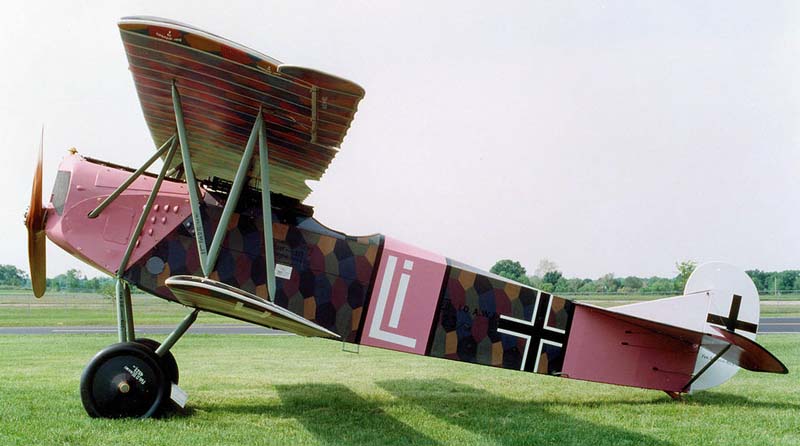
The Fokker D.VIII was the last wartime fighter, a parasol fighter which first flew in May 1918. About 380 were built until the end of the war, but in fact few made it on the front. They had been designed based on the V.26 and V.28, with steel-tube fuselages and Obersusel radial engines, rated for 150 and 160 hp. In fact they were quite agile and small, therefore quite fast, only beaten by a feeble margin by the more powerful and costly Siemens-Schuckert D.III using a complex bi-rotary Siemens-Halske Sh.III engine.
Introduction started in late July with Jasta 6 in late July and August-September for the Jasta 1, Jasta 19, Jasta 24 and Jasta 36. Until November they filled impressive hunt boards despite wing failures and rushed construction problems. After the war many made it in the Royal Netherlands Air Force and other foughts with Polish pilots in 1920.
The next V27 prototype fighters testes liquid-cooled Benz engines, while the V37 had additional armour-plating to be used as a ground-attack variant. The last production model was the large Fokker C.I, a two-seats, enlarged version of the D.VII fighter. About 250 were made until the last day of the war, largely used after it with the Dutch and Danish aviations.
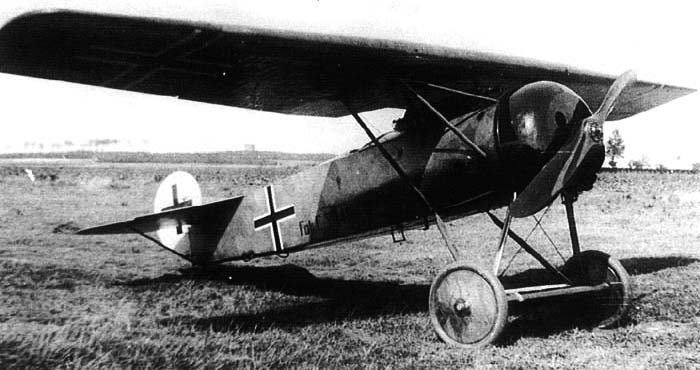
Models
The story of Fokker development is interesting. The company specialized quite quickly on fighters after a serie of observation monoplanes and a few biplanes, with mixed success. In fact, it was unique in having all its three top fighters – and arguably each time the very best on offer – representing all three types of wings configuration: Monoplane (E serie), Triplane (Dr.I) and Biplane (D.VII).
Production runs were limited, until the arrival of the D.VII which was imposed industrially to all German manufacturers to stand a chance when facing the Entente industrial figures, way above until then. If the E was responsible for the first “Fokker scourge” the Dr.1 legendary agility soon cleaned up any opposition, while the D.VII, late in the war, was as fast and powerful as it was still agile and certainly won by agreement of most experts the conveyed title of “best fighter of WW1”.
Proof of that was the particularly long production run and wide use of the model after the war, and a long lineage that followed -as the company name’s fame- in the interwar. The best dogfighter overall title could have been given to the Dr.I, but the D.VIII war aguably as agile, being much faster as well.
- Fokker Spin (About 5-6 prototypes) 1913 https://en.wikipedia.org/wiki/Fokker_Spin
- Fokker M.5 Obervation plane (A.II, A.III) 1914 – 50?
- Fokker M.6 (prototype 1914)
- Fokker Eindecker 1915 – 450
- Fokker M.7/10 observation 1915 (Austro-Hungarian B.I) – 20 built
- Fokker A.I (M.8) 1915 – 63-85
- Fokker K.I/M.9 twin push-pull engines, twin boom prototype 1915
- Fokker M.10 Observation about 30 1916
- Fokker M.16 two-seat fighter 1916 – 10
- Fokker D.II fighter 1916 – 177
- Fokker D.I fighter 1916 – 144
- Fokker D.III fighter 1916 – 210
- Fokker D.IV fighter 1916 – 44
- Fokker D.V fighter 1916 – 216
- Fokker V1-3 parasol fighter 1916
- Fokker V4 triplane fighter prototype 1917
- Fokker V5 or F.I preserie 1917
- Fokker Dr.I 1917 – 320
- Fokker V.6, V.7 Dr.I prototypes
- Fokker V.8 1917 quintuplane prototype
- Fokker V.9 – V.33 various biplane fighter prototypes 1917-18
- Fokker D.VI 1918 – 59
- Fokker D.VII 1918 – 3300
- Fokker V17-25 – Series of experimental aircrafts
- Fokker D.VIII – 381 (1918)
- Fokker V.27 – V.37 prototypes
- Fokker C.I (1918) 250
Fokker models
Fokker M.5
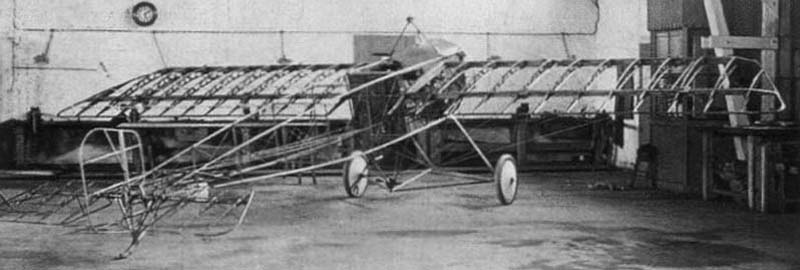
This unarmed single-seat monoplane defined in 1913 was one of many German’s reconnaissance aircraft that existed, all shadowed by the bird-like Etrich Taube. Anthony’s design never went from far away, he closely watched the French Morane-Saulnier H, shoulder-wing monoplane, for inspiration. However the fuselage he designed had a welded steel tube frame in place of a wooden structure, and it was propelled by an honest 60 kW (80 hp) Oberursel U.0 7-cylinder rotary engine. The latter was a licence-built Gnome Lambda. The tail and elevators were all-moving, without fixed sections.
Soon two versions were developed:
-The long-span ‘M.5L’ Produced as Fokker A.I , ? built
-The short-span ‘M.5K’ Produced as Fokker A.III 10 built
The “L” was for long, “K” meant “short” or Kurz in German.
-The MG-armed ‘M.5K/MG’ 5 built
-The ‘M.6’ Two-seats version
-The ‘M.7’ Two-seats version, 20 built
-The ‘M.8’ 2 side-by-side seaters, produced as Fokker A.II
-The ‘W.3/4’ Floats-fitted version
-The short-span ‘M.5K’
The Fokker M.5 was a light and strong, very agile plane to the point of being used for aerobatics but it should be noticed, capricious for its very sensitive fore-and-aft control, and Fokker, still young and dashing, demonstrated his plane’s abilities Johannisthal in May and June 1914, winning awards in the process and interest from the German staff.
The German army ordered the “long” M.5L, manufactured by Halberstadt under the ‘A.II’ designation. The ‘M.8’ two-seater also entered service as the ‘A.I’. These served on the Western and Eastern Fronts in an in early 1915, ten M.5Ks were ordered as ‘A.III’, of which five received a single 7.92 mm (.312 in) Parabellum MG14 machine gun for testings. They were later modified as the famous Fokker E.I. This plane was also used by Austria-Hungary.
Specifications:
-Length/Wingspan: 7.2 m x 9.2m (23 ft 7 in x 31 ft 2 in)
-Empty weight: 399 kg (880 lb), Gross weight: 610 kg (1,345 lb)
-Powerplant: Oberursel U.0 7-cylinder rotary piston engine, 60 kW (80 hp)
-Performances: 130 km/h (81 mph; 70 kn), Service ceiling: 3,000 m (9,800 ft)
-Armament (only the five M5K/MG): 7.92 mm (0.312 in) MG 14 Spandau machine gun
Fokker Eindecker

Fokker E.1
The fearful “E” was the first purpose-built German fighter aircraft. It was also the first worldwide to be fitted with a synchronization gear. This enabled the pilot aim the plane without leaving his position, firing through the propeller arc without striking the blades. The “E” for Eindecker or monoplane, bring overnight to the German military air superiority approximatively from July 1915 to early 1916 a period later known as the “Fokker Scourge”.
The Eindecker was based as we seen before on the M.5K scout or modified Fokker A.III based on the French Morane-Saulnier H. The fuselage however used chrome-molybdenum steel tubing instead of wood and crucially it was given the Fokker synchronizer mechanism used for the MG14 machine gun to fire through the propeller. Anthony Fokker for the anecdote towed the prototype aircraft behind his touring car to the military airfield near Berlin on 23 May 1915 and flew it.
The prototype was alloted the serial number A.16/15 by Leutnant Otto Parschau and previously had been pruchased by Oberleutnant Waldemar von Buttlar which painted it green. He personally tested the synchonizer in May and June 1915 at Douai with Feldflieger Abteilung 62 and helpd correct the mechanism. These tests helped to define the M.5K/MG on which the Eindecker was based. Parchau’s second Eindecker was serialized number 191, and accepted by IdFlieg on May 26, 1915.
One unmistakable aspect if the planes were their sheet metal panelling, a special form of “dragged” engine turning performed on all metal surfaces, even internal ones. This finish was only dropped by the end of 1916. other specifics included a gravity fuel tank that had to be constantly filled by hand-pumping from the main tank up to eight times an hour. The aerodynamically balanced rudder and elevator, ans no tail surfaces made the Eindecker very responsive to pitch and yaw and tricky for beginners. But that was also the trademark of a true fighter, despite on the other hand having a poor roll, the result of wing-warping. In total, 416 of these fighter will be delivered, through four main variants E.I to E.IV.
The Eindecker E.II to E.IV
The E.I was the initial serie, a production armed scout powered by a 80hp Oberursel U.0 rotary engine, 68 of which were built. With the Fokker E.II, the term “fighter” was more appropriate, as this improved production armed scout was powered by a 100hp Oberursel U.I rotary engine. 49 were built. Both series were almost “pre-series”, compared to the following E.III, major production still powered by the same 100hp Oberursel U.I but with improved structure and equipment.
249 were delivered total. With the last version E.IV, the fuselage was slightly enlarged to accommodate a 14-cyl. Oberursel U.III engine but moreover two machine guns above the engine hood instead of one, a decidedly marked firepower improvement. 49 were built of this last version.
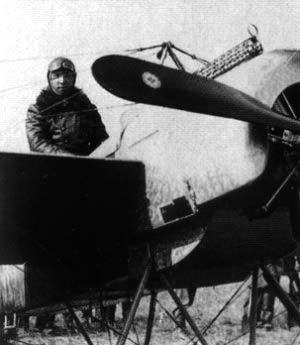 The Allies soon realized the advantages of the Eindecker when on 8 April 1916, a young pilot landed at a British aerodrome near St Omer, and tried, but failed to destroy his aircraft. The plane was repaired and soon tested against the Morane-Saulnier N and other types. This one ended in the Science Museum in London while Immelmann’s own E.13/15 is now displayed at Dresden.
The Allies soon realized the advantages of the Eindecker when on 8 April 1916, a young pilot landed at a British aerodrome near St Omer, and tried, but failed to destroy his aircraft. The plane was repaired and soon tested against the Morane-Saulnier N and other types. This one ended in the Science Museum in London while Immelmann’s own E.13/15 is now displayed at Dresden.
The Eindecker E.I rules the skies
Entering service in the summer of 1915, the E.I obtained a first unconfirmed aerial victory on Leutnant Wintgens’s own M5K/MG on 1 July 1915 near Lunéville, against a Morane L. Another Morane was forced to land, and at last a credited victory was registered on 15 July 1915. organically these planes were to be attached to provide escort protection for six two-seat reconnaissance biplanes.
But soon in August, Oswald Boelcke and Max Immelmann (Feldflieger Abteilung 62) rose to fame in August. The first scored 19 victories on the “E” out of 40. Max Immelmann which also devizsed his famous tactics won all his victories on this plane, before being killed in June 1916 on his E.III, perhaps because a synchonizer failure. Eleven more pilots became aces on the E series and in addition to the two top aces mentioned, Parschau and Wintgens also received Germany’s highest military award, “Pour le Mérite”/”Blue Max”.
Domination soon ended when the Airco DH.2, Royal Aircraft Factory F.E.2, and French Nieuport 11 soon appaeard superior or at least equal to the challenge. However some pilots were attached to the Eindeckers to such a point they flew it until late 1916, as shown by the duel between Alfred Heurteaux’s SPAD VII which eventually shot Wintgens’s own E.IV on September 25, 1916.
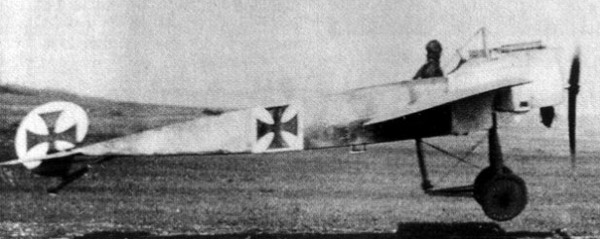
Specifications (E.III):
-Length: 7.2 x 9.52 x 2.4 m (23 ft 7 in x 31 ft 3 in x 7 ft 10 in)
-Empty weight: 399 kg (880 lb), Gross weight: 610 kg (1,345 lb)
-Crew: 1
-Powerplant: Oberursel U.I 9-cyl.air-cooled rotary piston engine, 75 kW (100 hp)
-Performances: 140 km/h (87 mph; 76 kn) Endurance 1.5 hours, ceiling 3,600 m (11,810 ft), climb: 3.333 m/s
-Armament: One 7.92 mm (0.312 in) lMG 08 Spandau machine gun (two on the E.IV)
Fokker M.7

Fokker B.I/M.7 photo http://forum.valka.cz/files/fokker_bim7_02_623.jpg
The Fokker M.7 was a single-bay sesquiplane of conventional configuration. There were slightly staggered wings using wing warping for roll control. It was a two-seater fitted with a distinctive comma-shaped rudder. It was powered by a 60 kW (80 hp) Oberursel U.0 rotary engine. Twenty of these observation planes were delivered. A few to Kaiserliche Marine for their shore stations. They aso tested the The W.3/W.4 floatplane version. This plane was also operated by the Austro-Hungarian forces designated B.I, after Idflieg designation system.
Specifications:
-Length: 9.9 m (32 ft 6 in), Wingspan: 14.3 m (46 ft 11 in), Height: 3.2 m (10 ft 6 in), Wing area: 32.5 m2 (350 sq ft)
-Empty weight: 650 kg (1,433 lb), Gross weight: 850 kg (1,874 lb)
-Crew: 2
-Powerplant: 1 × Mercedes Typ E4F[12] 4-cyl. water-cooled piston engine, 64 kW (86 hp)
-Performances: Max speed: 100 km/h (62 mph; 54 kn), Range: 140 km (87 mi; 76 nmi), Service ceiling: 2,000 m (6,600 ft)
-Armament: Rifles, pistols and hand dropped bombs.
Fokker A.I
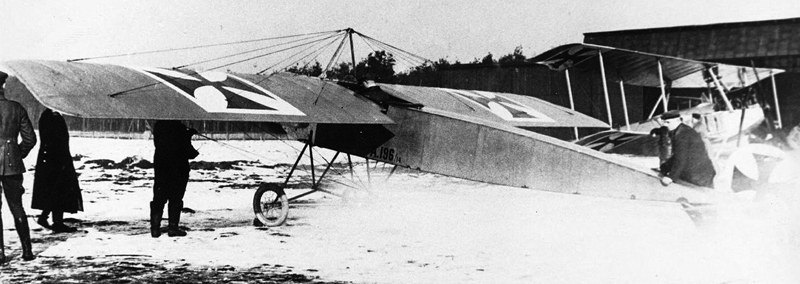
This Fokker A.I (M.8) photo was previously in Flickr coll. of San Diego Air & Space Museum, now on wikimedia commons
The Fokker A.I (Fokker factory designation M.8) was an unarmed two-seat monoplane observation aircraft (A-class) of 1914. It took its origine before the war, when a Morane-Saulnier Type H was purchased from France and studied to create the whole “A” lineage. This observation monoplane designed by Martin Kreutzer was powered by the 58.8 kW (80 PS) Oberursel U.0 seven cylinder rotary engine. Also called umlaufmotor this widespread engine was a near-clone of the Gnome Lambda rated for the same power output. It was used until the introduction of the E.II in 1915.
The A.I was related to the Fokker M.5, largely flown in aerobatics before the war. It had a tall dorsal “cabane” structure for three sets of stationary flying and landing wires. Each wing panel had fourteen ribs, for the same number of wing warping cables attached to the rear spar. The A.I was licence-built by Halberstadt in addition to Fokker to about 63 planes. It was used by the Fliegertruppe, Kaiserliche Marine’s Marine-Fliegerabteilung and Austro-Hungarian K.u.K. Luftfahrtruppen.
Specifications:
-Length: 7.54 x 12.12 x 2.75 m (24 ft 9 in x 39 ft 9 in x 9 ft 0 in), wing area: 32.5 m2 (350 sq ft)
-Crew: 1
-Powerplant: Oberursel U.0, 58.8 kW (80 hp)
-Performances: Max speed: 135 km/h (84 mph), Range: 400 km (249 miles), Service ceiling: 3,000 m (9,840 ft)
-Armament: None.
Fokker M.10
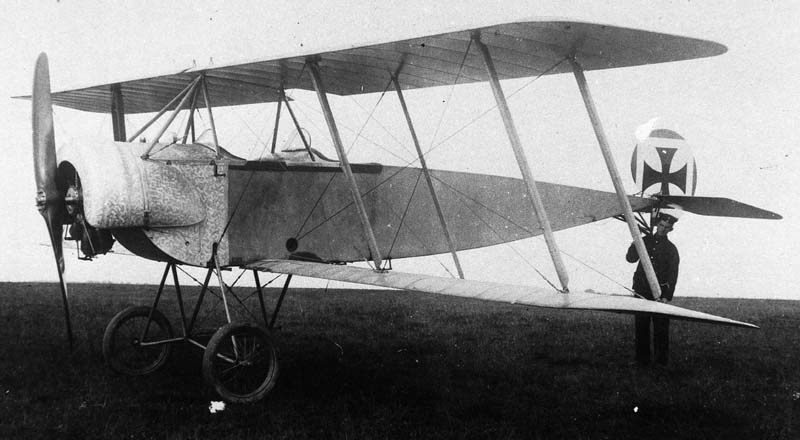
Fokker M.10
This two-seater reconnaissance/fighter-trainer biplane had single-bay wings fitted with wing-warping controls. It was powered by a 7-cylinder 80 hp Oberursel U.0 engine and was exclusively flown by the Austro-Hungarian aviation: The Imperial and Royal Aviation Troops or Kaiserliche und Königliche Luftfahrtruppen/K.u.K. Luftfahrtruppen. Lacking aircraft production capacity the Empire indeed purchased this model in Germany in 1916, and in two versions, single-bay wings (M 10E or “Einstielig” or Fokker B.I), and two-bay wings Fokker M 10Z (“Zweistielig”), or Fokker B.II).
The first was powered by an 60 kW (80 hp) Oberursel U.0 7-cylinder rotary engine. It was based on the Fokker M 7 from 1915 with a revised and strengthened undercarriage and centre section struts. First delivery occurred in April 1916 and the next 19 aircraft in August 1916 and last 3 in September 1916 because of engines supplies limitations. They served as unarmed trainers until the end of the war.
Specifications:
-Length: 6.20 x 7.20 x 2.71 m (20 ft 4 in x 23 ft 7 in x 8 ft 11 in)
-Empty weight: 274 kg (604 lb) Gross weight: 481 kg (1,060 lb)
-Crew: 2
-Powerplant: Oberursel U.0 7-cyl. air-cooled rotary piston engine, 60 kW (80 hp)
-Performances: Max speed: 130 km/h (81 mph)
-Armament: None.
Fokker D.II

Fokker D.II
The Fokker D.II was a fighter biplane, single-seat developed before the Fokker D.I, based on the M.17 prototype. it was given single-bay unstaggered wings, a larger fuselage, shorter span. It was also given a 75 kW (100 hp) Oberursel U.I and a the single 7.92 mm (.312 in) LMG 08 machine gun. 177 were purchased but proved to be only marginally better than the Eindecker, and totally outclassed by the Nieuport 17 in the end. A few were used by the Kampfeinsitzerkommandos and Jagdstaffeln but they were all discarded when the new Albatros were introduced. After the war they found their way into the Koninklijke Marine and Swiss Air Force.
Specifications:
-Length: 6.40 x 8.75 x 2.55 m (21 ft 0 in x 28 ft 9 in x 8 ft 4 in)
-Empty weight: 384 kg (847 lb) Gross weight: 575 kg (1,268 lb)
-Crew: 1
-Powerplant: Oberursel U.I rotary, 75 kW (100 hp)
-Performances: 150 km/h (93 mph), Range 200 km (124 miles), ceiling is 4,000 m (13,125 ft), climb in 4.2 m/s (820 ft/min)
-Armament: 7.92 mm (.312 in) lMG 08 machine gun
Fokker D.I

Fokker D.I
The Fokker D.I (M.18) was developed from the D.II fighter and later used by the Austro-Hungarians as the B.III. The D.I and D.II were both introduced in the summer of in 1916, both designed by Martin Kreutzer. This model was an unstaggered single-bay equal-span biplane using wing-warping for roll and fitted with the 75 kW (100 hp) Mercedes D.I six-cylinder water-cooled engine. A twin-bay (Zweistielig) was also tried to improve visibility.
The latter was given a 89 kW (120 hp) Mercedes D.II inline engine but also a single synchronized 7.92 mm (.312 in) lMG 08 machine gun, while the Austro-Hungarian B.IIIs was still fitted with the D.I engine, but replaced the armament by a local Schwarzlose machine gun. Another Austro-Hungarian B III also tested a 119 kW (160 hp) Mercedes D.III engine and there were other aerodynamic modifications tested.
In July 1916 the production started, 90 being taken in account by the German Fliegertruppen, and 16 by the Austro-Hungarian Luftfahrttruppen. 8 more were also license-built by the Magyar Általános Gépgyár for the Hungarian air force. But these planes compared badly to the contemporary Albatros D.II and the Nieuport 11 and production was halted.
Specifications:
-Length: 9.9 m (32 ft 6 in), Wingspan: 14.3 m (46 ft 11 in), Height: 3.2 m (10 ft 6 in), Wing area: 32.5 m2 (350 sq ft)
-Empty weight: 650 kg (1,433 lb), Gross weight: 850 kg (1,874 lb)
-Crew: 2
-Powerplant: 1 × Mercedes Typ E4F[12] 4-cyl. water-cooled piston engine, 64 kW (86 hp)
-Performances: Max speed: 100 km/h (62 mph; 54 kn), Range: 140 km (87 mi; 76 nmi), Service ceiling: 2,000 m (6,600 ft)
-Armament: Rifles, pistols and hand dropped bombs.
Fokker D.III
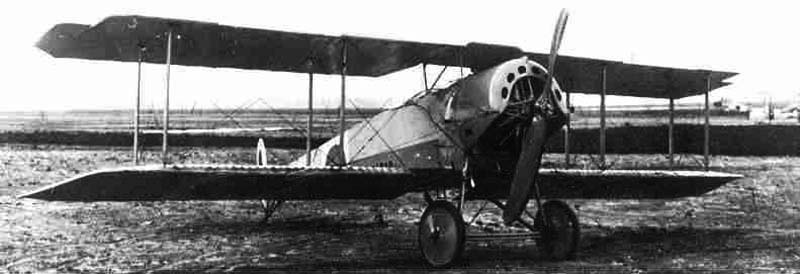
https://en.wikipedia.org/wiki/Fokker_D.III
Specifications:
-Length: 9.9 m (32 ft 6 in), Wingspan: 14.3 m (46 ft 11 in), Height: 3.2 m (10 ft 6 in), Wing area: 32.5 m2 (350 sq ft)
-Empty weight: 650 kg (1,433 lb), Gross weight: 850 kg (1,874 lb)
-Crew: 2
-Powerplant: 1 × Mercedes Typ E4F[12] 4-cyl. water-cooled piston engine, 64 kW (86 hp)
-Performances: Max speed: 100 km/h (62 mph; 54 kn), Range: 140 km (87 mi; 76 nmi), Service ceiling: 2,000 m (6,600 ft)
-Armament: Rifles, pistols and hand dropped bombs.
Fokker D.IV

https://en.wikipedia.org/wiki/Fokker_D.IV
This model used a more powerful Mercedes D.III engine, and the first Fokker front-line design to use ailerons in place of wing warping from the start for roll control. 40 were used by the Luftstreitkrafte and 4 by the Swedish air force.
Specifications:
-Length: 6.3 x 9.7 x 2.45m (10 ft 10 in x 31 ft 10 in x 8 ft)
-Empty weight: 600 kg (1,320 lb) Gross weight: 840 kg (1,848 lb)
-Crew: 2
-Powerplant: 1 × Mercedes Typ E4F[12] 4-cyl. water-cooled piston engine, 64 kW (86 hp)
-Performances: Max speed: 160 km/h (99 mph), range: 220 km (137 miles), rate of climb: 5.6 m/s
-Armament: 2 × fixed, forward-firing 7.92 mm (.312 in) LMG 08/15 machine guns
Fokker D.V
.jpg)
https://en.wikipedia.org/wiki/Fokker_D.V
Fokker D.V
following the disappointing D.I and the following serie up to the D.IV, Fokker designed a smaller, lighter design to use simpler and cheaper rotary engine. The new M.21 prototype was developed from the Austro-Hungarian M.17 fighter but this M.21 had a swept back upper wing, notably to improve pilot view, and it proved highly maneuverable.
After a modified cowling and stringers to renforce the fuselage the M.22 flew again and won an order from the Idflieg In October 1916. This production model D.V would engine the largest production run so far sine the E serie, and started with a low-compression Oberursel U.I in January 1917, 216 being turned in all. However pilots esteemed it presented much lower performances than contemporary Albatros series and soon joined schools from late 1917.
Specifications:
-Length: 6.3 x 9.7 x 2.45m (10 ft 10 in x 31 ft 10 in x 8 ft)
-Empty weight: 600 kg (1,320 lb) Gross weight: 840 kg (1,848 lb)
-Crew: 2
-Powerplant: 1 × Mercedes Typ E4F[12] 4-cyl. water-cooled piston engine, 64 kW (86 hp)
-Performances: Max speed: 160 km/h (99 mph), range: 220 km (137 miles), rate of climb: 5.6 m/s
-Armament: 2 × fixed, forward-firing 7.92 mm (.312 in) LMG 08/15 machine guns
Fokker Dr.I
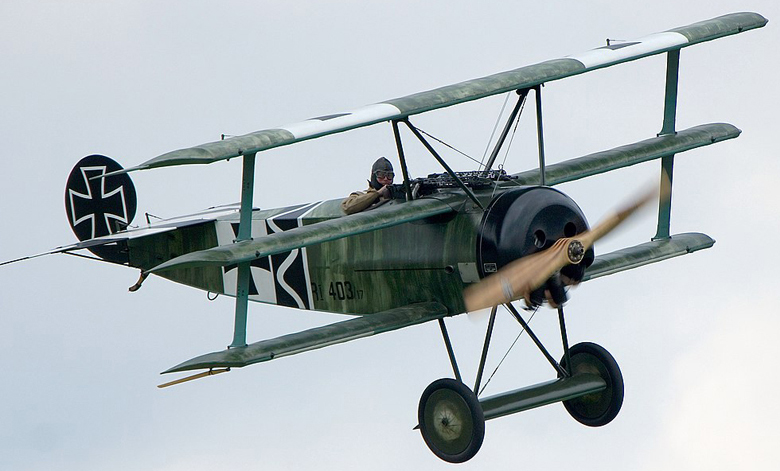
Dr.I reproduction at Airpower 11 airshow. probably the most famous German fighter of that era
https://en.wikipedia.org/wiki/Fokker_Dr.I
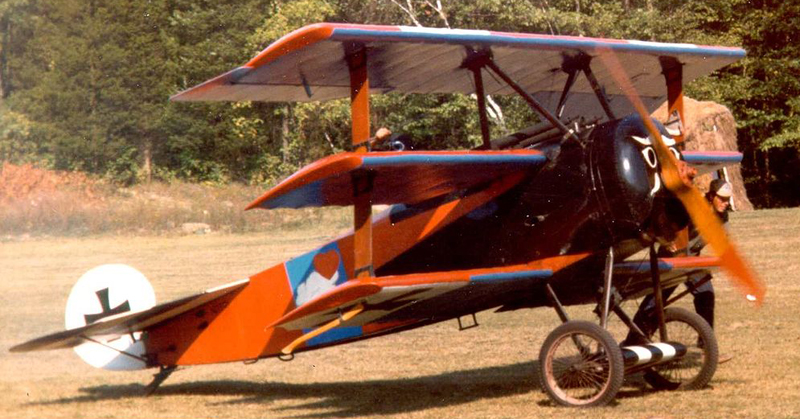
Dr.I reproduction at Old Rhinebeck Aerodrome
Specifications:
-Length: 6.3 x 9.7 x 2.45m (10 ft 10 in x 31 ft 10 in x 8 ft)
-Empty weight: 600 kg (1,320 lb) Gross weight: 840 kg (1,848 lb)
-Crew: 2
-Powerplant: 1 × Mercedes Typ E4F 4-cyl. water-cooled piston engine, 64 kW (86 hp)
-Performances: Max speed: 160 km/h (99 mph), range: 220 km (137 miles), rate of climb: 5.6 m/s
-Armament: 2 × fixed, forward-firing 7.92 mm (.312 in) LMG 08/15 machine guns
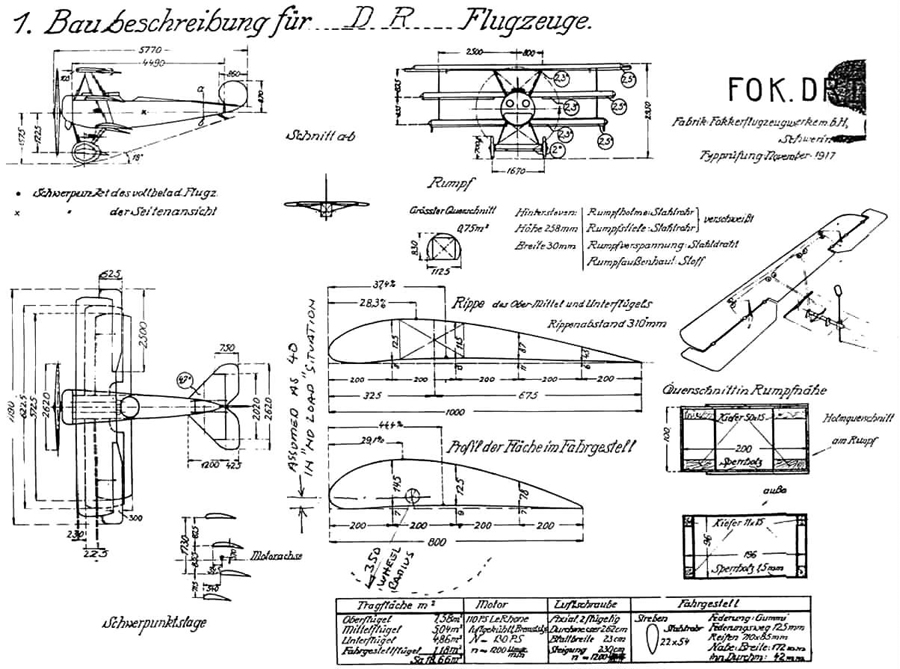
Fokker D.VI
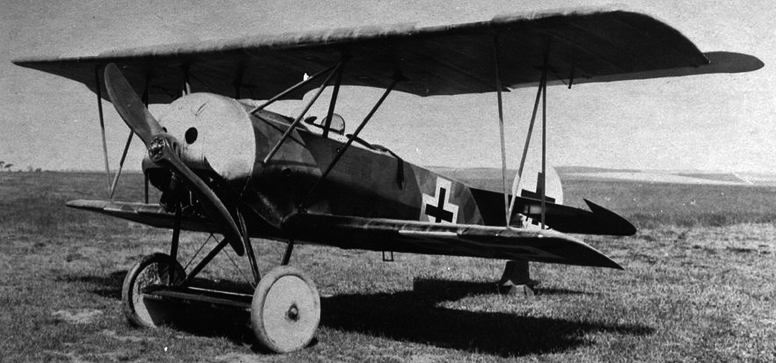
Fokker D.VI
This model used a more powerful Mercedes D.III engine, and the first Fokker front-line design to use ailerons in place of wing warping from the start for roll control. 40 were used by the Luftstreitkrafte and 4 by the Swedish air force.
Specifications:
-Length: 6.3 x 9.7 x 2.45m (10 ft 10 in x 31 ft 10 in x 8 ft)
-Empty weight: 600 kg (1,320 lb) Gross weight: 840 kg (1,848 lb)
-Crew: 2
-Powerplant: 1 × Mercedes Typ E4F[12] 4-cyl. water-cooled piston engine, 64 kW (86 hp)
-Performances: Max speed: 160 km/h (99 mph), range: 220 km (137 miles), rate of climb: 5.6 m/s
-Armament: 2 × fixed, forward-firing 7.92 mm (.312 in) LMG 08/15 machine guns
Fokker D.VII
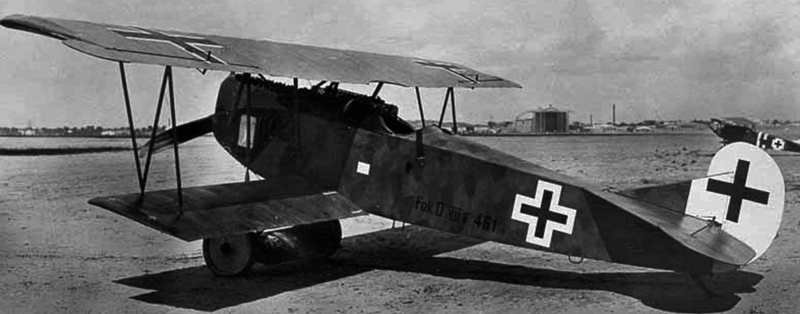
This model used a more powerful Mercedes D.III engine, and the first Fokker front-line design to use ailerons in place of wing warping from the start for roll control. 40 were used by the Luftstreitkrafte and 4 by the Swedish air force.
Specifications:
-Length: 6.3 x 9.7 x 2.45m (10 ft 10 in x 31 ft 10 in x 8 ft)
-Empty weight: 600 kg (1,320 lb) Gross weight: 840 kg (1,848 lb)
-Crew: 2
-Powerplant: 1 × Mercedes Typ E4F[12] 4-cyl. water-cooled piston engine, 64 kW (86 hp)
-Performances: Max speed: 160 km/h (99 mph), range: 220 km (137 miles), rate of climb: 5.6 m/s
-Armament: 2 × fixed, forward-firing 7.92 mm (.312 in) LMG 08/15 machine guns
Fokker D.VIII
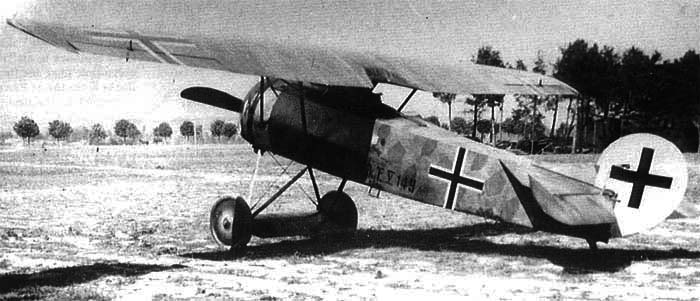
Fokker D.VIII
This model used a more powerful Mercedes D.III engine, and the first Fokker front-line design to use ailerons in place of wing warping from the start for roll control. 40 were used by the Luftstreitkrafte and 4 by the Swedish air force.
Specifications:
-Length: 6.3 x 9.7 x 2.45m (10 ft 10 in x 31 ft 10 in x 8 ft)
-Empty weight: 600 kg (1,320 lb) Gross weight: 840 kg (1,848 lb)
-Crew: 2
-Powerplant: 1 × Mercedes Typ E4F[12] 4-cyl. water-cooled piston engine, 64 kW (86 hp)
-Performances: Max speed: 160 km/h (99 mph), range: 220 km (137 miles), rate of climb: 5.6 m/s
-Armament: 2 × fixed, forward-firing 7.92 mm (.312 in) LMG 08/15 machine guns
Fokker C.I
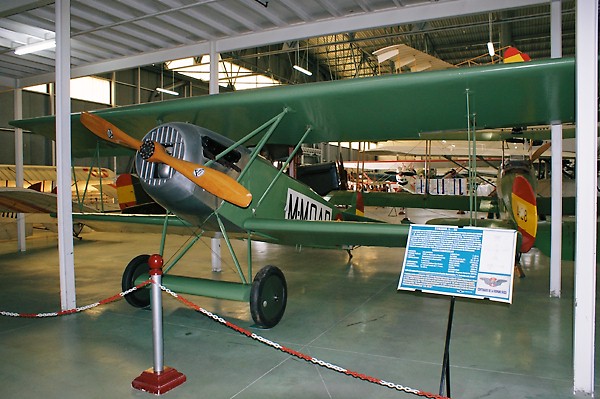
Fokker C.I
This model used a more powerful Mercedes D.III engine, and the first Fokker front-line design to use ailerons in place of wing warping from the start for roll control. 40 were used by the Luftstreitkrafte and 4 by the Swedish air force.
Specifications:
-Length: 6.3 x 9.7 x 2.45m (10 ft 10 in x 31 ft 10 in x 8 ft)
-Empty weight: 600 kg (1,320 lb) Gross weight: 840 kg (1,848 lb)
-Crew: 2
-Powerplant: 1 × Mercedes Typ E4F[12] 4-cyl. water-cooled piston engine, 64 kW (86 hp)
-Performances: Max speed: 160 km/h (99 mph), range: 220 km (137 miles), rate of climb: 5.6 m/s
-Armament: 2 × fixed, forward-firing 7.92 mm (.312 in) LMG 08/15 machine guns
Gotha
Gothaer Waggonfabrik, the heavy bomber trust
This German manufacturer of rolling stock established in the late nineteenth century later specialized in Wagon manufacturing and other railway hardware, was simply known as “Gotha” but it best remembered by its lineage of heavy bombers during the war. For Londoners the very name of “Gotha” was quickly assimilated with “Zeppelin” as hatred instruments of the blitz. They started in 1914 a highly successful series of bombers based on the design of Oskar Ursinus. But soon Hans Burkhard entered the fray and designed brand new planes. From 1917, he was the brainchild of twin pusher biplane bombers capable of long range strategic missions over England. These were the first heavier-than-air planes with that reach. Several dozen of these bombers were built, declined into many subtypes.
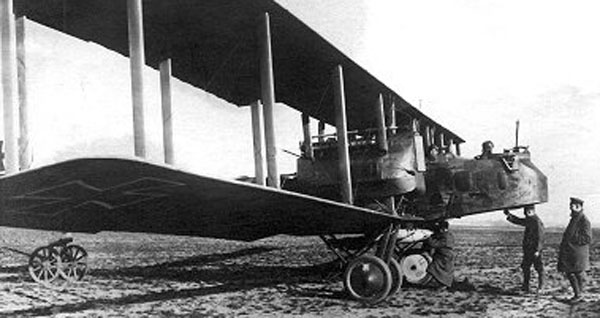
Gotha G.V, the emblematic bomber from Gotha
The whole Gotha serie however started with Ursinus’s Gotha G.I, and was followed by the Burkhard-designed G.II, G.III, G.IV, and G.V, the most prolific with thirty-six in squadron service. It is seldom known however that Gotha also manufactured training and reconnaissance planes from 1914, with the prefix “LD”, his own version of the Taube, the LE.1-LE.3 series, and floatplanes for reconnaissance, training, and even torpedo attack, prefixed WD. The G.VI to X heavy bombers were merely prototypes devised at the end of the war, that saw no production. Despite their amazing performances, Gotha bomber were never “recycled” after the war into civilian airliners and Gothaer Waggonfabrik simply returned to the railway industry, and extended activities on car production from 1921 to 1928 after purchasing Automobilwerk Eisenach. But the fame gained for its planes pushed it to return to the business from the mid-1930s after Hitler accession to power and the Versailles treaty rejection. At this point, Gotha started the production of biplane trainers, called Gotha Go 145, of which 1,182 were built. The company also produced Me-110 under licence and the assault glider Gotha Go 242 from 1941 (1,528 manufactured). But its most impressive feat was to finance and produce the revolutionary Horten Ho 229, from the Horten brothers. The first supersonic, partially stealth bomber, in 1944.

The Gotha G.IV was produced to 230, an amazing number for such a large plane, making Gotha the uncontested heavy bomber champion of Germany. These planes were instrumental in the first “blitz” over Britain, together with the infamous Zeppelins.
Gotha Models, in detail
- Gotha LD.1/2/6/7 multipurpose biplanes (40?)
- Gotha LD.5 single seat reconnaissance (13)
- Gotha LE.1/2/3 Taube monoplane (100?)
- Gotha WD.1/1a reconnaissance floatplane 1913 (5)
- Gotha WD.2/5/9/12/13/15 reconnaissance floatplanes (c30)
- Gotha WD.3 pusher reconnaissance floatplane (1)
- Gotha WD.7 twin-engined seaplane trainer/reconnaissance biplane (8)
- Gotha WD.8 single-engined seaplane trainer/reconnaissance biplane (1)
- Gotha WD.11 torpedo bomber floatplane (11)
- Gotha WD.14/20/22 torpedo bomber floatplanes (69)
- Gotha WD.27 large patrol floatplane (c3?)
- Gotha B.I Recce/trainer 1915 (12)
- Gotha B.II Recce/trainers 1916 (10)
- Gotha G.I/UWD heavy bomber 1915 (20)
- Gotha G.II heavy bomber 1915 (11)
- Gotha G.III heavy bomber 1916 (25)
- Gotha G.IV heavy bomber 1917 (230)
- Gotha G.V Heavy bomber 1917-18 (205)
- Gotha G.VI asymmetric heavy bomber 1918 (2)
- Gotha GL.VII high speed reconnaissance bomber 1918 (20)
- Gotha GL.VIII-X high speed bomber 1918 (c90)
- Gotha G.X high speed reconnaissance (1)
The Gotha Taube A.I (LE series) (1913)
The Taube is a familiar sight for all those aware of German aircrafts during WW1. This peculiar monoplane design, very organic, was quite popular and manufactured with local variants by most German manufacturers in 1912-14. Of these, the LE.3 were the best known. These were typical one seat monoplanes (Eindecker) with specific wingtips and wing warping for steering. Propelled by 50-80 hp inline engines and unarmed, they were the most basic commodity the Luftstreitkrafte had in 1914, the only plane in numbers. The Gotha Taube was internally designated as LE.1, LE.2 and LE.3 (which stands for Land Eindecker or “Land Monoplane”) but the army designation given by the Idflieg was A.I.
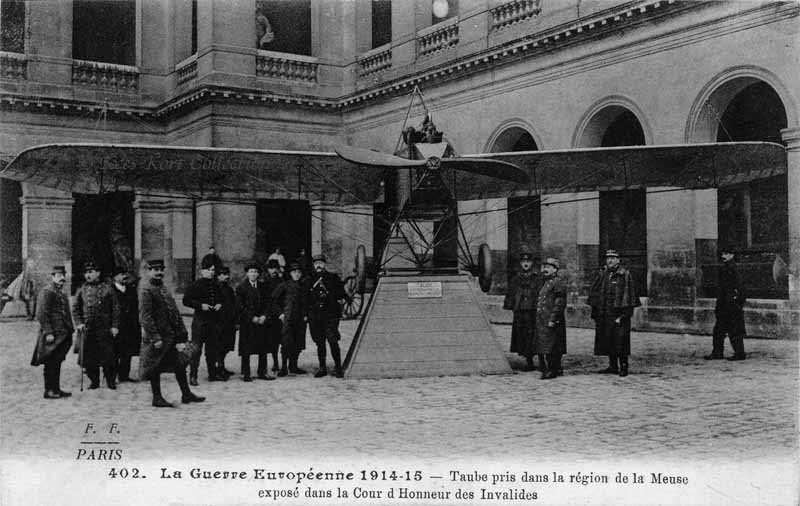
Captured LE.3 on Flickr, Kees Kort coll.
More. Gotha LE.1/A.I blueprint
Gotha A.I (LE.1) specifications: Wingspan 9.00m, Length 8.70m, Height 2.90m, Wing area 21.75m2, Weight 800/1380 kg, Type 1 PD Argus As IOC 100hp engine, top speed 212 kph, 180 kph cruising speed, range 630km, ceiling 3700m. See also: Gotha-A-I on valka
The Gotha LDs
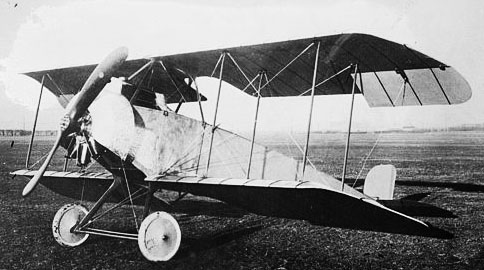
LD.5 (src. Library of Congress)
These early planes, dating back from 1914, were designated LD for Land Doppeldecker (“Land Biplane”) shaping a family of multipurpose aircrafts before and during the early part of the war. These weak but stable planes were used for training and reconnaissance and were conventional designs. They had two-bay unstaggered wings but also a tailskid landing gear.
Also they had two open cockpits in tandem for the pilot and observer. It seems they were in service with the Luftstreitkrafte but it’s unclear if there stayed as prototypes (one of each type) or saw actual production. They were obsolete past 1915. Figures are unknown, however several were supplied as military aid to the Ottoman Empire after German service.
The LD.1 was the basic open-cockpit biplane, the LD.1a a 1915 variant with a 100 hp (75 kW) Oberursel U.1 rotary engine, the LD.2 was fitted with a 100 hp (75 kW) Mercedes D.I inline engine, the LD.4 and LF.6a had some minor changes and engine variations and the LD.7 (Idflieg B.I, possibly the only one mass-manufactured) had minor changes and a 120 hp (89 kW) Mercedes D.II engine. The B designation meant they were used for reconnaissance, unarmed.
The Gotha LD 5 were built in November 1914, first flew in December, and were small biplanes designed as fast scouts for the Kavallerie Flugzeug. The undercarriage were a single-strut structure with cable bracing forward and a light steel tube to the rear. The fuel tanks were located in a protected corner in front of the cockpit. Their 100 h.p. Oberursel U I. engine ensure reasonable performances, but the LD.5 was rejected for field service, but kept as a single seat advanced trainer. In fact Gotha produced 13 of them apparently but they were not included in the Idflieg B-series.

Shot down Ottoman LD.2
Gotha B.1/B.II 1915-16
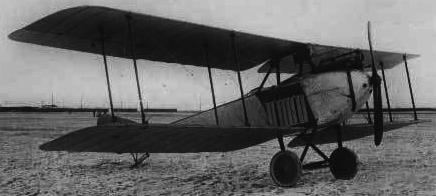
Gotha B.I – src militaer-wissen.de
The Gotha prefixed B-types (Unarmed reconnaissance) were unarmed reconnaissance/trainer aircrafts, with two seats, conventional tractor biplanes, produced outside the main line in a relatively few numbers: 22 in all, counting 12 B.I in 1915 and 10 B.II in 1916. They were a development of the Gotha 1914 biplane design fitted with a 120 hp inline engine, and factory designated LD.7.
It was later classified by Idflieg as Gotha B.I. and saw a small production in early 1915. The B.II (factory designation LD.10) differed significantly with larger wings, shorter fuselage and a rotary engine, similar to the earlier Gotha LD.1 two-seater, powered by a Gnôme 100 hp rotary engine.
Gotha B.II specifications:
Lenght 7,25 Meter, Span 14,5 Meter, height 3,45 Meter, weight: 525kg empty, Crew 2, Engine: Oberursel U.I rotary engine 100 hp, top speed 115 kph, range unknown.
The Gotha Floatplane saga
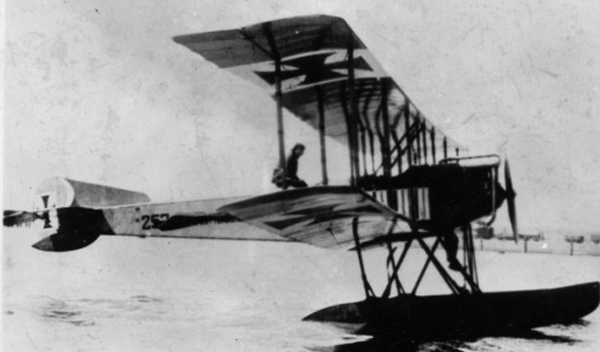
Gotha WD.2, Ray Wagner Collection.
Gotha WD.1-WD.5
The WD.2 -the acronym stands for “Wasser Doppeldecker” or “Water Biplane” and following models were a lineage of reconnaissance seaplanes from Gotha just before and during the early part of the Great War. The first model was developed from the naval version of the Avro 503, made under licence by Gotha, called the WD.1. This conventional three-bay biplane with tandem open cockpits, a Benz Bz.III engine and two pontoons under the wings, a third under the tail.
These were unarmed, altough after being sent to the Ottoman service they were rearmed with a 7.92 mm (.312 in) MG in a ring mount on the upper wing, fired by the observer. But this prewar machine was slow, and in an attempt to reach better performances, Gotha designed the WD.2 prototype (WD2a). This version had a reduced wingspan (15.6 m (51 ft) span) and a Mercedes D.III. engine.
Gotha WD.9-WD.15
It was further developed into the WD.5 another prototype which led in turn to the WD.9, which saw a small production. This model was armed, with a trainable 7.92 mm (.312 in) for the observer, relocated forward of the pilot. Only one was used by the Hochseeflotte, the batch was then sent to Turkey but with a less powerful engine (WD.2).
The WD.12 was powered by a D.III-powered, but still unarmed, and featuring a much better streamlining, notably around the engine with a revise cowling, and a propeller spinner. This model saw a small production for the German Navy, although the bulk went to the Ottoman Navy. A reduced production of WD.13s followed, similar but refitted with the earlier Benz.III engine. Only two WD.15s were built afterwards, completely redesigned with a plywood-covered fuselage and a Mercedes D.IVa engine. Their fate is not known.
Gotha WD.3
After 1914 Gotha was searching to arm the WD series, and before the development of the interrupter gear a forward firing arc with a relocated the engine to the rear of a nacelle (“pusher”) with the tail on booms either side of the engine was the seemingly best solution. Gotha already licence-built some Caudron G.3s and later LD.3 and LD.4, but the definitive design was more inspired by the AGO C.I and C.II. They sported indeed molded booms instead of a lattice frame. A single prototype of the WD.3 was built and tested but Gotha soon turned to other configurations.
Gotha WD.7/8
Eight of these twin-engined seaplane trainer and reconnaissance biplanes were built, almost a record for Gotha floatplanes. The pusher WD.3 being rejected by the Imperial German Navy, another layout still allowed to free the central nacelle, the twin-engine configuration. Therefore the next WD.7 was a conventional biplane with tractor engines located on the leading edge of the lower wing. This plane was tasted and accepted in service, and therefore eight were delivered, used as trainers for torpedo bombing.
In 1917 two were converted as gun-platforms, testing a 37 mm (1.46 in) autocannon by DWM. The same airframe was used to create the WD.8, reconnaissance version using this time a single Maybach Mb.IVa in the nose, much more powerful (240 hp). The sole armament was backward-firing, a single 7.92-mm Parabellum MG ring-mounted on the observer’s cockpit. This single WD.8 was tested and later used by the German fleet, numbered 476.
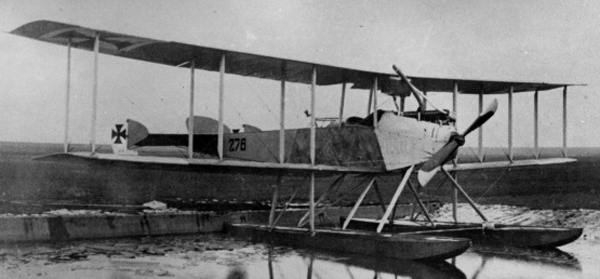
Gotha WD.8 reconnaissance seaplane, derived from the torpedo-bomber WD.7
Gotha WD.11
This model was another torpedo bomber seaplane derived from the WD.7. but with a larger and more powerful design. It was still a conventional biplan, twin-engined tractors on the lower wing, pilot and observer in tandem cockpits and twin pontoons. But the engines were now tow Mercedes D.III, 120 kW (160 hp) each, propelling the plane at 120 km/h (75 mph), with a climb rate of 1.3 m/s (250 ft/min). They could launch a 725 kg (1,600 lb) torpedo. Only 12 were delivered in 1916 to the Imperial German Navy. The Royal Netherlands Navy also used these after the war.
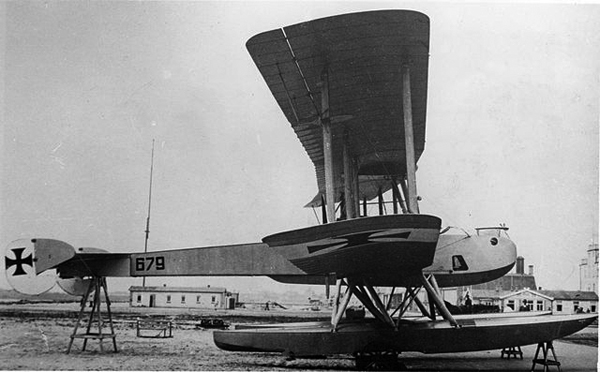
Gotha WD.11 torpedo seaplane, a larger and more powerful WD.7
Gotha WD.14/20/22
All three models were derived from the WD.11 and were so close that they are often assimilated in the same group, the 20 and 22 only be slightly modified variants. They represented the largest production of seaplanes for the Navy by Gotha so far, with 69 being turned out until late 1917. Basically the formula since the WD.7 was kept, and these were still were conventional biplanes, with twin engines this time mounted in a tractor-fashion.
The fuselage was wider, therefore the pilot and observer sat side-by-side in an open cockpit, that facilitated communication, while a second 7.92 mm (.312 in) MG was fitted in an open dorsal position. The large wings also could be folded for storage. Larger, better armed, these WD.14 were found however not very ineffective because of their low speed and poor agility. Many were later converted as mine layers, and transports landing machine gun detachments (Operation Albion, October 1917).
The next WD.20 had large auxiliary fuel tanks for long-range reconnaissance, and was used for this duty only. A few prototypes WD.22 also were built, having two extra engines in push-pull configuration. The WD.14 had two Benz Bz.IV, 150 kW (200 hp) each, capable of 130 km/h (80 mph), with a 8 hours endurance, and climbing in 1.3 m/s (250 ft/min). They were 14.45 m (47 ft 5 in) in lenght, 25.50 m (83 ft 8 in) in wingspan, and 5.00 m (16 ft 5 in) tall, weighting 3,150 kg (9,845 lb) empty and 4,642 kg (10,234 lb) fully loaded.

A camouflaged Gotha WD.14 torpedo seaplane in 1914. In practice these were too slow to make effective ones, being easy targets for AA defense by 1917 standards.
Gotha WD.27
The WD.27 was the last Gotha seaplane which first flew in 1918. It was derived from the experimental WD.22, and given two Mercedes D.III, 120 kW (160 hp) each in push-pull configuration and a 31m wingspan. They carried no armament, and were used as reconnaissance planes, the weight being reserved to additional fuel. Basically they were design to acte as “eyes of the fleet”, less conspicuous and faster than airships for that task. However contemporary Navy records show three German Navy serial numbers allocated, but photos shows that only one may have been flown.

An unidentified Gotha WD.27 long range seaplane in 1918. Three numbers were allocated but perhaps only the prototype was flown.
The Gotha Bomber Legend
Gotha G.I 1915
By mid-1914, Oskar Ursinus (German flying magazine Flugsport editor) was designing a large twin-engine seaplane of unconventional configuration with a snub-nosed fuselage attached to the upper wing, while the engines were mounted on the lower one… This was to minimize asymmetrical thrust if one an engine failed, which was current at the time. This also minimised the drag on the upper wing and provided excellent views for the three crewmen and broad fields of fire.
Ursinus worked under Major Helmut Friedel, presenting a seaplane design which matched Idflieg March 1914 large aircraft specs leading to the construction of a prototypeat the Fliegerersatz Abteilung 3. The B.1092/14 also called FU (“Friedel-Ursinus”) was powered by two 75 kW (100 hp) Mercedes D.I engines, was armed with a 7.92 mm (.312 in) MG in the nose, and chrome-nickel armor. It flew on 30 January 1915 but was also noted difficult to fly and lacking in structural integrity. It was also underpowered, but sent to the front (Feld Flieger Abteilung 28) based at Ujatz on the Russian Front.
Proved under service conditions, a contract was issued for production on 1 April 1915 at Gothaer Waggonfabrik AG. The company indeed acquired the license from Ursinus, but Hans Burkhard simplified and refined the design and the new “GUH” was lated called Gotha G.I, sometimes Gotha-Ursinus G.I. Production started on 27 July 1915, each powered by two 110 kW (150 hp) Benz Bz.III engines, and 18 G.Is in three batches were delivered until their replacement by a home design. The last batch was given more powerful 160 hp Mercedes D.III engines and one extra MG, plus twice the armor. A single UWD, converted floatplane was also ordered by the Navy in April 1915, and flew in February 1916, quickly named the Trojan Horse. It was lost after an October 1916 hard landing.

The Gotha-Ursinus was the only one using this unorthodox upper-wing fuselage arrangement, which had some advantages, but also drawbacks, partly corrected with the late production of the plane at the end of 1915. They were mostly used for defensive patrols and reconnaissance than bombing by 1917 for the survivors, as they made easy targets for fighters.
Gotha G.II 1915
(To Come)
Read More/Sources
https://en.wikipedia.org/wiki/Gothaer_Waggonfabrik
http://webopac.hwwa.de/Digiview/Digiview_GKD.cfm?IFIS=042798
Wikipedia Gotha B types
On militaer-wissen.de
https://web.archive.org/web/20101127020037/http://luftfahrtmuseum.com/htmd/dth/gotha.htm
Halberstadt
History of the Company
The company was created on 9 April 1912 as Deutsche Bristol Werke Flugzeug-Gesellschaft mbH, and settled in Halberstadt, a Province of Saxony. This was a prewar British-German joint venture with the sole object of manufacturing British and Colonial Aeroplane Company, Ltd models; namely Bristol Boxkites and Prier monoplanes. However this was short lived as soon as skills and experience was gained, the company turned to domestic designs, and by September 1913 it was renamed Halberstädter Flugzeugwerke GmbH. The new chief designer was Herr Hans Burkhardt (who later joined Gothaer Waggonfabrik, “Gotha”) and Herr Karl Theiss named as technical director and chief engineer. Alberstadt will soon manufacture chief reconnaissance models, delivering some 1,700 Type B & C planes for only 85 type D fighters for the Luftstreitkräfte. The 1919 Versailles treaty prohibition of military planes forced the company to be renamed Berlin-Halberstädter Industriewerke AG and convert to innocuous agricultural hardware and railroad cars repairs and maintenance but banckrupcy was never far away in these new territories, and the company’s financial wealth reached an absolute low in 1926 when proceeding were opened, and its assets purchased at auction by Junkers from 1935.
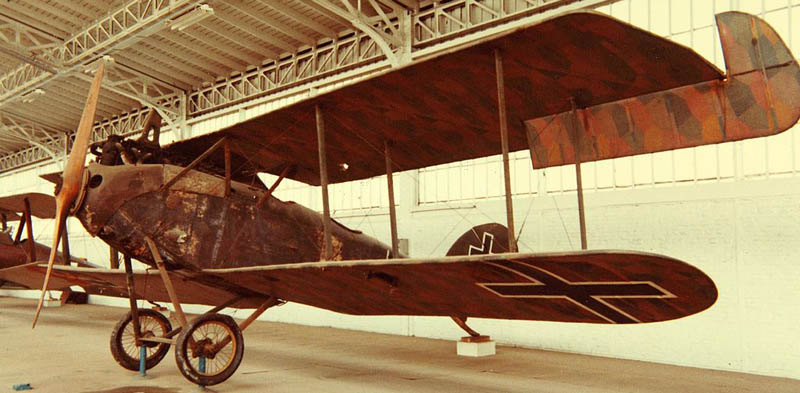
Preserved 100 years old Halberstadt C.V in the Musée Royal de l’Armée et d’Histoire Militaire, Brussels, Belgium.
Halberstadt Models
As usual, production planes are differentiated from prototypes by bold characters. B types were two-seat unarmed reconnaissance aircrafts. The biplanes were equipped with Oberursel-Gnome rotary engines, later (B.II and B.III) with Mercedes six-cylinder straight engines. Obsolete by the end of 1915, B models as well as early C models were converted as trainers. The B.II served as a basis for the armed Halberstadt CL.II.
- Halberstadt A.I/II biplane trainers 1914
- Halberstadt B.I biplane trainer 1914
- Halberstadt B.II recce biplanes 1915 (100?)
- Halberstadt B.III recce biplanes 1915 (10?)
- Halberstadt C.I prototype 1916
- Halberstadt C.III LR recce biplanes 1917 (6)
- Halberstadt C.V LR recce biplanes 1918 (200?)
- Halberstadt C.VII prototype 1918
- Halberstadt C.VIII prototype 1918
- Halberstadt C.IX prototype 1918
- Halberstadt CL.II multipurpose biplanes 1917 (900)
- Halberstadt CL.IV multipurpose biplanes 1917 (700)
- Halberstadt CLS multipurpose biplane prototype 1918
- Halberstadt D.I fighter 1916 (2)
- Halberstadt D.II fighter 1916 (65)
- Halberstadt D.III fighter 1916 (50)
- Halberstadt D.IV fighter 1916 (3)
- Halberstadt D.V fighter 1917 (57)
- Halberstadt G.I twin engine bomber 1916 (?)
Read More/Src
https://commons.wikimedia.org/wiki/Category:Halberstadt_C.V
https://www.militaryfactory.com/aircraft/contractor.asp?thisCompany=Halberstadt
http://flyingmachines.ru/Site2/Crafts/Craft25795.htm
http://flyingmachines.ru/Site2/Crafts/Craft30258.htm
Hannoversche Waggonfabrik

Hannover CL.II (wikimedia commons)
Hannoversche Waggonfabrik AG was known as a railway rolling stock constructor until required by the German government in 1916 to start the construction of airplanes. The aircraft branch of the company was established at Hannover-Linden where other types were first manufactured under license until 1916 when the Hannover type itself came on stream. The company was founded in 1898 to build passenger and freight railways cars and was rolling stock for the German military in 1914, wans by 1916, started licensed aircraft production, after making propellers from 1915, then repair work. It had both an important skilled workforce, and large stocks of seasoned wood to start in this direction and the Grneral staff was eager to try to match allied production levels by any means. To start its own models, Hannover hired Hermann Dorner (former DFW’s chief designer) in September 1917, creating the two-seat fighter Hannover CL.II, a great success, followed by the improved Hannover CL.III and IIIa about which a total of 791 were delivered until 1918.
The derivated Hannover CL.V was in production at the end of the war aafter a short preserie of C.IVs, a single seat fighter and a derivative, the F.3. These were advanced planes with excellent rigidity and thought for mass production by lowering the number of parts and had a far more powerful engine than its predecessors. Like the Italian Ansaldo SVA latee it had and unusual interplane strut arrangement that precluded the Warren truss system. But while Hannover attempted to move into civil aircraft manufacture afte the war with the F.10 and derivative airliners of the F.3, the Treaty of Versailles suspended all aircraft manufacture. Hannover turned back to its original railway stock manufacture. The Vampyr was an advanced glider (authorized) with stressed skin largely produced, which for some has been the precursor for all modern sailplanes.
- Hannover C.I (143)
- Hannover CL.II (443)
- Hannover CL.III/IIIa (180+611)
- Hannover CL.IV (5)
- Hannover CL.V (108)
- Hannover F.3 (1)
Read more/Sources
https://en.wikipedia.org/wiki/Luft-Fahrzeug-Gesellschaft
Hansa Brandenburg
The German floatplane specialist
Hansa und Brandenburgische Flugzeugwerke (now Hansa-Brandenburg) was a relatively short-span German aircraft manufacturer made famous during WW1, created in May 1914: The Brandenburgische Flugzeugwerke from Liebau was purchased by Camillo Castiglioni, and moved to Brandenburg an der Havel. Brandenburg’s chief designer, Ernst Heinkel kept his post, as the man will became quite famous by funding his own company later, Heinkel Flugzeugwerke, one of the pillars of German aircraft industry for many years to come. By Autumn 1915, the company ranked #1, as the largest aircraft manufacturer in Germany. The company had a capital of 1,500,000 Marks, while the three factories had 1,000 employees (Rummelsburg Plant, Berlin, and Wandsbek plant, Hamburg, in addition to Brandenburg an der Havel.
Castiglioni himself being Austrian, many military aircraft produced went directly to the Austro-Hungarian aviation corps. The company’s best-remembered products will be serie of floatplane fighters and versatile reconnaissance aircrafts used by the Reichsmarine (Imperial German Navy). Unable however to re-adapt itself to the civilian market, the company soon was bankrupt by 1919 but some models still went on production in Finland and Norway among others.

Hansa-Brandenburg W.11
As for other pages, we will focus in this part on prototypes, while the production models will be detailed in their own file below. The Hansa-Brandenburg W.11 was a single-seat biplane fighter floatplane of 1917 and derived from the KDW but with a more powerful engine, a Benz Bz.IVa, 160 kW (220 hp) which gave a top speed of 176 km/h (110 mph) and range of 350 km (217 miles). It was similar in the great lines to the KDW, in particular the same unusual interplane strut arrangement, with fins above and below the fuselage. Three prototypes were showcased in 1917 but the Navy ordered none. Another interesting plane was the Hansa-Brandenburg W.20, reconnaissance flying boat, first designed in order to be stored and deployed from a submarine aircraft carrier for extended commerce warfare. A small single-seat biplane flying boat, it could be quickly assembled, had a slender hull with a biplane wing, conventional braced tailplane. Its engine was the seven-cylinder 80 PS Oberursel U.0 rotary derived from the Gnome Lambda and mounted on struts in a pusher configuration, while the external floats were mounted on either end of the lower wings. but since the projected cruiser submarine was never built, only three W.20s demonstrators were built and tested.
The Hansa-Brandenburg W.27 and W.32 were prototypes of fighter floatplanes that only differed by their engine, either a Daimller Benz Bz.IIIb or a Mercedes D.III. Both derived from the W.12, single-bay biplanes of conventional configuration. They oddly had no dorsal tail fin. Their large rudder projected below the fuselage and forward of the rudder post while they had a rather short fuselage, more staggered wings, and I-struts for all their bracing. The next models were monoplan fighters, the W.29 and W.33. The first was licence-built postwar by Norway, while the latter was also licence-built by Finland (120) as IVL A.22 Hansa and by Yokosuka, Aichi and nakajima (310) for the Imperial Japanese Navy.

Hansa-Brandenburg W.32
Production Models built by Hansa-Brandenburg
- Hansa-Brandenburg B.I (1914) Recce biplane (c600)
- Hansa-Brandenburg C.I (1914) Recce biplane (1318)
- Hansa-Brandenburg CC (1916) Flying-boat fighter (73)
- Hansa-Brandenburg D.I (1916) Fighter (122)
- Hansa-Brandenburg G.I (1917) Bomber (50)
- Hansa-Brandenburg GW (1916) Floatplane torpedo-bomber (20)
- Hansa-Brandenburg KDW (1916) Floatplane fighter (58)
- Hansa-Brandenburg W (1914) Recce floatplane (77)
- Hansa-Brandenburg W.12 (1917) Floatplane fighter (181)
- Hansa-Brandenburg W.13 (1917) Flying-boat bomber (130)
- Hansa-Brandenburg W.19 (1918) Recce floatplane (55)
- Hansa-Brandenburg W.29 (1918) Fighter Floatplane (Monoplan) (78)
- Hansa-Brandenburg W.33 (1918) Fighter Floatplane (Monoplan) (26)
Hansa-Brandenburg B.I (1914)

This unarmed military trainer, reconnaissance biplane was flown only by the Austro-Hungarian Air Service (Austro-Hungarian Imperial and Royal Aviation Troops and Austro-Hungarian Navy). This first model was factory named type D, then FD after the fitting of the definitive, more powerful engine. This early design of Ernst Heinkel was conventional : A two-bay biplane with staggered wings of unequal span, pilot and observer seating in tandem in the same, long open cockpit. Of course it was unarmed, in accordance to the B designation. This model was produced also under license by Aero during the war for the Empire and afterwards Aero Ae 01 and also by Letov, as the Letov Š10. This was the basis for a derivative designs throughout the 1920s in Czechoslovakia, and once armed, the model became the C.I/C.II armed reconnaissance series. Postwar, this model was also flown by Poland (15 aircraft), the Royal Hungarian Air Force and Yugoslavian air force in the 1920s. Production records are unknown.
Specifications
Dimensions: 8.46 m (27 ft 9 in) x 13.13 m (43 ft 1 in) x 2.90 m (9 ft 6 in)
Weight: 760 kg (1,680 lb)/1,060 kg (2,340 lb)
Powerplant: Benz Bz.III, 120 kW (160 hp), top speed: 125 km/h (78 mph)
Range: 300 km (190 miles), service ceiling: 3,200 m (10,500 ft), rate of climb: 2.2 m/s (430 ft/min)
Hansa-Brandenburg C.I/II (1916)

This model internally known as Type LDD, was a 2 seat two-bays biplane, single-engine reconnaissance model, pretty close to the B.I. designed by Ernst Heinkel. The C.I had the same inward-sloping interplane bracing struts and was used by Austro-Hungary with a communal cockpit, but the observer was armed, in conformity with the C type denomination. The C.I was agile, handled well and benefited through its service life from more powerful engines. Let’s recall that of the 1318 built in total, only 84 were actually built by Hansa-Brandenburg. Phönix Flugzeugwerke produced 400 C.I, Ungarische Flugzeugfabrik A.G. made 834 C.I and Aero (A-14, A-15, A-26) made the complement. Production actually went on after the war for Czechoslovakia.
The C.I was used for reconnaissance, artillery observation and light bombing, from early spring 1916 to the end of the War. The C.I was armed with a scarff-mounted 8 mm (.315 in) Schwarzlose machine manned by the observer, while some had an additional fixed and non-synchronised one mounted in a pod above the top wing. In later production, a synchronised 8 mm (.315 in) Schwarzlose mahine gun was fitted on the port side of the fuselage. The usual bomb load was 60 kg (130 lb), up to 80 kg (180 lb) and two 10 kg (20 lb) bombs on the last models which had the most powerful engines. For Phönix these were the Series 429 with a 170 kW (230 hp) Hiero 6 engine, for UFAG, Series 369 with the same, and the Aero A.14, A.15 and A.26 had a Walter-built 138 kW (185 hp) BMW IIIa engine. The Poles also used this model after the war in the Lviv RPL-III workshops, a first batch of 15, then 15 more in the Kraków workshops. Before that, about 22 were received and used already in the Battle of Lemberg and then the Polish–Ukrainian War and Polish–Soviet War.
Specifications (early production by Hansa Brandenburg)
Dimensions: 8.20 m (26 ft 10¾ in) x 13.12 m (43 ft 0⅜ in)
Weight: 1,060 kg (2,332 lb)
Powerplant: Austro-Daimler water-cooled in-line, 120 kW (160 hp) 125 km/h (68 kn, 78 mph)
Service ceiling: 5,800 m (19,000 ft), 3 hours endurance.
https://en.wikipedia.org/wiki/Hansa-Brandenburg
Junkers Flugzeug und Motorenwerke AG
 Junkers Flugzeug- und Motorenwerke AG (called JCO or JKO in World War I), simplified as Junkers, was a major German aircraft and engine manufacturer better known for its WW2 products like the legendary Ju-87 “Stuka” and Ju-88 dive bombers or the transport plane Ju-52 among others, despite the fact that Junkers himself was not pro-Nazi and was removed from the company in 1934. But the company started in the Great war, producing some of the most innovative airplanes in Dessau, Germany. Founded in 1895 by Hugo Junkers, which had experience only so far in making boilers and radiators, the company pioneered the all-metal aircraft, in 1915. The serie started with this revolutionary J1 and went up to the J11 floatplane and other projects that were not ready on time during the war. Converting into civilian planes saved the company, which could go on staying on the edge of technology, until after 1933 the times were right again for a gradual return to military production. And the company went on its innovative path with world’s first heavy jet bomber, four-engine, with inverted swept-wing, the Ju-287.
Junkers Flugzeug- und Motorenwerke AG (called JCO or JKO in World War I), simplified as Junkers, was a major German aircraft and engine manufacturer better known for its WW2 products like the legendary Ju-87 “Stuka” and Ju-88 dive bombers or the transport plane Ju-52 among others, despite the fact that Junkers himself was not pro-Nazi and was removed from the company in 1934. But the company started in the Great war, producing some of the most innovative airplanes in Dessau, Germany. Founded in 1895 by Hugo Junkers, which had experience only so far in making boilers and radiators, the company pioneered the all-metal aircraft, in 1915. The serie started with this revolutionary J1 and went up to the J11 floatplane and other projects that were not ready on time during the war. Converting into civilian planes saved the company, which could go on staying on the edge of technology, until after 1933 the times were right again for a gradual return to military production. And the company went on its innovative path with world’s first heavy jet bomber, four-engine, with inverted swept-wing, the Ju-287.

Junkers-1, the world’s first all-metal fighter
Of course the model that launched it all was the J-1, first all-metal fighter (and plane by the way). It was modelled after a monoplane, because the biplane structure was judged too weak then to handle the weight, and a single prototype flew on 12 December 1915 and was further tested in 1916, giving birth to better models. It was Pioneered by the aeronautical designer Hugo Junkers, constructed and flown only 12 years after the Wright Brothers, which gave a sense of the speed of aircraft development made in between. Junkers would remain the only manufacturer of such planes until the end of the war, worldwide. Hugo Junkers was not new to metal working. His skills were developed from the calorimeter and various internal combustion engines parts he designed and licenced. However he was introduced to the idea of planes by Hans Reissner, a colleague and fellow professor at the Technische Hochschule in Aachen, present at his thermodynamic training course. He seeked the assistance of the latter to make fly an early monoplane aircraft (which was not a success), and five years later, in 1913, the two collaborated on an all-metal canard design, which he named the Ente (“Duck”). Still based on Reissner design, Junkers manufactured the flying surfaces and radiator. But Hugo spent a great deal of time figuring out problems of airframe design, and a way to get rid of bracing. He eventually patented a fully cantilevered thick aerofoil tailless aircraft, or flying wing. He was also granted in 1910 the construction of a wind tunnel at his research facilities in Aachen, where the R&D facilities were located. He set-up his own research institute and devoted his time designing and develop a series of fully cantilevered all-metal monoplanes, and from 1914, models with potential military value.
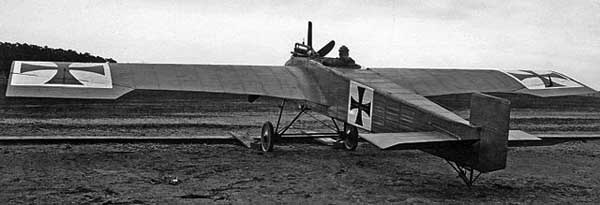
Junkers-1, back view. This prototype was sluggish enough to be compared to a donkey.
Since teamwork is often the base for success, Junkers was able to transform his institute into a successful business thanks to engineers Otto Reuter, Otto Mader (Forschungsanstalt – heads of the R&D institute) and Hans Steudel, head of Junkers’ structural materials section. His work on Reissner’s Ente convinced him that the only way to get rid of external bracing (which produce drag), was to create an all-metal structure. Although duralumin, invented by Alfred Wilm six years earlier in Germany was prone to flaking, so Junkers preferred proven but heavier electrical steel, and only in 8 June 1915 he started procuring himself with the necessary tooling. He soon started working on a “technology demonstrator”, the J-1, a private-venture research aircraft, never commissioned. Using a cantilever wing and all-metal structure elements, the J1 was of a very clean design, with perfect proportions in relation to the power, a reliable 90 kW (120 hp) Mercedes D.II six-cylinder liquid-cooled inline engine, with a profiled cowling, combined to an advanced engine radiator layout (ventral). Structurally reinforced by corrugated sheets, it used an all-metal stressed-skin construction, the world’s first plane to do so. The tail had mobile fins, and the angle of incidence of the stabilizer could be set from the ground. The internal structure used tubes, I-beam sections and stip-steel angle stock, while there was some limited external bracing, on horizontal stabilizers and the undercarriage. The steel panels with span-wise corrugations he used in particular on the wings was reused in the late 1930s in planes such as the Boeing B-17.
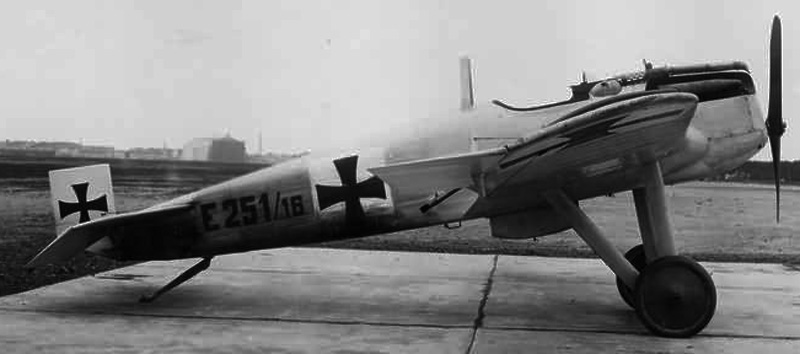
Junkers J-2, side view. This pre-production model gained some power an a modern undercarriage, but did not convinced the Idflieg. (src 1000aircraftphotos.com)
Even before its first flight, the IdFlieg, Inspektorat der Fliegertruppen was quite interested, and ordered static load tests in the end of 1915 and later engine thrust tests in December at Fliegerersatzabteilung 1 (FEA 1) airfield in Döberitz near Berlin. There was a first hop by Leutnant Theodor Mallinckrodt on 12 December 1915 and then from 18 January 1916, Gefreiter (Private) Paul Arnold multiplied fly tests at various altitudes and speed; It was unfavorably compared to the Rumpler C.I, being slower in straight line and more so in climbing rate. In addition, several issues on the ground were also spotted. But specialists such as Anthony Fokker all praised the effort. Only a better engine was needed at that point. This was for the next steps of the Company… The J-2 passed all tests wth brio and was declined for production as the E.I (Junkers Eindecker I). But “production” was limited to six pre-production models. It was still a brilliant concept, innovating with “unitized” the forward fuselage structure, integrating the wing roots, engine mount and cockpit, also a world’s first.
The J.2 was a clear-cut improvement on performance and handling, but in the summer of 1916 Hugo Junkers himself realized that the use of sheet electrical steel was not practical for aircraft production. In fact the company was still stuck in ongoing experimentations, compounded by substandard climbing performance and a fatal crash that did not compensated by the theoretical advantages of low-drag because of thr absence of external bracing. As the result the Idflieg eventually retired its support for the program. Despite this lack of support, Junkers already start working in parralel on a much lighter model, the Junkers J-3. This was the first attempt to use duralumin for the airframe construction, a mid-wing with a rotary engine and aluminum tubing fuselage. In this corrugated sheet duralumin covered the wing structures reinforced by “bare” tubular framing for the fuselage. This was an unfinished engineering exercise abandoned at the end of 1916. The J.4 was back to the biplane formula and was delclined into the armoured plane J.I (yes, can be confusing, see below). It was followed by a paper project, the Junkers J-5, developed in early 1917 with a cantilever wing, based on the J-4 so using duralumin. It was declined into two prototypes, the J 5I fitted with a Siemens Sh2 or Oberursel UR.II engine unusually behind the cockpit to improve balance and handling, the J 5II with the same engine in front, and J 5III later called Junkers J-6 with a Mercedes D.IIIa and a parasol wing.
Models produced

Junkers J.I, the biggest success of the company during WW1
The “Stuka” of WW1 was not a dive bomber, but it was a successful ground attack aircraft, and a frank success by Junkers. After the failure of all-metal fighters, the company worked on the J-4 (factory designation). It was an armored sesquiplane developed as a low-level ground attack, also capable of observation and Army cooperation. To compensate for the weight, both of the structure and armor it was powerful with a Benz Bz.IV, 149 kW (200 hp) and had a lower wing for sustentation, but indeed, only showed oblique struts between the fuselage and lower wings and the upper wing, no intermediary struts. Although costly, this plane armed with a simple observer MG on a flexible mount was well liked by its crew for its ruggedness, but less so for its poor handling, nicknaming it the “furniture van”. It weighted indeed 2,140 kg (4,718 lb) and its top speed was 155 km/h (97 mph). It was produced until the end of the war, arriving in time for the spring offensive in May 1918, but Junkers was unable to deliver them at a steady pace and it remained the only mass-produced Junkers plane of the war.
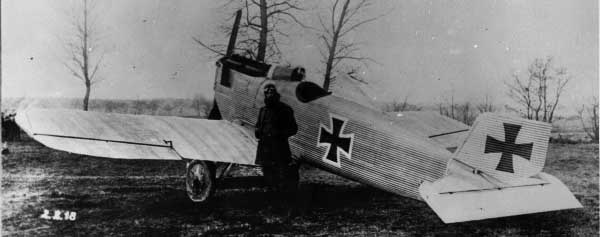
Junkers J-7 prototype, from which was derived the serial D.I
Junkers modified its copy on the next Junkers J-8, a private venture which first flew on 17 September 1917 and went through nearly a half-dozen detail changes resulting of the tests. So much so that Junkers felt confident enough to demonstrated it to the Idflieg after its past failure, in early 1918. And it attracted praise, resulting in an order for three more for additional army trials. However, the changes made cumulated to the point of Junkers creating a brand new prototype, the J 9 tested by Idflieg instead of the three J 7s initially ordered. This model was eventually reclassed as a naval fighter and production took place of two batched of 12 at the end of the war.
Junkers D.I, the sole all-metal operational fighter of WW1
Junkers returned to the fighter after working with duralumin and aluminium to produced at last a workable, light enough, but still all-metal fighter. It proceeded from the J.7
Models listing in detail
- Junkers J 1 – experimental monoplane 1915 (1)
- Junkers E.I – monoplane fighter, 1916 (6)
- Junkers J 3 – abandoned development of J 2
- Junkers J.I – ground attack, 1917 (227)
- Junkers J 5 – fighter prototype project (2 variants) 1917
- Junkers J 6 – fighter prototype parasol project 1917
- Junkers J 7 – fighter prototype, led to D.I
- Junkers CL.I – ground attack, 1917 (40)
- Junkers D.I – fighter, 1917 (41)
- Junkers CLS.I – seaplane two-seat fighter (3)
Junkers E-I 1916
Prior to this model, the first prototype was nicknamed the Blechesel (“Tin Donkey” or “Sheet Metal Donkey”). This amazing plane made extensive use of metal in and around its structure and surfaces instead of wood and canvas. It should be noted however that many manufacturers created a tubular metal box that was covered either with plywood and canvas.
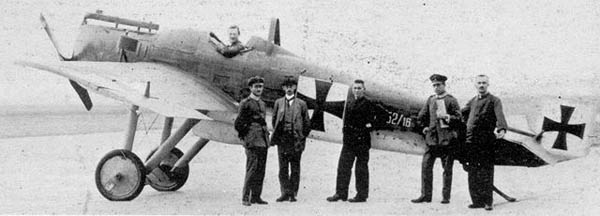
Junkers J-2
Junkers E-I Specs
Dimensions: 7.43 x 11.70 x 3.13 m (24 ft 4½ in, 38 ft 4⅔ in, 10 ft 3¼ in)
Weight: 920 kg (2,028 lb) to 1,165 kg (2,568 lb) gross
Powerplant: Mercedes D.III water-cooled engine, 119 kW (160 hp), 200 km/h (124 mph)
Range: 615 km (382 miles), Service ceiling: 4500 m (14,760 ft)
Armament: 7.92 mm (.312 in) lMG 08/15 machine gun
Junkers J.I 1917
The most produced Junkers plane of the era was defined not as a fighter, a personal Hugo Junkers obsession marked by a long line of prototypes, but still quite innovative. As a ground attack, armoured plane, it had a single-unit steel “bathtub”, starting after the propeller up the rear crew position. Not it was armoured but structured the main fuselage structure and engine mounting in a “monocorps” fashion. The armour plates were 5 mm (0.20 in) thick, adding a whooping 470 kgs (1,040 lb) to protect the crew, radio and fuel tank. To lift the lot, the J.I was fitted with a 35.89 m2 (386.3 sq ft) upper wing (with ailerons), and half for the lower wing 13.68 m2 (147.3 sq ft), in a pure sesquiplane configuration. And also innovative were the flight control surfaces connected by push-rods and bellcranks rather than steel cables, suited here as less likely to be cut by ground fire. Gravity-serving 120 litres (32 US gal) tanks and the planes could be disassembled easily into wings, fuselage, undercarriage, and tail for easy transport and maintenance. The planes could be assembled in 4-6 hours by a small team but great care had to be taken of the thin aluminum skin.
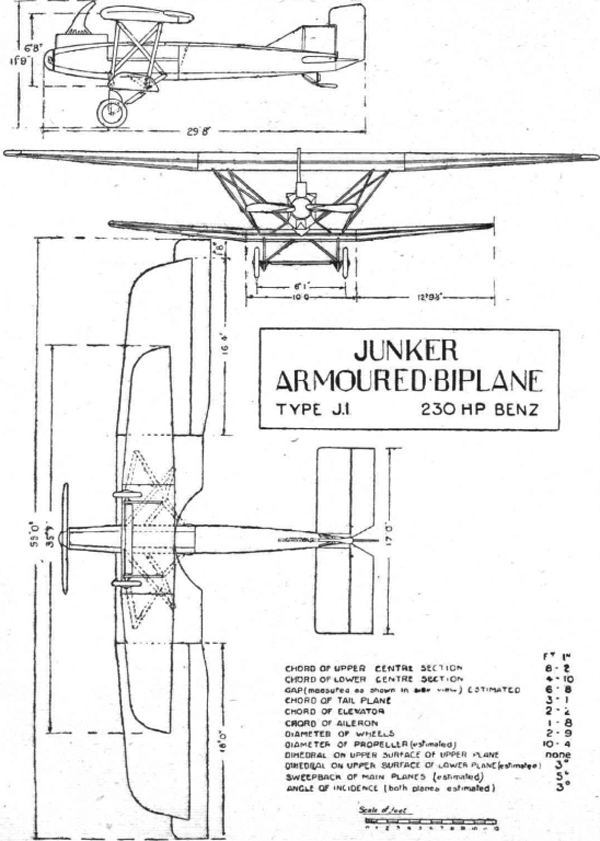
Blueprint of the Junkers J.I
All in all, the J.I made an excellent job after its introduction in August 1918, and was well liked by its crews despite its nickname of “furniture van” as it lacked agility and was heavy on commands. They saw action on the Western Front, in full force during the German Spring Offensive of 1918. Improvements in the field were made, two downward-firing machine guns for ground attacks. J.I excelled at army co-operation and low-level reconnaissance, dropping ammunition and rations on isolated outposts also, all under enemy fire. Only one J.I was reported down by a ground-base fire a French AA machine gun firing armour-piercing rounds. In fact more were lost because of landing accidents and other factors. But in the end, much more J.Is could have been operational if that was not for the slow rate of delivery caused by a lack of organization. Production ceased in January 1919. Only one survived, now at the Canada Aviation and Space Museum, partially cutout to see construction details but also in dire need of repairs…
Junkers J.I Specs
Dimensions: 9.1 x 16.00 x 3.4m (29 ft 10 in x52 ft 6 in x11 ft 2 in)
Weight: 1,766 kg (3,893 lb) to 2,140 kg (4,718 lb)
Powerplant: Benz Bz.IV, 149 kW (200 hp) 155 km/h range: 310 km 4,000 m ceiling
Armament: Rearward trainable 7.92 mm (.312 in) Parabellum MG14 MG
Junkers D.I 1918
Basically the D.I was based non the new J-3, which structurally still possessed the advantages of the duralumin-based J-3, but with a lengthened fuselage, extended wingspan and better engine. The Idflieg eventually ordered it as the Junkers D.I, ordering a preserie called J.9/II which underwent further evaluations. Indeed it still lacked the agility suited to a proper front-line fighter, but was was still judged fit for a naval fighter. A first batch of 12 was ordered. These were supplied to a naval unit by September 1918, and sent the Eastern Front after the Armistice. While a single survivor could be seen at the Musée de l’Air et de l’Espace in France, there are replicas, notably in Germany.
The D.I now exhibited at the Musée de l’Air et de l’Espace, Le Bourget, France
Junkers D.I Specs
Dimensions: 7.25 x 9.00 x 2.60 m (23 ft 9.4 in x 29 ft 6.3 in x 8 ft 6 in)
Weight: 654 kg (1,438 lb) to 834 kg (1,834 lb)
Powerplant: BMW IIIa water-cooled 6-cylinder inline, 138 kW (185 hp)
Performance: Top speed: 176 km/h (109 mph), 1.5h, 6,000 m (19,700 ft) 3.5 m/s (683 ft/min)
Armament: 2 fixed, forward-firing Spandau machine guns.
Junkers CL.I 1918
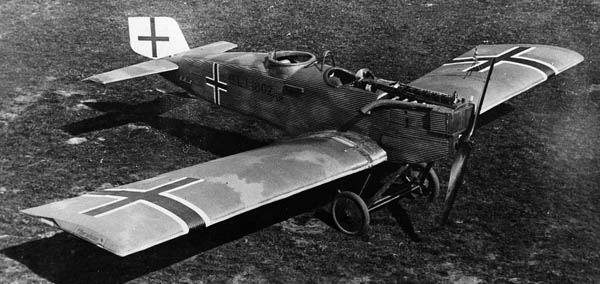
The CL.I in 1918
The Junkers CL.I was designed as a ground-attack aircraft, based on the factory-designated J 8 another Hugo Junkers all-metal monoplane, despite the Idflieg ordering a biplane whch ended as the J 4, entering competition for a ground-attack aircraft. The J 8 was based on the J 7 fighter with a longer fuselage for a tail gunner, and larger wings to cope with the added weight. The J 7 first flew in late 1917, followed by three more prototypes. They were shown to the Idflieg which at first ordered the type, but doubting Junkers abilities to mass-manufacture it, considered asking Linke-Hoffmann for licenced production. Junkers was chosen in the end under a joint venture with Fokker, which produced the modified J 10. As said above, Anthony Fokker was quite impressed by the design and saw this as an opportunity to study the concept first-hand. This plane was all-metal, with a tubular and framed structure skinned with thin corrugated duralumin sheets. In all, 47 were delivered before the Armistice. The CL.I was also declined as a floatplane (Only three) designated CLS.I (or J 11). Two CL.Is were converted as airliners with a rear cockpit enclosed. This was the start of a successful civilian serie which culminated with the mass-built Junkers 52, the famous “Aunt Ju”.
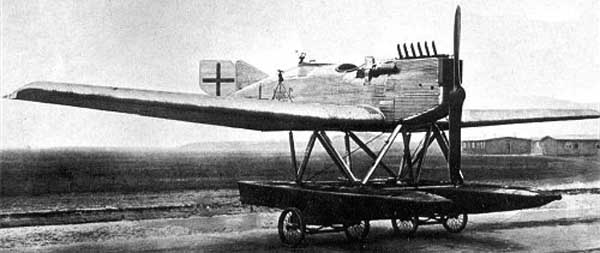
The naval variant J-11 or CLS.I in 1918
By the end of the war however, only a few planes had reached the front. Some ended being used by the Freikorps in 1919 against the Bolsheviks in Finland and the Baltic States while others served as courier or passenger planes. The latter were partially rebuilt with an enclosed cabin and flew regularly in March 1919 between Weimar and Dessau. Considerations were made for the Junkers J 12, later declined into the succesful Junkers F 13, one of the most modern airliner at that time.
Junkers J.I Specs
Dimensions: 7.90 x 12.04 x 2.65 m (25 ft 11 in x39 ft 6 in x8 ft 8¼ in)
Weight: 710 kg (1,562 lb), 1,050 kg (2,310 lb)
Powerplant: Mercedes D.IIIa, 134 kW (180 hp), 161 km/h, 2h, ceiling 6,000m
Armament: two fixed, forward-firing machine guns, one trainable, rearward-firing machine gun
Read More/Sources
https://en.wikipedia.org/wiki/Junkers
LFG – Luft-Fahrzeug-Gesellschaft
Also known as “Roland”
The Luft-Fahrzeug-Gesellschaft was born on April 30, 1908 to manufacture airships engines and known as Bitterfeld, Motorluftschiff Studiengesellscaft (MStG). Krupp, AEG, and a local chemical company both also helped fund the company. Berlin housed the offices while the manufacturing plant at Adlershof. However it was transferred to Charlottenburg after a fire broke out on 6 September 1916, later attributed to a British Secret Service agent. Its first design was therefore an airship, designed by August von Parseval, the PL.II in 1910. The company went on to produce 25 “PL” airships during the war, far below Zeppelin. In addition the main hangar was destroyed by fire again when PL-26 crashed on landing, burning inside Luftschiffhalle 2, with no fatalities, but this pretty much ended airship manufacture. The second hangar served only for the maintenance of blimps. The company turned to aviation in 1913, and went on designing and producing interesting and famous planes, under the Roland trade name.
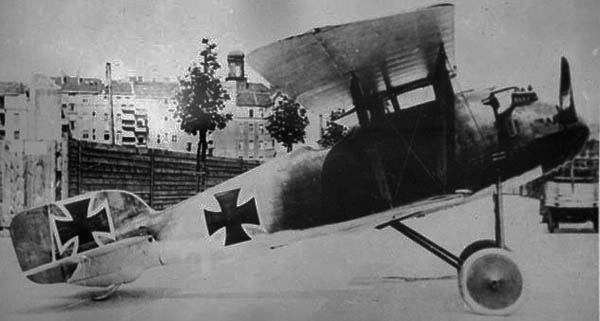
Roland D.III fighter prototype designed by Dipl Ing Tantzen (1916)
Roland did not stopped its operations after the war, bt went on producing civilian aircrafts in small quantities, like the V 3 Susanna, a pusher flying boat, V 13 and V 130, Strela floatplane airliners or the V101 Jasmund, V39 trainer, V40 and V42 two-seat sports monoplanes, while the company was relocated at reopen in Seddin in Pomerania, manufacturing also balloons and life boats but production stopped in 1933 and the company was shut down and its assets sold.
LFG models History
The serie started with the successful C.II und C.IIa “Walfisch” biplane reconnaissance two-seaters, of which 400 were introduced for the Luftstreitkräfte in 1916, after a first flight in 1915. The next C.III was a prototype variant of C.IId, tested but destroyed by fire when the LFG plant burned on 6 September 1916. Another prototype was the C.V, a two-seat version of the D.II, tested but not followed by any order. The C.VIII was yet another prototype, but few informations are available. The C.X was another two-seater reconnaissance biplane. The D.I “Haifisch” was the first biplane fighter of the company, fitted with a top wing mounted on fuselage, which served a bit like a preserie (20 built). It was overshadowed by the D.II, fighter of which about 230 were built. The next D.III saw only three prototypes built and tested. The D.IV (LFG Dr.I) was a triplane, which stayed a the prototype stage followed by the D.V a D.III variant also produced to three prototypes. The next D.VI was a good fighter ordered to 350 planes. It was similar to the D.III and ordered as backup for the Fokker D.VII in 1917.
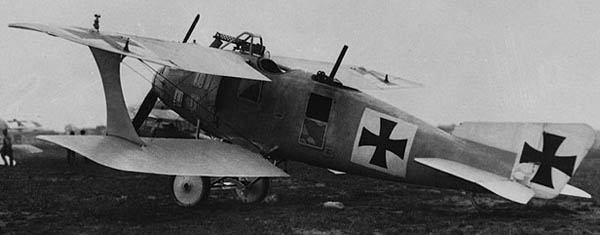
It was followed by other fighters, mostly prototypes of 1917-1918, like the D.VII, D.VIII, or D.IX (three prototypes built), while the next stayed as paper projects D.X, D.XI, D.XII while the D.XIII was started but abandoned after the manufacture fire. The D.XIV fighter was a variant of the D.XIII, actually built and tested but showed it was unreliable. It was superseded by the D.XV a classic fighter of which three (first version) were built and tested, followed by modifications leading to two planes of the second version. The D.XVI fighter also led to a few prototypes, but was still using the same formula, but the next D.XVII was a 1918 promising parasol-wing monoplane fighter of which one prototype and tested. The G.I was single engine biplane bomber prototype, followed by two paper projects, the the ME 8 Seaplane fighter and the MD 14 reconnaissance plane.
 Roland D.VIb (1917), the alternative fighter which competed with the Fokker D.VII
Roland D.VIb (1917), the alternative fighter which competed with the Fokker D.VII
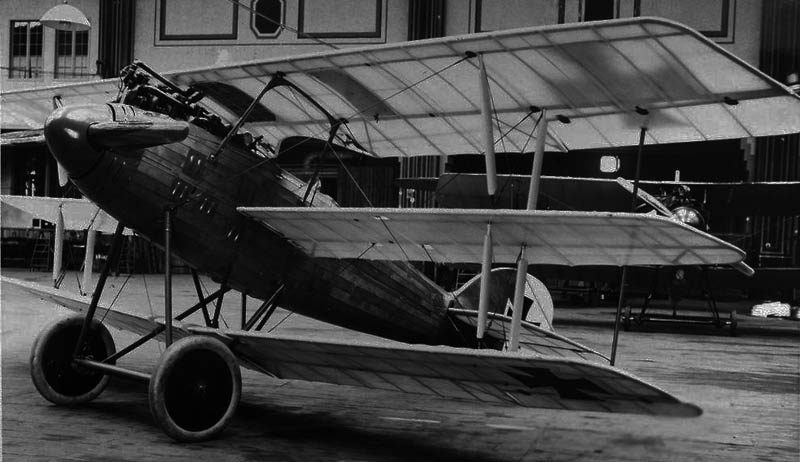 Roland D.IV Triplane
Roland D.IV Triplane
Models list
As usual like the other pages, this list comprised prototypes or very short series which will not be seen in detail, and production ones, expressed in bold. Production figures are sometimes ellusive.
- C.II/C.IIa “Walfisch” 1915 reconnaissance biplane 1915 (400)
- C.III prototype 1916 (1)
- C.V 2-seat D.II prototype conversion (1)
- C.VIII prototype 1917 (1)
- C.X Reconnaissance biplane 1917 (1)
- D.I “Haifisch” biplane fighter (20)
- D.II fighter 1915 (230)
- D.III fighter 1916 (3)
- D.IV triplane 1916 (1)
- D.V biplane fighter 1916 (3)
- D.VI fighter 1916 (350)
- D.VII fighter prototype 1917 (1)
- D.VIII fighter prototype 1917 (1)
- D.IX fighter prototype 1917 (3)
- D.XIII fighter prototype 1917 (1)
- D.XIV fighter prototypes 1917 (3)
- D.XV fighter 1917 (5)
- D.XVI fighter 1917 (c2)
- D.XVII – parasol monoplane fighter 1918 (1)
- G.I bomber 1918 (1)
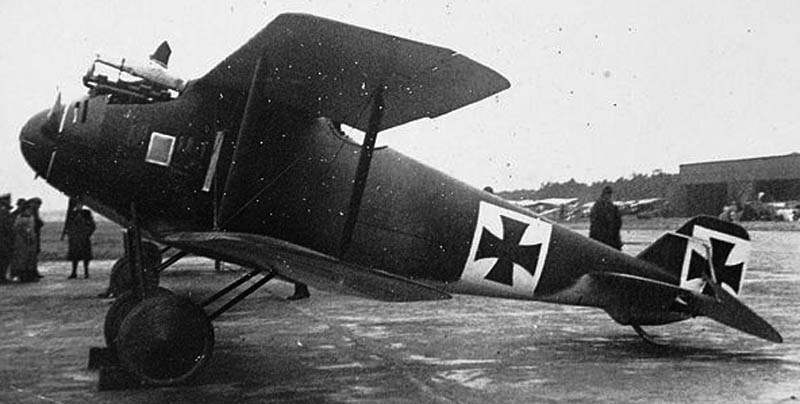 LFG Roland D.I (1916)
LFG Roland D.I (1916)
Read more/Sources
https://en.wikipedia.org/wiki/Luft-Fahrzeug-Gesellschaft
Luftverkehrsgesellschaft m.b.H. (L.V.G.)
Origin
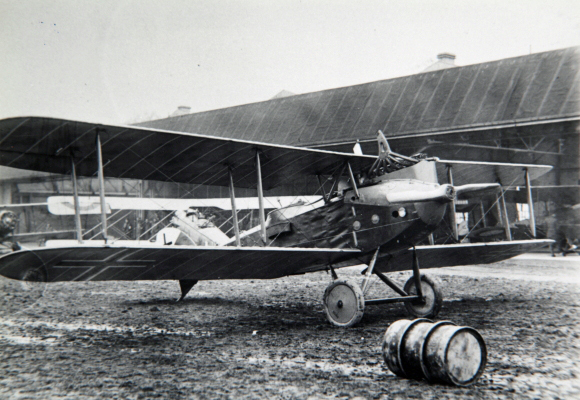
LVG C.VI (wikimedia commons)
This German aircraft manufacturer was based in Berlin-Johannisthal, and started operations in 1912, focusing on Farman-type biplane pushers. LVG started operation of dirigibles before turning in 1912 its attention to heavier-than-air. In 1914, LVG had already turned to military aircrafts, and concentrated mostly on reconnaissance types and light bombers with a production estimated to about 2,000. The C.VI was by far the most successful model of the whole serie. In fact the 1916 raid on London was conducted by one LVG C.IV, dropped its bombs near Victoria station, and shot down by French AA gunners on its way home. Other aircraft manufactured at LVG: The Albatros B.II and C.II, Gotha G.IV and Sablatnig SF.5.

LVG B.I (wikimedia commons)
The C serie began with the B.I, the company’s first original design. The B.I was an unequal-span two-seat biplane with a fixed tailskid landing gear with a 80 kW (100 hp) Mercedes D.I engine in a tractor configuration. production records are unknown but either limited to a few prototypes or a short preserie. The B.II was the main production version, developed with an upper wing cut-out for better pilot vision and help spotting ground objectives. It was fitted with a 90 kW (120 hp) Mercedes D.II engine and entered service in 1915. It was mainly as a trainer like most small production airplanes, and for unarmed reconnaissance. The next variant was the B.III strengthened structurally to be used as a two-seat trainer with a double steering. Production of the latter is unknown. The B.II was also used by the Bulgarian Air Force and Ottoman Air Force, and after the war the Royal Danish Air Force.

LVG C.II (wikimedia commons)
The C.II was developed from the B.I, but with the pilot and observer’s positions reversed. In addition the observer cockpit was given a ring-mounted machine gun for defense. Heavier, the plane required a much powerful Benz Bz.III inline engine, but few of these C.I’s were built as the C.II was introduced which incorporated structural improvements and yet a more powerful engine. The C.II bombed London on 28 November 1916. the first planes to do so after Zeppelins in 1915.
The next LVG C.III was a single experimental aircraft, with observer and machine gun moved to front in a single tandem seat cockpit. The C.IV was slightly larger, and propelled by a 160 kW (220 hp) Mercedes D.IV engine. It is unknown if any production took place. The C.II was used also by the German Navy, and the Swiss Air Force after the war. The C.V a two-bay biplane with a plywood covered fuselage with unstaggered wings of equal span plus tandem open cockpits for the pilot and observer. Its ailerons on the upper wing featured large aerodynamic balances. After the war, about 150 were captured and reused by Polish forces and therefore other incidental users became Russia, Latvia, Lithuania, and Estonia (about 30 aircraft in all). The C.V was also used by the Ottoman Air Force.
The C.VI was the most famous and produced plane of the company.

LVG Eindecker E.I prototype (wikimedia commons)
The Eindecker E.I was a 1915 fighter prototype designed by Franz Schneider, of relatively unusual conception as it was a two-seat model and featured ailerons as opposed to the the usual wing warping system. It was propelled by a Mercedes D.II, 89 kW (120 hp) and was armed with a rear firing machine gun on a flexible ring mounting, and forward synchronized machine gun. By that time this made it a heavy fighter, unheard of for monoplanes. The only prototype was destroyed en route to testing.
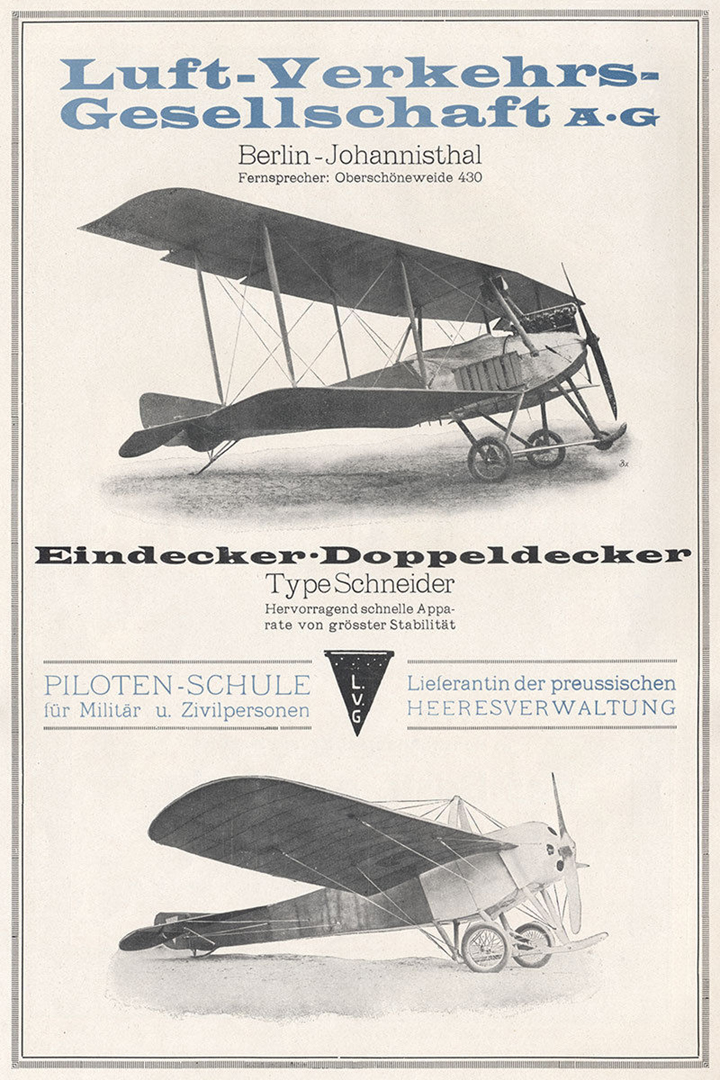
LVG advertising (wikimedia commons)
- LVG B.I recce/trainer 1914 (5?)
- LVG B.II recce/trainer 1915 (c100)
- LVG B.III trainer aircraft 1915 (c50)
- LVG C.I recce (5?)
- LVG C.II – recce (c300)
- LVG C.III (1)
- LVG C.IV recce (1)
- LVG C.V recce (c400)
- LVG C.VI – (1,000+)
- LVG C.VIII (1)
- LVG C.IX Project
- LVG D 10
- LVG D.II (1)
- LVG D.III (1)
- LVG D.IV (1)
- LVG D.V (1)
- LVG D.VI (1)
- LVG E.I (1)
- LVG G.I bomber ()
- LVG G.II triplane ()
- LVG G.III triplane bomber =Schütte-Lanz G.V ()
Read more/Sources
https://en.wikipedia.org/wiki/LVG
Pfalz Flugzeugwerke
Pfalz Flugzeugwerke (PFW) in a nutshell
Pfalz Flugzeugwerke was located at the Speyer airfield, Palatinate state, Bavaria, Southern Germany. The company was created by Alfred Eversbusch, the son of a foundry owner in Neustadt an der Weinstraße. He patiently crafted his own airplane in 1912, and in June 3, 1913, felt confident enough to fund a proper company, Pfalz Flugzeugwerke, registered by his brothers Alfred and Ernst Pfalz, and his brother-in-law Willy Sabersky-Müssigbrodt. Its future was secured by investors Richard and Eugen Kahn and August Kahn.
They proposed at first to go for ready-made proven designs of Albatros under licence, but were found unable to obtain a fair deal. They also approached Gustav Otto Flugzeugwerke, and indeed were able to built his pusher-propeller biplane in small quantities. One was sent to Africa and did served after a long tour. But soon the workshop proved too small and the staff decided to move on the new airfield in Speyer. Their attempt to purchased a terrain was at first unsuccessful.
But they ended building their pushers in the unused Speyer Festival Hall. On February 6, 1914 at least, the city was convinced to sell to Pfalz 7,000 m² of land to build their factory. It was ready for operation in July 1914, just in time for World War I. From then on, the company quickly specialized on its own series of fighters, the A and E series derived from the French morane, the C types from the Rumpler C.IV; and star models as the Pfalz D.III and Pfalz D.XII which at the time gained as much fame as Fokker and Albatros fighters. It stopped after the end of the war, but the company will return in aircraft construction in the 1970s.

Pfalz D.III, best known of all these Bavarian fighters
But the Versailles treaty bankrupted the company, as the area has fallen under French occupation zone, which confiscated all of the equipment. The factory halls remained and were re-used by various companies until conversion for part manufacturing. Banckrupt in 1932, by October 1937 the company was reborn as Saarpfalz Flugwerke, and aircraft maintenance company. Speyer airport was rebuild by the city, 1938 and the company amounted to 500 personal when the war broke out. During WW2, the company maintained Focke-Wulf Fw 58, Heinkel He 45, He 46, He 51 and He 111, Junkers Ju 52, and Ju 88. From 1954 the company produced some 3,800 Heinkelkabine (bubblecars) and the company went on producing the Transall C-160 during the 1970-80s, and parts for UH-1 Iroquois and CH-53 Sea Stallion, in association with VFW.
In went on later as an helicopter repair center for MBB and was merged with Deutsche Aerospace in 1989. From 1997 it was known under the name PFW or Pfalz Flugzeugwerke, now part of DASA.

Pfalz E.II Eindecker, a 1914 model based on the Morane-Saulnier
After Otto early models, time was ripe for mass production with a model that could be purchased in droved by the government. A license to produce Morane-Saulnier L monoplanes was acquired just before the war. This led to the Pfalz E series. But these became obsolete in 1915, and the company swapped to the proven LFG Roland D.I and D.II, although the latter was produced well into late 1916, being obsolete by then. The Pfalz C.I were Rumpler C.IV built under licence with minor improvements (300), renamed in 1917 Rumpler C.IV (Pfal). Meanwhile, Pfalz licensed the patented Roland Wickelrumpf (wrapped-fuselage) plywood strip-covered semi-monocoque fuselage design. Pfalz then tried to combine it with the brand new 160 hp D.III engine from Mercedes. This became the Pfalz D.III, first proper fighter from the company, and a success when it entered service in August 1917. However it was still not on par to the Albatros D.V, but found a niche role against observation balloons and still could escape enemy fighters thanks to a high diving speed. With 600 D.IIIs and modified D.IIIas until the summer of 1918 it marked the era. The D.III cell was adapted with the new Siemens-Halske Sh.III rotary engine. This led to the Pfalz D.VIII which had an amazing rate of climb (shared with the Siemens-Schuckert D.IV) but the engine proved unreliable mainly because of the poor ersatz engine oil used, thus reducing D.VIIIs orders and overall production. Only Jasta 2 (headed by the ace Oswald Boelcke) deployed it in large quantities, but the other few were only spread between Jastas in unknown quantities. This model was further developed into a triplane as the Pfalz Dr.I, Competing at Adlershof in January 1918. But it was powered by same Sh.III engine and trembled when facing its competitors using the Oberursel UR.II, but it won nevertheless. It was due to the fact that was the purpose-built triplane and about a dozen were built and used operationally.
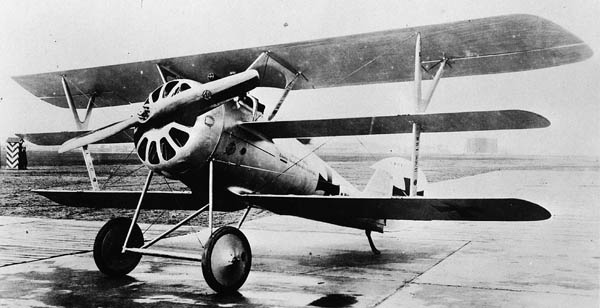
Pfalz Dr.I, an amazing triplane that won the 2nd fighter competition of 1918, but only a few saw service.
The last models built by Pfalz were Pfalz D.XII, a development of the D.III with a two-bay wings configuration (and not sesquiplane) rather similar to the French SPAD fighters. It ended #2 on the June 1918 Fighter Competition against the Fokker E.V parasol monoplane and was a match for the excellent Fokker D.VII, albeit considered less agile and easy to fly, difficult to land. Production was rushed nevertheless and about 800 left the factory floor before the Armistice of which some made it to the frontline during the last months of the war. The Allies captured a lot of them and some were featured in movies like Hell’s Angels and The Dawn Patrol. The very last Pfalz project were a D.XII project called the D.XIV which stayed at prototype stage and was never officially tested or ordered. The D.XV participated in the Third Fighter Competition and impressed the Idflieg, that ordered it into production just before the Armistice. None became operational but this ultimate model was very promising. The company survived as A.G. Pfalz in 1919 but deprived of everything it was bankrupted in 1932.

Pfalz D.XV (1918), an excellent fighter that was ordered too late to make a difference
Pfalz Planes models
Here are listed all models produced by the company, prototypes in majority. Production models are in bold, with production records (if known or approximative) between brackets. For a detailed overview of production models see the part under this list, “production models in detail”. About Pfalz prototypes: (To come)
- Pfalz A.I/II reconnaissance monoplane 1914 (60)
- Pfalz C.I (Rumpler C.IV) reconnaissance armed biplanes 1915 (300)
- Pfalz E.I monoplane fighter 1915 (74)
- Pfalz E.II monoplane fighter 1915 (80)
- Pfalz E.III monoplane fighter 1915 (20)
- Pfalz E.IV monoplane fighter 1915 (24)
- Pfalz E.V monoplane fighter 1916 (20)
- Pfalz E.VI monoplane fighter 1916 (20)
- Pfalz D type fighter biplane 1916 ()
- Pfalz D.III & IIIa fighter 1916 ()
- Pfalz D.IV fighter 1916 ()
- Pfalz D.VI fighter 1916 ()
- Pfalz D.VII fighter 1916 ()
- Pfalz D.VIII fighter 1916 ()
- Pfalz D.XII fighter 1916 ()
- Pfalz D.XIV fighter 1916 ()
- Pfalz D.XV fighter 1916 ()
- Pfalz Dr.I triplane fighter 1918 (12)
- Pfalz Dr.II triplane fighter 1916 ()
Production Pfalz models in detail
Pfalz A series 1914, the parasol plane

A Morane L captured with german marking, which was very closed to the Pfalz A.I (1914)
These planes were based on the Morane-Saulnier L licence which was acquired by several German companies just before the war broke out. Three versions were built: The A.I was propelled by an Oberursel U.0 engine, the A.II had an Oberursel U.I engine and the E.III (Known also briefly as A.III) was a variant armed with single synchronised lMG 08 machine gun as a fighter. The Pfalz A.I was a single-engine, parasol unarmed reconnaissance plane under license. It was almost identical to the Morane-Saulnier Type L. Previously 8 Morane LA were manufactured for the Bavarian Flying Service in 1913, one of which was sent to Africa in 1914, used for liaisons and reconnaissance in the colonial territories of German East Africa. With the outbreak of the War, the IDFLIEG ordered a serie of unarmed reconnaissance monoplanes under the A designation (two-seater reconnaissance), the first being the A.I.
An experience report of the Feldfliegerabteilung 4b of 26 October 1914 emphasizes numerous advantages for plane production, such as an easy and quick assembly, small footprint when housed and ample supply of spare parts and tools, plus the best performances and good Communication between pilot and observer. The A.I answered the call and was produced but the too narrow space for the observer and defect of the engine were criticized but 60 were built, of which some were later converted as A-IIs.
The Pfalz A.I had two celluloid panels instead of treated canvas on fuselage sides, their transparency, giving greater visibility to the pilot. Also the model used an Oberursel U.0 rotary 7 cylinder air cooled engine rated for 80 PS (59 kW) and close copy of the Gnome Lambda made under license.
Some of the 60 delivered machines were converted in 1915 as fighters. The Pfalz A.II was a reinforced version fitted with the most powerful 9-cylinder Oberursel UI rated for 100 PS (73.5 kW) and apparently armed (austrian source), and true progenitor of the Pfalz E.III, designed as a fighter. Three Pfalz A.II’s were used by the Ottoman Empire against the Arab Revolt led by Lawrence of Arabia. The A.I were used by the Luftstreitkräfte aerial observation and reconnaissance units of the western front until 1915, quickly being replaced by more recent models equipped with defensive armament. The Turkish air force received 10 A.Is, and four flew under the command of Captain von Auleck of Baghdad against the Allied Expeditionary Force in Mesopotamia. On July 31, 1915 another plane from the Fliegerabteilung or Bayerische Feldflieger Abteilung 9b bombarded Italian positions in the Alps, although officially no state of war existed between Italy and Germany. From 1915, the majority of these machines were withdrawn from the front and used in flight schools.
Specifications
Dimensions 6,9 m x 11,2 m x 3,4 m, 18,0 m² wing area
Weight 365 kg/595 kg
Propulsion: Oberursel U.0 80 PS (59 kW)
Performances: Top speed 135 km/h, climb in 800 m in 6 min, 4 h autonmy.
Pfalz Eindecker series 1915-1916
Pfalz E.I (1915)
The E.I was based by the second licenced aircraft purchased before the war, the French Morane-Saulnier Type H which was a mid-wing monoplane. This model was less suited for reconnaissance but more as a fighter, armed with a synchronized machine gun. The E.I was the first of a lineage, introduced on the Western front in October 1915. It was propelled by an Oberursel U0 rotary piston engine rated for 80 horsepower. The entire structure was made of wood and canvas, with a fixed, wheeled undercarriage fitted with a skid pointed to the rear, and a single vertical fin wwith low-mounted horizontal planes. A single 7.92mm LMG 08/15 machine gun was mounted on the cowling, but some had this armament removed to perform high-speed reconnaissance runs. The E.I prototype was tested by the Idflieg and approved, certified in September 1915. Production went on the next month; By April 1916 37 has been produced. Most flew over the Western front but a few also saw service in the Middle East during the Sinai Campaign (1916). It weighted 345 to 535 kgs fully loaded, and reached 140 kph with a range of 200 km and ceiling of 3500 m. The E.I had a climb rate of 267m/min. It was never as popular as the Fokker E.I.
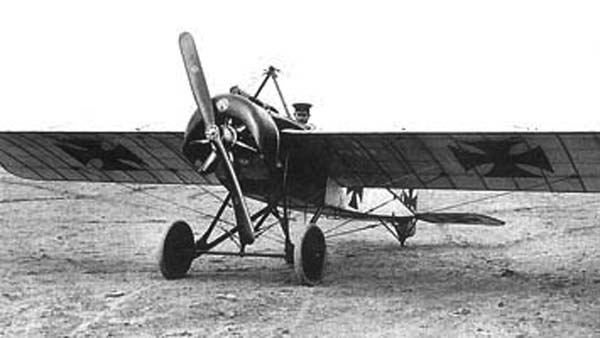
The Pfalz E.II design changed little, but this model received the 100 hp Oberursel. The next E.III revealed in late 1915 had its wings moved to above the fuselage and connected to a central tension mast of trapezoidal section like in the Morane Parasol above the pilot. It was propelled by a 100-hp Siemens & Halske Sh.I engine, fault of available Oberursel engines, in short supply. The types E.IV to E.VI changed little, and relatively few were built. The D.IV was a derivative biplane with stayed only as a prototype.
Despite their good performance, the Pfalz Eindeckers stayed in the shadow of the more agile and powerful Fokker E type. They were considered obsolete in 1916 and replaced in the middle of the year. Only in Palestine with the Abteilung 300, on the eastern front and possibly also in the Balkans, thes E types soldiered on as escort fighters for reconnaissance aircraft. A Pfalz E.II was for example send on 17 July 1916 to the k.u.k. Marine, used until 1 March 1917 as an interceptor to protect Pola.
https://de.wikipedia.org/wiki/Pfalz_E.I-VI
Comparisons of German Eindeckers
Model/Type/delivered/Year/speed
Fokker E.I: 56 1915 130
Fokker E.II: 23 1915 132
Fokker E.III: 258 1915 140
Fokker E.IV: 40 1915-16 160
Hanuschke E.I: 6 1915 130
Pfalz E.I: 74 1915 145
Pfalz E.II: 80 1915 145
Pfalz E.III: 20 1915-16 160
Pfalz E.IV: 24 1916 160
Pfalz E.V: 20 1916 165
Pfalz E.VI: 20 1916
Siemens Schuckert E.I. 20 1916 140
Siemens Schuckert E.III 6 1916 140
Total: 641
The E.Is on ww1 aviation heritage
Read more/Sources
https://en.wikipedia.org/wiki/Pfalz_Flugzeugwerke Generic – Wikipedia Pfalz
http://flyingmachines.ru/Site2/Crafts/Craft30287.htm Pfalz C.I
Rumpler Flugzeugwerke
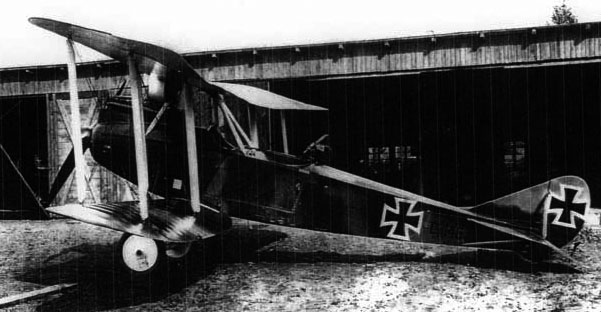
Rumpler C.IV (wikimedia commons)
Rumpler Flugzeugwerke, contracted as Rumpler was a manufacturer founded in Berlin by Austrian engineer Edmund Rumpler in 1909. At that time it was named Rumpler Luftfahrtzeugbau. The first “product” manufactured copies of the Etrich Taube monoplane, known as the “Rumpler Taube” but soon turned to custom reconnaissance biplanes and also ventured into fighters and bombers prototypes during the course of the war. Like many other German manufacturers, Rumpler missed the post-war market and was liquidated in 1920.
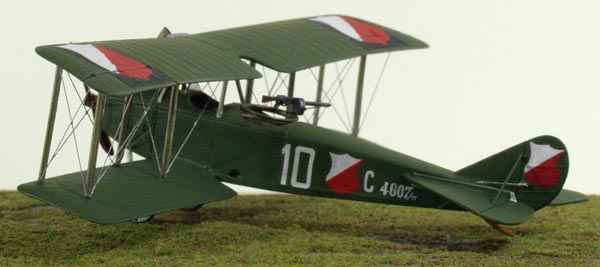
Rumpler C.I model (wikimedia commons)
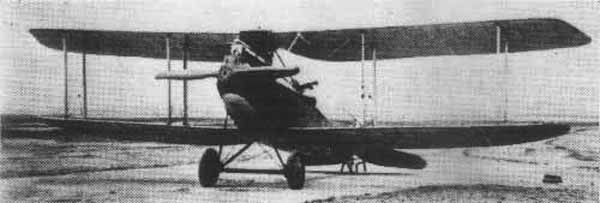
Rumpler C.VII model (wikimedia commons)
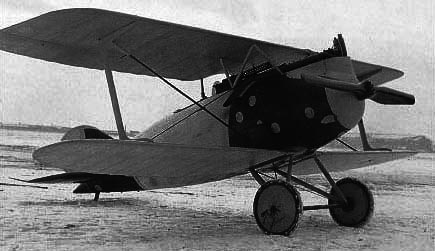
Rumpler D.I model (wikimedia commons)
Rumpler production
The following designations are factory ones for prototypes, followed by the production designation when tested by the Idflieg. Actual production models are in bold. The rest are assumed to be prototypes. When the production is known, it is figured in brackets, but in some case a “?” or an approximation are given (circa or “c”).
- Rumpler Taube – reconnaissance monoplane 1914 (c300)
- Rumpler B.I – reconnaissance 1914 (c225)
- Rumpler 4E – flying boat, 1914
- Rumpler 4A 15 – bomber, 1915
- Rumpler 5A/C.I & Ia – reconnaissance
- Rumpler 5A 15/G.I – bomber, 1915
- Rumpler 5A 16/G.II – bomber
- Rumpler 6A/C.III – reconnaissance
- Rumpler 6B – fighter floatplane 1916 (88)
- Rumpler 6G 2/G.III – bomber
- Rumpler 7C/C.IX – reconnaissance
- Rumpler 7D – experimental fighters
- Rumpler 8C/C.X – reconnaissance
- Rumpler 8D/D.I – fighter
- Rumpler C.IV – reconnaissance
- Rumpler C.V – reconnaissance
- Rumpler C.VI – reconnaissance
- Rumpler C.VII – reconnaissance
- Rumpler C.VIII – reconnaissance
Rumpler B1

Some naval floatplane 6B1 (wikimedia commons)
Under the factory designation 4A, this reconnaissance aircraft was a conventional, unarmed two-bay biplane with unstaggered wings of unequal span. It showed separated open cockpits in tandem for the pilot and observer and was given a fixed tailskid undercarriage. The upper wing was inspired by the Etrich Taube’s design. In all, 198 were built by Rumpler for the Luftstreitkräfte, and 26 seaplanes for the Imperial German Navy. There were numerous factory-designation versions, the 4A/B.I with a Mercedes D.I engine, 4A13 with a balanced, comma-style rudder, the 4A14 with the Benz Bz.III engine, and the maritime 4B series, 4B1 with the Mercedes D.I engine, 4B2 with the Benz Bz.III, 4B11 with the Benz Bz.I and 4B12 with the Benz Bz.III engine. It was also used by the Ottoman aviation, and post-war by the Royal Danish Air Force.
Specifications
Dimensions: 8.40 m (27 ft 7 in), 13.00 m (42 ft 8 in) and 3.10 m (10 ft 2 in).
Weight: 750 kg (1,650 lb)/970 kg (2,100 lb) max takeoff.
Powerplant: 1 × Mercedes D.I, 75 kW (100 hp)
Top speed: 145 km/h (90 mph)
Rumpler 6B1

Some naval floatplane 6B1 (wikimedia commons)
This fighter floatplane was born from a requirement of the Kaiserliche Marine. The Rumpler 6B was was compared to the Albatros W.4 and Hansa-Brandenburg W.9. It was an adaptation of a landplane design, in that case the two-seat C.I reconnaissance model. However for extra lift, a forward stagger was added to the wings, a larger rudder, and the observer’s cockpit was removed. Of course floats were fitted under the wings, fitted on N-type struts. The horizontal tail surfaces was later also reduced. he 6B was armed with a fowrad 7.92 mm (.312 in) LMG 08/15 “Spandau” machine gun mounted on port side of the fuselage, near the engine. The first serie was called 6B-1 and 39 were produced delivered by the end of May 1917. The next 6B-2 appeared in October 1917, retained the Mercedes D.III engine but the structure was the same as the new C.IV. It was larger and showed more rounded horizontal tail surfaces. 49 were delivered until January 1918. In addition to the German Navy, the Rumpler 6B was also used by the Bulgarian Navy, Finnish Air Force and Royal Netherlands Navy.
Specifications
Dimensions: 9.40 m (30 ft 10 in), 12.05 m (39 ft 6 in) x 11ft (6in)
Takeoff weight: 1,140 kg (2,513 lb)
Mercedes D.III 6-cylinder, liquid-cooled inline engine, 120 kW (160 hp)
Performance, top speed 153 km/h (83 kn, 95 mph), range: 4 hours, 5,000 m ceiling.
Blueprint of the 6B1 (wikimedia commons)
Read More/Sources
https://en.wikipedia.org/wiki/Rumpler
Sablatnig Flugzeugbau GmbH
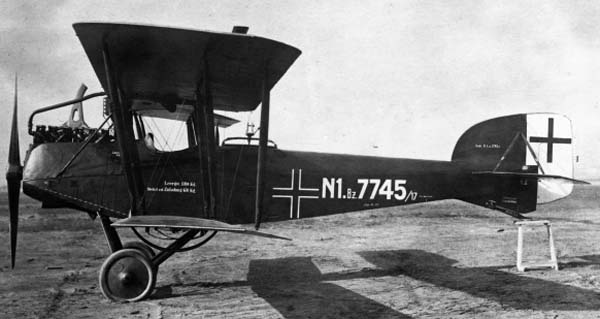
Sablatnig N I in 1916 (wikimedia commons)
This German aircraft manufacturer emerged thanks to the efforts of Dr Josef Sablatnig, a renowned Austrian engineer, and aviation pioneer. Sablatnig graduated in 1904 in Klagenfurt and then studied mechanical engineering at the Technical University of Graz, joining the Graz academic fraternity Allemannia, where he stayed a member until he passed out in 1946 at Buchenwald. He was received at the electrical engineering at the University of Brno and was graduated in 1909. A vehicle designer and racer, he later heard of the first flight and paid a visit to the Wright brothers in the United States, for which he worked for some time and bought them in 1910 an aircraft in Berlin. In 1911 he was naturalized and became a German citizen in Prussia. Her worked for some time in Louis Blériot workshops and afterwards in Wiener Neustadt with the company Autoplan. He also flew himself, and was a passionated and gifted pilot. He was considered the first night pilot, setting before the War several high altitude records and a distance record with the Lilly Steinschneider as a passenger. During WW1 he was a volunteer in Kiel, helping building a naval air force. But in 1915 he founded his own aircraft manufacture, Sablatnig-Flugzeugbau GmbH, and went on producing small series of floatplanes, the Sablatnig SF 2, SF 5 and SF 6. They received praised and soon he was overwhelmed by production orders. After the war, his good connections allowed him to use his planes for flight courier services in government order by 1918-19. After World War I, Sablatnig was one of the rare company to successfully convert to the civilian market, and in August 1919 offered the government subsidised services between Berlin and Bremen on the tailor-built Sablatnig P.III with the Norddeutscher Lloyd company. Some 40 Sablatnig P.III were manufactured and , making it one of the largest airlines of the time.

Sablatnig C.I, 1917 (wikimedia commons)
After the war, Sablatnig converted naval aircraft to civilian airliners on the line Berlin-Warnemünde. In 1919 he built the SAB P.I designed for the first German foreign line which opened on 21 April 1919, on scheduled service to Copenhagen and Stockholm. The mass-built SAB P.III was designed by Hans Seehase. Sablatnig was the co-founder of the Dansk Luftexpress and partially acquired the Stockholm-Gothenburg line. He also co-created the aviation industry association. In 1920, he co-created a shipping company called the Lloyd Luftverkehr Sablatnig, merging with a subsidiary of the North German Lloyd between Berlin and Hesse. Victor Entler became head of the design team. In 1923, Lloyd became German Aero Lloyd after some mergings and in 1926 with the Junkers air transport AG, and air Hansa. But the Treaty of Versailles forbading all activities in aviation Sablatnig concentrated in the automotive industry through Sablatnig-Beuchelt and it was not until 1931 that he returned to aircraft construction. He worked at Junkers Flugzeugwerk AG. He was imprisoned on 16 June 1945 in Berlin by the Soviets and transferred to the Soviet special camp of Buchenwald, where he died in 1946.

Postwar service: Two Sablatnig P.III (the parasol ones) along with Junkers F.13s at Lasnamäe Airfield, Estonia in 1925. (wikimedia commons)
Sablatnig Models
Models in bold are production models. Total production of Sablatnig planes (according to various sources) is about 130 planes, both floatplanes and land ones. These were generally successful but the company was not able to fulfill orders due to its small size, almost workshop-like. Despite this, his planes were so renown for their reliability that his civilian era business too off. In this section we will concentrate in all these models in detail, despite sometimes the lack of information.
- Sablatnig SF-1 two-seat floatplane 1915 (1)
- Sablatnig SF-2 reconnaissance/trainer floatplane 1916 (26)
- Sablatnig SF-3 floatplane fighter 1916 (1)
- Sablatnig SF-4 floatplane triplane fighter 1916 (1)
- Sablatnig SF-5 reconnaissance floatplane 1917 (91)
- Sablatnig SF-6/B.I trainer 1917 (1)
- Sablatnig SF-7 floatplane fighter 1917 (1)
- Sablatnig SF-8 floatplane trainer 1918 (3)
- Sablatnig C.I reconnaissance 1917 (2)
- Sablatnig C.II reconnaissance 1918 (1)
- Sablatnig C.III reconnaissance 1918 (1)
- Sablatnig N.I night bomber 1918 (1)
Read More/Sources
https://en.wikipedia.org/wiki/Sablatnig
Heinz J. Nowarra; Bruce Robertson; Peter G. Cooksley. Marine aircraft of the 1914-1918 War. p. 62.
Luftfahrzeugbau Schütte-Lanz

Schütte-Lanz G.I Bomber
The company was founded by industrialist Karl Lanz and engineer Johann Schütte, on April 22, 1909 in Rheinau. The factory was located in Brühl, near Mannheim. They started creating airships, which main difference from Zeppelin models layed in their construction material, with a wooden skeleton. However postwar pkans included four airliners and a research airships were planned with duralumin skeleton like Zeppelins. Meanwhile, the company concentrated on more lucrative military airships. Whereas at its second plant in Zeesen in Brandenburg, the company manufactured some 500 aircraft. After the First World War the Treaty of Versailles banned any production, both for planes and airship construction, and the company was dissolved in 1925. However the Schütte-Lanz-Werke AG in Königs Wusterhausen-Zeesen convertied existing assets to manufacture automobiles bodies under the S.L. designation and launched a proper model in 1922-1924, a passenger car with a 4/14-horsepower engine under the name Schütte-Lanz. It was possible to transfer some technological knowhow from airship construction to other areas like mainly plywood construction however, and the name survived as Finnforest Schütte-Lanz GmbH, still near Mannheim, Germany, making formwork panels. It was closed at the end of 2007, and the facilities dismantled. The “Gewerbepark Schütte-Lanz” halls from 1911 are waiting for better times but the fireplace was destroyed. It is now open for housing, recreational and working areas;

Schütte-Lanz D.III Fighter
Schütte-Lanz aircraft Models
In 1915 the airplane division of Schütte-Lanz Luftfahrtzeugbau was organized on the outskirts of Mannheim and its first original development was a wooden prototype two-seater. So the first model from the company in 1915 was the reconnaissance scout biplane called the Schütte-Lanz C.I. (photo) It had a conventional configuration for a pusher, 7.70m wingspan for 5.20m long. As the designation suggested, it was armed, the observer being given a scarff-mounted light 7.92-mm Parabellum machine gun in the forward section of the nacelle. The latter was mounted relatively high on struts compared to the lower wing and wheeltrain. The pilot layed under the main upper wing and his visibility was reduced contrary to the observer. The small tail unit layed under the main ailerons. The C.I was powered by a Mercedes D.III engine rated for 160 hp. Tests showed some structural and stability problems which led to its rejevtion, but the C.I became the first step in a long serie of prototypes and small production planes.
Schütte-Lanz fighters
The Schütte-Lanz D.I was the first prototype fighter of the company. This model was developed in its plant in Zeesen in Brandenburg, created in 1915 as a replica of the British Sopwith Tabloid. It was notorious as the first German combat biplane, but underestimated and rejected by the Army at that time, still convinced only monoplanes were suitable as fighters, notably because of better visibility. A situation which was ironically the exact reverse of what happened with the RFC, which estimated monoplanes too dangerous and banned them. Planned further development of this sole prototype led to D.II powered by a stronger 100 HP Mercedes in-line engine. But it was tested and also rejected for production. By 1916, the D.III and D.IV were developed in parallel. The Schütte-Lanz D.III was a singular biplane with wings connected by V-struts of varying lenght like the Nieuport 11 sesquiplane and an aerodynamically refined cowling and nose to house the Mercedes D-III in-line engine. As a result, the D.III was quite fast for its time. Nevertheless, it was tested and rejected again because of poor flying characteristics. The Schütte-Lanz D.IV had a stronger 220 hp Benz-Bz-III engine but showed even weaker performances and only two prototypes were tested. The planned development of the D.V was delayed until the new supercharged Mercedes D III was available. Also in parralel, a single D.III was converted as a triplane, designated Schütte-Lanz Dr.I. It was also tested but rejected. At last in 1917 the Schütte-Lanz D.VI appareared with 160 hp Mercedes D-III engine as a mixed sesquiplane-monoplane parasol, which upper wing was supported by wide, wing-like struts. A single prototype was built in 1918, flying for the first time on May 29, 1918, but soon turned over and crahed, totally destroyed in the accident. The Schütte-Lanz D.VII returned to the D.III solution with the D.III Mercedes, and three prototypes were built, still in trials when the war ended.
Schütte-Lanz bombers

Schütte-Lanz G.I bomber after a rough landing.
Models list, in detail
As you can see, the Schütte-models were prototypes. Despite making interesting proposals, these planes were all rejected for production, chiefly because of unsufficient flying characteristics. Mostly they were biplanes, but there was a single parasol model and a triplane. The number in bracket at the end is the estimated “production”.
- Schütte-Lanz C.I (1915)- reconnaissance pusher (1)
- Schütte-Lanz D.I (1915)- fighter, possibly a copy of the Sopwith Tabloid (1)
- Schütte-Lanz D.II (1915)- fighter re-engined D.I with Mercedes inline. (1)
- Schütte-Lanz D.III (1916)- fighter (3)
- Schütte-Lanz D.IV (1917)- fighter biplane (1)
- Schütte-Lanz D.VI (1917)- monoplane parasol fighter with lifting struts (1)
- Schütte-Lanz D.VII (1918)- fighter biplane (3)
- Schütte-Lanz Dr.I (1916)- triplane fighter (1)
- Schütte-Lanz G.I (1915)- large fighting aircraft
- Schütte-Lanz G.III (1915)- bomber
- Schütte-Lanz G.IV (1916)- bomber
- Schütte-Lanz G.V (1917)- bomber
- Schütte-Lanz R.I – heavy bomber project
Schütte-Lanz airships 1909-1917
Zeppelin is frequently thought to be Germany main and sometimes only airship manufacturer. In reality series of rigid airships were designed and built by other manufacturers, one of the most prolific and successful being the Luftschiffbau Schütte-Lanz from 1909 until the S.L.22 delivered in 1917. Research and passenger airships were also planned for post-war use.
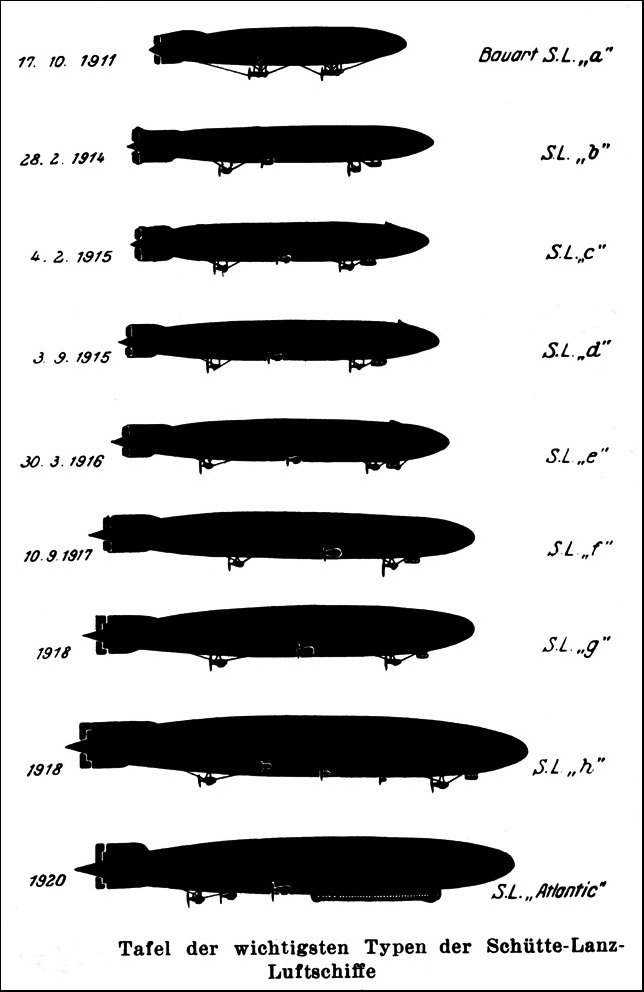
Schütte-Lanz airships (wikimedia commons)
Read more/Sources
https://en.wikipedia.org/wiki/Sch%C3%BCtte-Lanz_G.I
Luft-Fahrzeug Gesellschaft
Schütte-Lanz airships
German airships zeppelinmuseum.de
Siemens-Schuckert
History of the company
Siemens Schuckert was founded in 1903 when Siemens & Halske acquired Schuckertwerke. The former specialized in communications engineering and the final merged company in power engineering and pneumatic instrumentation. Due to its skilled workforce, engineers and assembly space, the company turned to military contracts during the war and the production of aircraft. In 1908 already the company had experience in designing original vehicles. After a long exclipse, the company will return to aircraft production during WW2 at Monowitz near Auschwitz, using slave labor from nearby Bobrek concentration camp. The Siemens Schuckert logo was still used into the late 1960s before the companies merged with the Siemens-Reiniger-Werke AG, now Siemens AG.

SSW R.VIII heavy bomber 1918 (wikimedia commons)
Siemens-Schuckert models in detail
The company produced also aircraft engines under the Siemens-Halske brand, which evolved after World War I into Brandenburgische Motorenwerke, or simply Bramo, in 1936, and purchased in 1939 by BMW Flugmotorenbau. Although the company is best known for its high performances, late interceptors, it designed and produced in fact a large range of heavy bombers which complemented the Gothas. Its SSW R-series designed for strategic (long range) bombing mission, were characterized by three 150 h.p Benz Bz.III engine inside the fuselage, the propellers being cranked by external gear boxes mounted on the struts. This allowed in the case of engine failure, extremely common at the time,to be repaired in relatively comfortable conditions by the in-flight mechanic. However despite military designation they were prototypes, in total nine were manufactured. Read More: https://en.wikipedia.org/wiki/Riesenflugzeug#SSW

The unique Siemens Schuckert B (fyingmachines.ru)
The other “folder” of the company was its flirt with Fighters. The first one was the Bulldogge, or “Bulldog”, based on a pre-war design constructed for Prince Friedrich Sigismund of Prussia. Two monoplanes were built, that differed only in the disposition of their engine, a 100 hp Siemens-Halske Sh I, or a 100 hp Mercedes D I. Completed early in 1915, they were showcased and tested but declined by the idflieg for production due to their poor performance and agility. Four photos exists at least of these planes. The unique “B-type” was a single prototype, built in 1915 for reconnaissance with equal span, straight edged, constant chord wings mounted without stagger. They had parallel pairs of interplane struts crossed with additional diagonal strut and bays plus diagonal flying wires. Outward leaning N-form struts were fitted on the upper fuselage and fully semi-circular cut-out for the pilot’s vision. It was propelled by a 110 hp (82 kW) Siemens-Halske Sh.I nine cylinder rotary engine (153 kph (95 mph; 83 kn)). The prototype was sent for operations to the communications centre at Ostend. It crashed and the parts were retrieved by Siemens-Schuckert and recycled to built the E.II monoplane.

Siemens-Schuckert Forssman (wikimedia commons)
The Siemens-Schuckert DD 5 was the first fighter developed by the company. The design was signed by the Steffen Brothers, Franz and Bruno, as a single seat fighter which was completed in the autumn of 1915. This plane bore a strong resemblance to the earlier Type B. It featured tapered wings with steel tube and a plywood covered fuselage like the Eindecker series. It was propelled by a 110 h.p. Siemens-Halske Sh I. and armed with a single cowl-mounted synchronized Spandau machine-gun. It was shown to the Idflieg but not ordered. Rejection was due to poor aerodynamic qualities and bad cockpit visibility. The company also produced a serie of Eindecker starting in late 1915 with the E.I, of which 20 were built, followed by a single E.II prototype and six E.IIIs (See blow). The D series fighter was the best known. Many however stayed at prototype stage, like the D.II, D.V, D.VI which for the latter, first flew in 1919. Small, agile and very powerful despite their unreliable engine due to the ersatz oil used, the D.III and D.IV were probably among the best fighters on the Western front, although in quantities they never reached the level of the Fokkers and Albatros, a pinprick in comparison of the staggering numbers of SPADS, SE.5 or Sopwith delivered by the allies.

Siemens-Schuckert D.III (wikimedia commons)
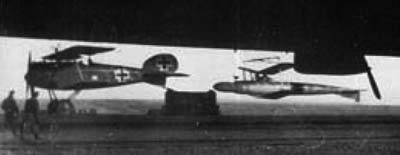

Siemens-Schuckert Torpedogleiter, unmanned flying torpedo towed by an Albatros D.III, and below, in a workshop.
Perhaps the most forward-thinking device ever created were the unmanned, radio-controlled glide bombs and torpedoes made by the company. In fact the carrying system was the biplane, with controls, tails and wings, which opened itself by the belly to deliver its payload. It was towed and dropped at the right distance, then the operator used radio frequences proper to the guidance system to guide it visually to the target. This way the plane stayed out of harm’s way because of the limited range AA naval artillery of the time. More: http://warnepieces.blogspot.com/2011/12/guided-missiles-world-war-one-style.html
- Siemens-Schuckert Bulldogge single-seat monoplane, 1915 (2)
- Siemens-Schuckert B type reconnaissance biplane 1915 (1)
- Siemens-Schuckert DD 5 fighter biplane 1915 (1)
- Siemens-Schuckert D.I/D.Ia fighter 1916 (95)
- Siemens-Schuckert D.II fighter prototypes 1917 (c5)
- Siemens-Schuckert D.III fighter 1917 (80)
- Siemens-Schuckert D.IV fighter 1918 (123)
- Siemens-Schuckert D.V fighter 1918 (3)
- Siemens-Schuckert D.VI fighter 1919 (2)
- Siemens-Schuckert Dr.I fighter 1917 (1)
- Siemens-Schuckert DDr.I fighter 1917 (1)
- Siemens-Schuckert E.I monoplane fighter 1915 (21)
- Siemens-Schuckert E.II monoplane fighter 1915 (1)
- Siemens-Schuckert E.III monoplane fighter 1915 (6)
- Siemens-Schuckert L.I (G.III) 1917 (1)
- Siemens-Schuckert R.I heavy bomber 1915 (1)
- Siemens-Schuckert R.II heavy bomber 1915 (1)
- Siemens-Schuckert R.III heavy bomber 1916 (1)
- Siemens-Schuckert R.IV heavy bomber 1916 (1)
- Siemens-Schuckert R.V heavy bomber 1917 (1)
- Siemens-Schuckert R.VI heavy bomber 1917 (1)
- Siemens-Schuckert R.VII heavy bomber 1918 (1)
- Siemens-Schuckert R.VIII Heavy bomber 1918 (1)
- Siemens-Schuckert R.IX heavy bomber 1918 (design study)
- Siemens-Schuckert Forssman heavy bomber 1915 (1)
- Siemens-Schuckert Torpedogleiter (radio control glide bombs) 1918
Siemens-Schuckert Serial Models
Siemens-Schuckert Eindecker
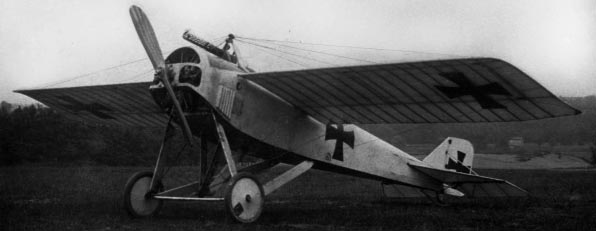
Siemens-Schuckert E.I (wikimedia commons)
The Siemens-Schuckert E.I (Eindecker or “monoplane”) was a German fighter aircraft which first flew in late 1915. The wings were wire braced and it was powered by the Siemens-Halske Sh.I rotary engine, armed with a single LMG 08/15 machine gun. The Idflieg tested it and it was approved for a lmited production: Only 20 models were delivered which reached the front in early 1916. This model was followed by the E.II, a single prototype powered by 89 kW (120 hp) Argus As.II inline engine, later destroyed in an accident, which stopped all development. The last Eindecker was the E.III, of which only 6 were delivered. It was powered by a 75 kW (100 hp) Oberursel U.I, 9-cylinder rotary engine (Gnome Delta copy).
Read more/Sources
https://en.wikipedia.org/wiki/Siemens-Schuckert
http://www.eeoda.de/2008/0811_FB2_Lufttorpedos-1.pdf
Other Manufacturers and Prototypes
From shipyards to single obscure prototypes

BFW CL.I support/recce two-seats biplane (sec. flyingmachines.ru)
German aircraft production was no less plentiful than in Entente countries, since the Reich had the industrial capabilities, the engineers and designers required, only lacking materials, due to the blocus, to achieve the staggering production numbers displayed by the West. Some heavy bomber models were produced by airships manufacturers, like Zeppelin, some floatplanes were manufactured by a branch of famous German shipyards, other were small workshops that started working for other manufacturers and created their own model, or some were just one-off projects in the hope to answer an official specification. At that early stage of aircraft technologies, development times were very short as the machines were rudimentary. Also the “cheese” that was constituted by state orders spawned many enterprises as of opportunity, hiring engineers and borrowing everything that was available aroud a specific structure. There was plentiful competition. So here are these brands and manufacturers, which for some will probably receive their own dedicated page.
Alter
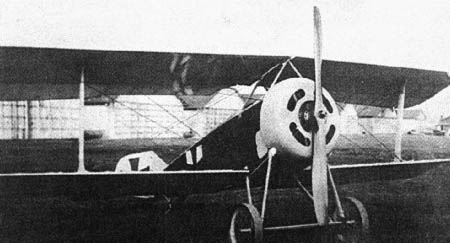
Alter A.1 (sec. aviastar)
The Alter A.1 was a single-seat biplane fighter, which flew in February 1917. It was designed by Kallweit and Ketterer and built by Ludwig Alter-Werke of Darmstadt. This A.1 was a close copy to the Nieuport 11with some differences. It was powered by a 110 hp Goebel Goe II 7-cylinder rotary engine. It had I-type inter-plane struts and a wood-framed, fabric and plywood covered fuselage. It was armed by two synchronised 7.92 mm LMG 08/15 machine guns. However after demonstration to the Idflieg (Inspektion der Fliegertruppe) it was found its performances disappointing and construction too flimsy for service.
General characteristics
- Weight: 510 kg (1,124 lb)
- Top speed 117 km/h (73 mph; 63 kn), 3.91 m/s climb rate, 3,000m in 12.8min
BFW – Bayerische Flugzeugwerke
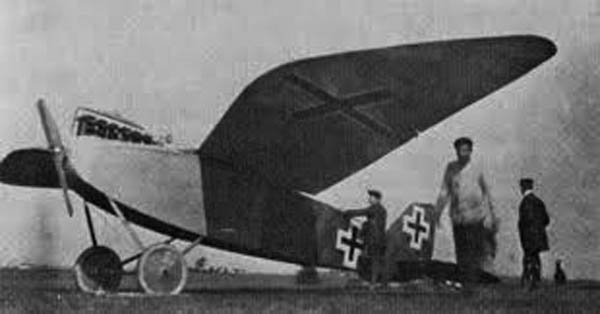
The BFW Eindecker 1918 had a uniquely forward-swept wing design which made it very interesting and avant-garde
BMW’s origins can be traced back to three separate German companies: Rapp Motorenwerke, Bayerische Flugzeugwerke and Automobilwerk Eisenach. The history of the name itself begins with Rapp Motorenwerke, an aircraft engine manufacturer. In April 1917, following the departure of the founder Karl Friedrich Rapp, the company was renamed Bayerische Motoren Werke (BMW) and its first engine was the BMW IIIa known for good fuel economy and high-altitude performance. Orders poured in from the German military and BMW expanded very fast. However after the war, BMW cease aircraft-engine productiondue to compliance to the Versailles Treaty and turned to farm equipment, household items and railway brakes. Camillo Castiglioni in 1922, still a major shareholder, purchased the rights to the brand BMW, renamed Süddeutsche Bremse AG (Knorr-Bremse) while he invested in another aircraft company, “Bayerische Flugzeugwerke”, renamed BMW while the empty factory served to the Automobilwerk Eisenach, re-opened to produce vehicles engines and also farm equipment and pumps, also under the BMW label. The Bayerische Flugzeugwerke funded on 7 March 1916 is considered the mother company, that’s why today’s logo still integrates a stylised spinning propeller alternating the blue and white reminding the Bavarian flag checkerboard.
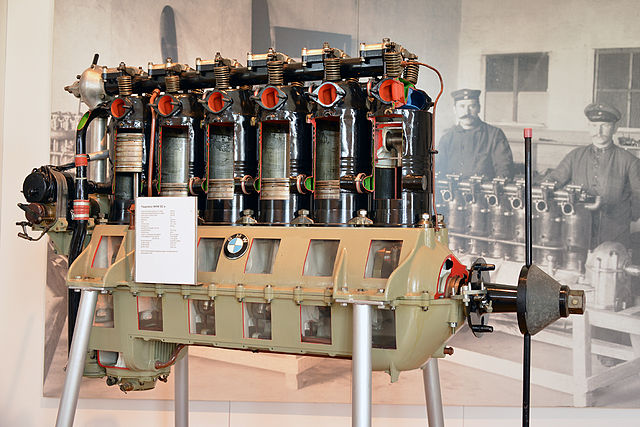
The popular BMW-IIIa aircraft engine
But its not known well that BMW outside engine production also turned to aircraft production for a time. To gain time on this, the factory used its industrial capabilities to help the production or complete aircrafts, but the whole CL.I to CL.III closely related to the Halberstadt models, for reconnaissance and close support (strafing attacks, light bombing) stayed at prototype stage. The B.F.W. CL I designed to CL specification was an improvement on the Halberstadt CL II, but remained only a prototype. It was propelled by the 160 h.p. Mercedes D III. The CL II stayed also at Prototype stage, propelled by a 175 h.p. MAN III and flown in July 1918. The B.F.W. CL III was also a prototype powered by a 200 h.p. Benz Bz IV. The interesting BFW monoplane of 1918 had wings making a forward sweep and reused the CL II/III fuselage, propelled by a 180 hp Argus III. The night bomber BFW N.I studied at the end of the war was a two-seat triplane able to carry a bomb load of 744 kg. (1,636 lb.) and powered by a 260 h.p. Mercedes DIVa. Weight ranged from 1,500kg.(3,300 lb.) to 2,500kg.(5,500 lb.) and the gunner had a Parabellum machine-gun.
- BFW CL.I – light reconnaissance/close support 1917 (1)
- BFW CL.II – light reconnaissance/close support 1918 (1)
- BFW CL.III – light reconnaissance/close support 1918 (1)
- BFW Monoplane 1918 (1)
- BFW N.I – night bomber 1918 (1)
Caspar
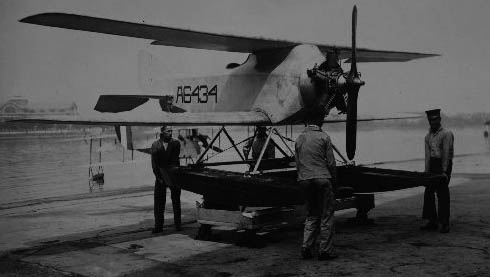
Caspar U.1 (wikimedia commons)
The Caspar-Werke was a German aircraft manufacturer of the early 20th century. It was founded in 1911 by Karl Caspar under the name Zentrale für Aviatik in Fuhlsbüttel. In its early years, the firm built Etrich and Rumpler types under licence, and was dissolved following World War I. In 1921, Caspar re-established the firm at Travemünde with Ernst Heinkel as chief designer. Heinkel left in May the following year after a dispute over rights to a design, and was replaced by Ernst Ritter von Lössl. Later, Hans Herrmann from the former Udet Flugzeugbau, was the designer. The company ceased operations in 1928.
- Caspar D.I – twin-engine single-seat fighter 1918 (1)
- Caspar U.1 – submarine aircraft 1918 (1)
Daimler Motoren Gesellschaft
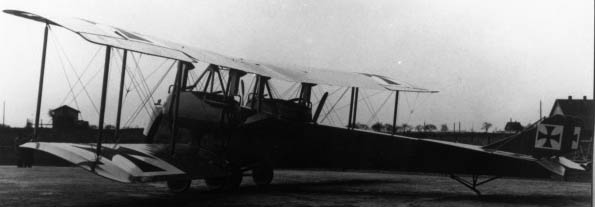
Daimler G.II Bomber – Only eight were produced (wikimedia commons)
Daimler Motoren Gesellschaft (DMG) of stuttgart started operations in 1890, until 1926. It has been founded by Gottlieb Daimler and Wilhelm Maybach and was a proficient car manufacturer. Of course cars and innovative engines, patented and licenced appeared, and one licence was acquired in UK, which became the The Daimler Motor Company Limited. Daimler built engines for the first airship, fuelled by petrol, in 1888. From 1899 to 1907 DMG provided Maybach designed engines for Zeppelin airships. Wilhelm Maybach quitted DMG in 1909. After 1909 Maybach and his son Karl founded their own enterprise in Württemberg and took over supplying engines. During the First World War, from 1915 onwards, the Sindelfingen factory produced large numbers of winged aircraft and aircraft engines. The air and ship activities led both sons of Gottlieb to create the “three pointed star” in reference to the “land, water, and air” covered by the company and its subsidiaries which became later Mercedes-Benz. The four-patented star they also deposed can still be seen with the European Aeronautic Defence and Space Company (EADS).
Production was prohibited after the conflict under the Treaty of Versailles conditions. The company produced only 18 aircrafts, starting in 1915 by improving a heavy bomber delivered by Union Flugzeugbau, and a few fighters, biplanes and Parasol in 1917-18 of which none really had to time to be operational.
About the R.I/G.I heavy bombers
Daimler ordered a Union G.I from Union Flugzeugbau, for testing, which disintegrated shortly before landing due to severe engine vibrations. So Daimler started to redesign it, which resulted in the Daimler R.I. The company benefited also from former Union designers Baurat Rittberger and Engineer Karl Schopper. They soon strengthened the structure and replaced the faulty inverted engines with Mercedes D.IIIs. Assembly of the R.I/II series took place at Sindelfingen, but parts weresent from Schiedmayer of Stuttgart for final assembly. Flight trials started late in 1915 which showed the structure needed to be strengthened while several wing arrangements were tested until 1917. A larger tail was also tested and adopted on the second R.I built, and six almost identical improved R.II were manufactured in 1916. But only two flew, while the the remainder were crated and stored. Their large wooden fuselage housed the pilot, navigator and bomber, and had a gunners cockpit in the nose, while other gunners took place on each side, and one more aft of the wings. The tailplane supported a fin and rudder and two additional rudders at half span. The massive undercarriage comprised a nose-wheel assembly with four main-wheels with two in the engines nacelles plus a rear tail-skid. Initially these engines were placed in push-pull nacelles on the lower wing. The R.II however had these nacelles streamlined and mounted on struts between the wings. But generally Idfielg tests showed poor performances and no large production was ordered, while at least one R.I and two R.IIs has been accepted by Idflieg for more tests throughout 1917.
About the CL.I (or L8) escort fighter
At the end of 1917, Daimler Motorengesellschaft Werke introduced an escort fighter receiving the internal designation Daimler L.8. A two-bay biplane propelled by an eight-cylinder Daimler D.IIIb engine rated for 185 hp (138 kW). It was armed with two forward synchronized 7.92-mm machine gun LMG.08/15 on the nose and a rear 7.92-mm machine gun Parabellum scarff-mounted on the observer’s cockpit. Only a single prototype was built and tested by the military in 1917 which gave it the designation CL.I. There was no further development although in 1919 there has been prospects to sell it to the Chilean Air Force.
About the D.I fighter (1918)
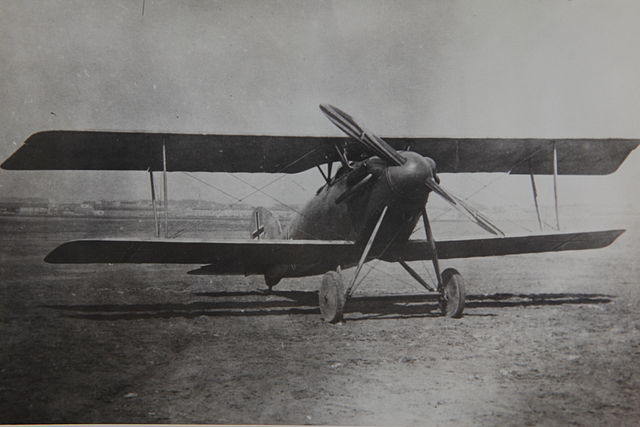
Daimler D.I Fighter
The Daimler D.I (factory L6) was a conventional fighter biplane design with a very small interplane gap as the top wing nearly touched the top of the fuselage, allowing for better visibility, while it was powered by a Daimler D.III engine. The initial L6 prototype competed in the second Idflieg competition for a new fighter for 1918 held at Adlershof from 22 May through 21 June. It was well placed, and resulted in an order for 20 aircraft. However production was long to setup and only six were built when the Armistice came and it went no further. There is not known service record, it’s likely they were stored and never saw any affectation in a service unit.
The D.II (L9) was an early summer attempt to improve the L7 prototype, differing from its predecessor by revising the design of the wing and vertical tail, following the ideas of Hans Klemm who became the chief designer of the company on April 1, 1918. It was officially tested by the Idflieg as the Daimler D.II in July 1918. but the test program was not completed when the armistice came. In 1920, Hans Klemm proposed its conversion as a postal plane, but it found no willing customer.
Other Daimler fighter prototypes
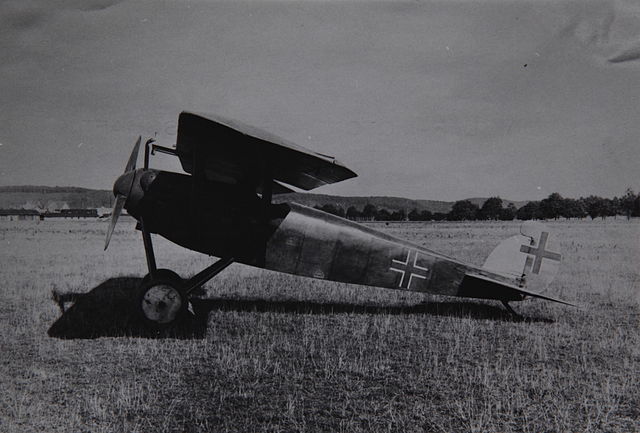
Daimler L11 Fighter
The next L11 and L14 were never tested. They were both monoplane parasol fighters as it seems this was the way forward back in 1918. The L11 was a single-seat fighter powered by a 185 hp (138 kW) Daimler D.IIIb eight-cylinder engine. It flew on 8 November 1918, but even with the armistice, continued testing through to February of the following year. Of course Versailles treaty interdiction doomed its development, as well as its successor the Daimler L14. The latter was basically a two-seat version, aerodynamically improved with a well-designed blended nose and fuselage. It was powered by a Daimler IIIb water-cooled engine and armed with two 7.92 mm machine guns, one firing forward and one rearward from the observer’s cockpit, scarff-mounted. The sole prototype built was tested in 1919 but it went no further for the same reason as above. The L14V was a project conversion mail carrier variant offered to Chile.
- Daimler G.I/R.I heavy bomber 1915 (2)
- Daimler G.II/R.II heavy bomber 1916 (6)
- Daimler D.I (L6) fighter 1918 (6)
- Daimler CL.I (L8) fighter (1)
- Daimler D.II (L9) – fighter (1)
- Daimler L11 – parasol fighter 1918 (1)
- Daimler L14 – parasol fighter 1919 (1)
Geest
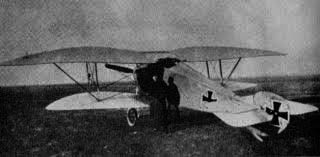
Geest 1916 single-seat fighter
Geest Single-seat Fighter
Built by Aviatik firm, to designs of Dr. Geest, during the winter of 1916-17. Something of the pre-war Mowe wing profile was perpetuated. Engine, 160 h.p. Mercedes D III. Speed, 160 km.hr. (100 m.p.h.). Climb, 3,500 m. (11,480 ft.) in 17 1/2 min. Armament, probably twin fixed Spandau machine-guns.
Germania
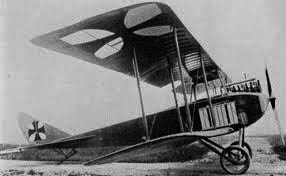
Germania Type C
- Germania type B – reconnaissance, 1915
- Germania type C/K.D.D. – fighter
- Germania C.I – reconnaissance
- Germania C.II – reconnaissance
- Germania C.IV – trainer
- Germania JM – unarmed single-seater, 1916
Hannuschke

Hannuschke monoplane.
Hannuschke Eindecker – single seat scout (1912). This was a near-copy of the French “Demoiselle”, Santos-Dumont airplane. Also known as the Hanuschke Typ populaire it was used as a private plane and trainer during the war. Bruno Hanuschke, Flugzeugbau, was created at Johannisthal, near Berlin. His 1913 model was produced to just 22 units. They were 24 feets (7.50m) in length and 27 feets (8.25) in span, 17m2 wing area, and weighted 716 Ibs (325 kgs) up to 385 Ibs (175 kgs)propelled by a 35 ihp Anzani 50 Gnome and 62 mph (100 kph) fast, capable of flying two hours.
Src: Bruno Hanuschke (1892-1922) – “Das Küken” vom alten Startplatz. Aus dem Leben eines Flugzeugführers und Unternehmers
Hergt
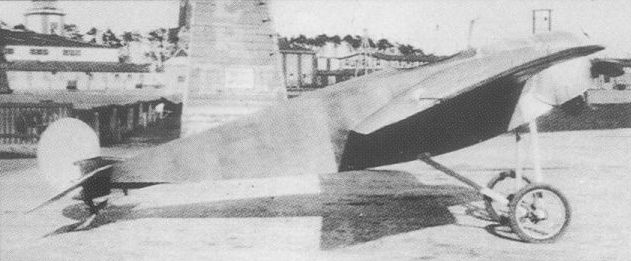
Hergt monoplane 1918 (wikimedia commons)
The Hergt monoplane was a prototype fighter of 1918. A late one-seat eindecker that was characterized by a wide fuselage to accomodate a Gnome engine and stubby, short wings. Apparently both the fuselage and wings were covered in plywood so the plane had an excellent structural sturdiness. It was built at F.E.A. 1 Altenburg as a private venture by F. D. Hergt during 1918 and flown by Mario Scherff. It was propelled by a 80 h.p. Gnome for a top speed of 125 kph and had a span of only 6.0 m. (19 ft. 8 1/4 in.). and was 5.2 m. (17 ft. 0 3/4 in.) long. Needless to say by 1918 standards these were not impressive figures and after official tests no orders followed.
Fabrik und Jeannin Flugzeugbau
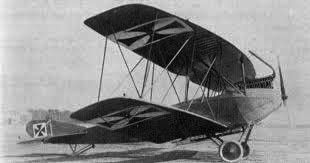
Jeannin Doppeldecker 1915
The company built some racing Nieuport type monoplanes before the war at Johhanistal near Berlin. The company also built their own version of the Taube based on their prewar monoplanes, and their only other significant aircraft was a rigidly braced biplane of 1915. A single prototype powered with 150 h.p. Benz Bz III engine was built. It was tested but not accepted by the Air Force. The company went in liquidation afterwards and its assets were taken into a new company, the National Flugzege Werke or NFW. Src: Google Books: Kites, Birds & Stuff – Aircraft of GERMANY – I to M
- Jeannin Taube – reconnaissance monoplane, 1914 (c20 built ?)
- Jeannin doppeldecker – reconnaissance biplane, 1915 (single prototype)
Kondor Flugzeugwerke GmbH
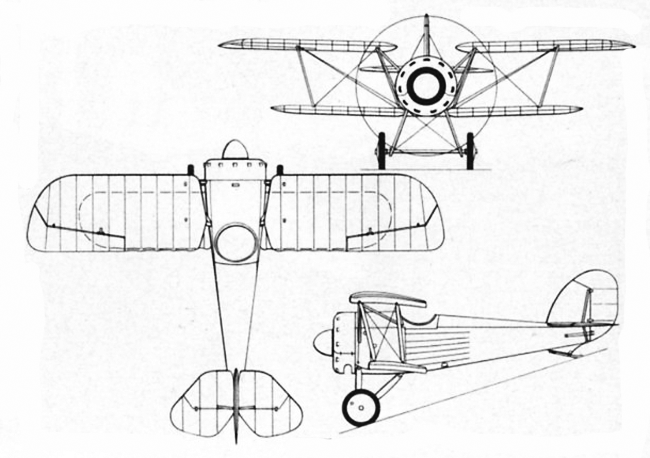
The original Kondor D.VI fighter of 1918 (wikimedia commons). Note the cut open upper wing for visibility.
The condor aircraft company was headquartered in Essen and founded on June 15, 1912.The main plant was located on the site of the former airfield Essen-Gelsenkirchen-Rotthausen. Kondor had its own flight school to form pilots, giving them the necessary license and creating a potential customer base. Before the First World War, Kondor launchd their own model of the Taube. This Kondor Taube resembled the other monoplanes made by the many manufacturers which produced this popular model, it was even closer to the original Etrich Rumpler Taube. It first flew 12th October 1912. Afterwards, Kondor looked upon Albatros to procure licence-built models, and mass-manufactured the B.II from October 1916. Until 1918 the company delivered around 480 aircraft of various designs in Rotthausen, the company had a staff then composed of about 1,200 personal. Models included reconnaissance, training and fighter aircraft and also a few proper experimental models. These originals were under the responsibility of chief designer Walter Rethel (1892-1977). After the war, Kondor went on producing a few commercial aircraft but none met success and went into large production. As a result, Kondor Flugzeugwerke GmbH was liquidated but its assets were maintained and it continued produce furniture from 1920 onwards, and joined in 1993 the Lemgo/Ostwestfalen-Lippe Gruppe. Former Kondor plants can be visited in Lemgo house, with the advertising agency sagner-heinze.
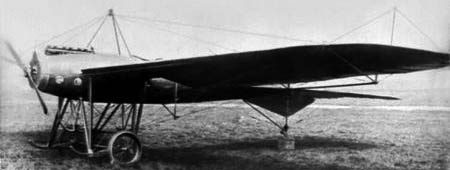
The Kondor Taube, 1914.

The Kondor flying school, prewar.
Kondor W 1: Appeared in the spring of 1915, conventional two-seater, plywood-covered fuselage. Unusual interplane bracing with two pairs of struts converging to form a vee. It was propelled by a 120 h.p. Mercedes D II. It had a 13 m span. (42 ft. 7 1/8 in.) and was 7.95 m (26 ft. 1 in.) long, Weighting 900 kg (1,980 lb.).
Kondor W 2 C: Flew in the spring of 1916, first aircraft to be fitted with the 220 h.p. Mercedes D IV “straight-eight” geared engine, but only tested, no production apparently.
Kondor B I: A trainer with a large two-seat open cockpit tested in January 1918. Conventional two-bay biplane, plywod fuselage with large “ear”-type radiators on the sides, ailerons on both the upper and lower wings. Production simplification was at its core, with the minimum number of parts needed and interchangeability of components plus serial modular pre-fabrication. it was propelled by a 120 h.p. Mercedes D II. Production figures unknown (if any).
Kondor D.6: Prototype fighter aircraft flown in 1918. It had its upper wing split in two halves over the central fuselage but its development was soon abandoned.
- Kondor Taube – reconnaissance (c100 ?)
- Kondor W.1 – two-seater 1915 (?)
- Kondor W.2C – reconnaissance 1916
- Kondor B.I – trainer 1918 (?)
- Kondor D.I – sesquiplane fighter 1918
- Kondor D.II – biplane fighter 1918
- Kondor D.6 – biplane fighter 1918 (Proto)
- Kondor D.7 – sesquiplane fighter, 1917
- Kondor E.III & IIIa – monoplane fighter, 1918 (10)
Read more
http://www.kondor-gewerbepark.de/historie/
http://www.gelsenkirchener-geschichten.de/viewtopic.php?t=5557
https://en.wikipedia.org/wiki/Kondor_E.III
Kaiserliche Werft Danzig
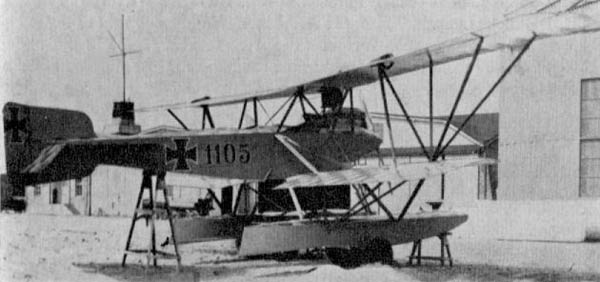
KWD N°1105
A well-known and reputed German shipbuilding company founded in 1852 as Königliche Werft Danzig and extended and renamed when the German Empire was proclamated in 1871. The yard built several cruisers, gunboats and the Odin-class coastal battleships, but was also one of the three German yards to produce U-boats for the Kaiserliche Marine, 62 in all or 12% of total German submarine production. It also soon tried aircraft production delivering nine planes known by their serial numbers as they were never intended for the Army, but the Navy instead, usually given obsolete or damaged planes for training duties. The 404 and 405 were modern trainers created for the Navy in 1917, unarmed two-seaters that were supplied to the naval base at Putzig. The 467–470 series were four 1916 training biplane with floats also for the naval base at Putzig. The No. 1105–1106 of 1917, had staggered wings of unequal span and empennage included a sizable ventral fin. These unarmed two-seaters were remarkable for their innovative brace-less interplane strut arrangement. They were delivered to Putzig in the fall of 1917. The last, 1650, was a reconnaissance seaplane, armed with a trainable 7.9 mm machine gun and powered by a Mercedes D.IV, 160 kW (220 hp), and remarkably carryiing a radio equipment for transmission and reception (and gaining the naval CHFT classification).
- Kaiserliche Werft Danzig 404 – floatplane trainer (2)
- Kaiserliche Werft Danzig 467 – floatplane trainer (4)
- Kaiserliche Werft Danzig 1105 – floatplane trainer (2)
- Kaiserliche Werft Danzig 1650 – reconnaissance floatplane (1)
Read More
Kaiserliche Werft Kiel
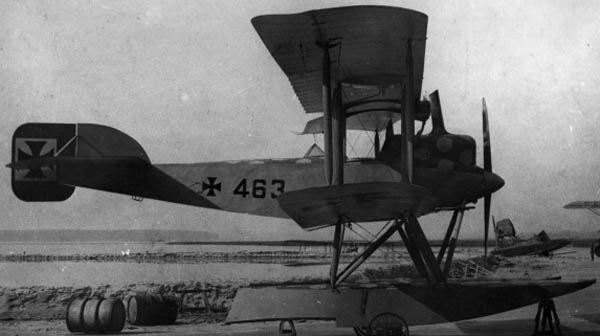
Kaiserliche Werft Kiel 463 – floatplane trainer (wikimedia commons)
Apart from having built German’s coastal battleships, armored cruisers, light cruisers and submarines for two decades, the venerable German shipbuilding company was founded in 1867 and renamed in 1871. Like Dantzig it was concerned as having no reconnaissance seaplanes. They would eventually built three, numbered 463 to 466 of the roughly same design for the Navy’s flying service during War, based locally at at Kiel-Holtenau for training in 1915, while four serial numbers were allocated. These were conventional, two-bay biplanes with unstaggered wings of equal span, two open cockpits in tandem and twin pontoons undercarriages. The square rudder was hinged to the rear end, extended below the ventral line of the fuselage and the inline engine was well cowled in, with the exhaust truncated and located above the upper wing. These seaplane were sent first at the testing unit (SVK – Seeflugzeug-Versuchskommando) at Warnemünde and accepted for service the next summer of 1918 only. On the other hand, the No 461–462 were built also to substantially the same design.
- Kaiserliche Werft Kiel 461-462 – floatplane trainers (2)
- Kaiserliche Werft Kiel 463-466 – floatplane trainer (3)
Read More
Kaiserliche Werft Wilhelmshaven
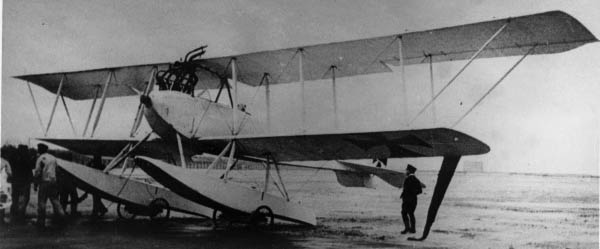
Kaiserliche Werft Wilhelmshaven 401 (wikimedia commons)
The Kaiserliche Werft Wilhelmshaven (funded 1853) was one of the most prominent German Imperial yard, delivering many dreadnoughts for the Navy and started with the Ironclad turret-ship SMS Grosser Kurfürst in 1873. Its designed would remain famous well after the war, its groundbreaking SMS Hindenburg battlecruiser design being the forerunner, well-studied by British engineers, of modern fast battleships in many ways. But during the conflict, it had been producing also a small numbers of training seaplanes for the German Navy, then badly equipped with old reformed models. A small serie numbered 401 to 403 was commenced in April 1915 and were were delivered to the Navy in August 1915. These were conventional two-seat biplanes propelled by a Mercedes D.I, 80 kW (107 hp). The next 461-462 were built in October 1916 and in September 1917 respectively also for training. These were propelled by the Benz Bz.III, 110 kW (150 hp) engine and were capable of a speed of 143 km/h (90 mph), with a rate of climb of 1.6 m/s (310 ft/min).
They also delivered a small number of armed types for local defense, including the unique Number 945. The latter’s general layout was conventional but its single-bay wings were braced with single, large I-struts, and almost no vertical stabilizer, just a a stub on the dorsal side of the rear fuselage. The rudder was also partly ventral. It was classified C3MG type by the Navy, with an armament both fixed and trainable. There has been only one photograph of the completed aircraft but there is no record of it entering service in 1918. The 947 was an armed reconnaissance aircraft, two-bay biplane of conventional design classed CHFt by the navy, as equipped with a radio gear capable of both sending and receiving, and which strongly resembled the Nos 461–462. It was long used by the SVK – Seeflugzeug-Versuchskommando at Warnemünde.
- Kaiserliche Werft Wilhelmshaven 401-406 – floatplane trainers (3)
- Kaiserliche Werft Wilhelmshaven 461-462 – floatplane trainer (2)
- Kaiserliche Werft Wilhelmshaven 945 – floatplane fighter (1)
- Kaiserliche Werft Wilhelmshaven 947 – reconnaissance floatplane (1)
Read More
Kaiserliche Werft Wilhelmshaven
Linke-Hofmann
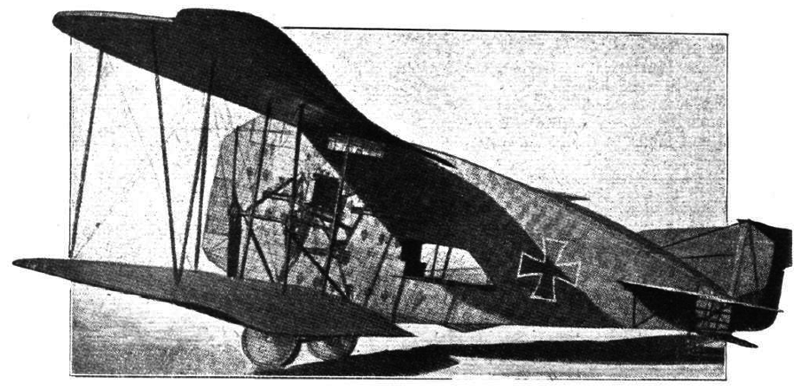
The very unusual Linke-Hofmann R.I (wikimedia commons)
Linke-Hofmann-Busch of Breslau produced locomotives and rolling stock and originated in the wheelwright business of Gottfried Linke created in 1834 (now part of Alstom since 2009 as ALSTOM Transport Germany GmbH). It was drawn into the aircraft industry even though they had no prior experience in aircraft design, first by repairing and constructing aircrafts under licence like the Roland C.IIa, Albatros B.IIa, C.III and C.X. In 1916 Linke-Hofmann-Busch designed and build a four-engined heavy bomber under the Riesenflugzeug (“giant aircraft”) designation. The two designs remained prototypes only, the R.I and the R.II; They were really unconventional and only the R.II flew relatively well but the war ended before any order was passed and post-war attempts to build an airliner conversion was prevented by the Allied Control Commission and the company returned to its prewar activities.
- Linke-Hofmann R.I – heavy bomber (1)
- Linke-Hofmann R.II – heavy bomber (1)
Luft Torpedo Gesellshaft Johannisthal
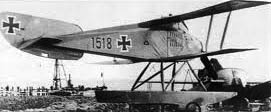
LTG FD.1 – flyingmachines.ru (wikimedia commons)
This company from Berlin, Luft Torpedo Gesellschaft (LTG) delivered for the German Navy the FD.1, a fighter seaplane. It was developed from specifications a total of six were ultimately delivered from 1917 to early 1918, one being tested for lifting various loads. It was propelled by a single Benz Bz III series engine (150 hp) driving a two-bladed propeller. It was a traditional biplane with a streamlined, slab sided fuselage, enlarged nose spinner, long vertical fin and low horizontal planes. The single seat was aft of the upper wing with a cutout opening in the wing. The undercarriage had two floats with struts for rigidity. It was armed with two synchronized 7.92mm machine guns in the upper forward fuselage. Service records are unknown.
Flugzeugwerft Lübeck-Travemünde GmbH (FLT)
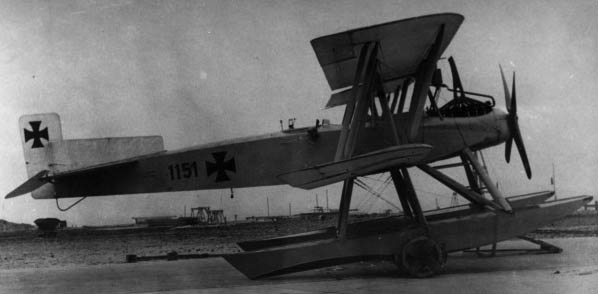
FLT. F2 (wikimedia commons)

FLT. blueprint
Flugzeugwerft Lübeck-Travemünde GmbH was a subsidiary of Deutsche Flugzeug-Werke founded in May 1914 at Travemunde Privall, specifically to built seaplanes.
The F.1 was the first product, a four-bay two-seater with tapered wings. Only three numbered examples were built, (282-284) propelled by a 160 h.p. Mercedes D III.
The Lübeck-Travemünde F.2 was a reconnaissance floatplane, improved version of the F.1 and first armed one. It was a twin-float biplane powered by a 220 hp (164 kW) Mercedes D.IV engine and two seats, the observer being armed with a scarff-mounted 7.92 mm (0.31 in) Parabellum MG. The next F.4 was used by the Royal Norwegian Navy Air Service from 1919 onwards. This version was the most produced with 34 delivered in 1917-18, used for patrol reconnaissance in the north sea. They carried a radio was carried and were numbered by the Navy 1971-1973, 2135 and 7001-7030. The F.4 was propelled by a 200 h.p. Benz Bz IV and were armed by a single Parabellum machine-gun on the observer rear cockpit, scarff-mounted.
- Lübeck-Travemünde F.1 – floatplane reconnaissance (3)
- Lübeck-Travemünde F.2 – floatplane reconnaissance (11)
- Lübeck-Travemünde F.4 – floatplane reconnaissance (35)
- Lübeck-Travemünde 844 – single-seat seaplane (1)
Märkische Flugzeueg-Werke (MFW)
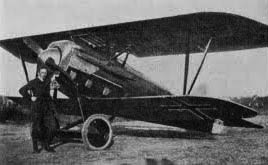
Märkische MFW D.I
The Company produced about 700 Rumpler C.Is under licence, which was also produced by the Germania Flugzeug-Werke, Hannoversche Waggonfabrik and Albert Rinne Flugzeug-Werke. In 1917, it started its own model, the D.I. A conventional biplane, it was designed by Hillmann, as a single-seat fighter. It was propelled by a 195 h.p. Benz Bz IIIb engine. Apparently one was built, tested but not ordered. The Märkische MFW D.I would remain a prototype.
Naglo Bootswerfte
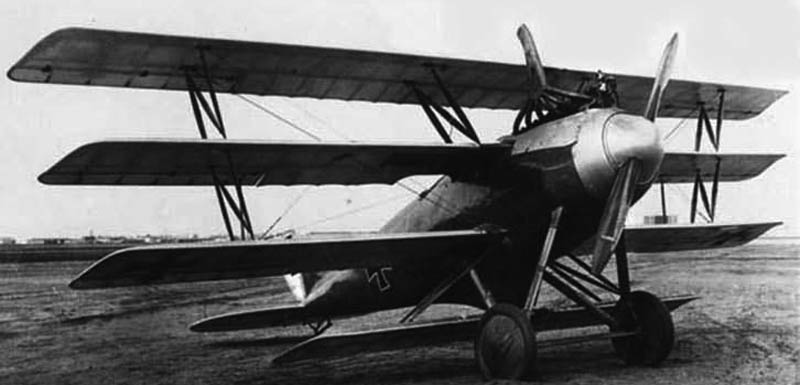
NG.II – David Horn coll. (wikimedia commons)
The D.II was the only fighter built by Naglo, a prototype designed by the designer Gnädig, from Albatros Flugzeugwerke. So his design had some influences. However it was one of the very few quadruplanes ever designed. There three upper wings indeed, all similar, with constant chord and squared tips, same span without sweep. The lowest wing, of shorter span,was mounted independently under the fuselage belly, behind the undercarriage. it was fixed to a dorsal keel extension and branced with V-struts. Interplane struts N-form held the upper plane high over the fuselage and more were placed between each wing and ailerons on all three upper wings, and was indeed dangerously close to the ground. This plane was propelled by a 160 hp (120 kW) 6-cyl. water-cooled Mercedes engine driving a two-blade propeller. The large domed spinner was blended into the fuselage but the Mercedes cylinder heads and exhausts were exposed to the air, above the fuselage very close in cosntruction (with plywood sections) to the Albatros D.V. The Naglo Bootswerfte D.II first flew on 24 May 1918 and took part in a D-type contest at Adlershof soon after. It ranked well and impressed for its construction quality but left to desire in many areas and Naglo was pressed to make modifications for a second test which apparently never came or was not followed by any order.
National Flugzeug-Werk GmbH Johannisthal (NFW)
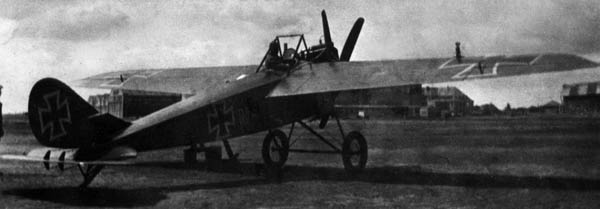
NFW E.I (wikimedia commons)
The National Flugzeug-Werk GmbH based at Berlin, was a local repair workshop and training school which tried three experimental planes but soon left aircraft manufacture aside. The B.I was a conventional biplane, two-seats, built in 1915 at Johannisthal, and used as trainer, a single prototype being produced by a 120 h.p. Argus As II. The E.I (Eindecker) fighter was a small monoplane prototype which emerged in the spring of 1916 designed by the Ingineer Hergt. This plane has plywood-covered cantilever wings which passed through the fuselage, the pilot seated between them. The NFW E.I was tested but never really evolved as a production machine. It was propelled by a 80 h.p. Oberursel UO, was 428/620 kg and could fly at 156 kph (97.5 m.p.h.). The next E.II was built in 1917, similar in construction but different in appearance, fitted with the more capable inline 160 h.p. Mercedes engine. Weighing 558/768 kg it was capable of 180 kph (112.5 m.p.h.) and climbed to 2,900 m. in 6.3 min. only one photo of the E.I exists apparently.
- NFW B.I – trainer (1)
- NFW E.I – experimental monoplane (1)
- NFW E.II – experimental monoplane, 1917 (1)
Oertz
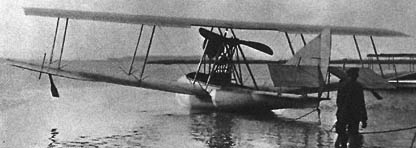
Oertz W.4 floatplane (wikimedia commons)
Built by Max Oertz’s successful prewar Hamburg Yacht firm this serie of floatplanes started with the prewar FB.3 (Naval number 46) of 1913 propelled by a 100 h.p. Argus engine, and was followed by the two W4 in 1914, numbered 63 and 75. The W.4 had a 160 h.p. inline, liquid-cooled Daimler engine. The W.5 (4 built numbered 275 to 280) followed by the W.6 Flugschoner twin seater (281), W 7 (474 and 475) and W 8 (1157). They were relatively similar to the Macchi floatplane design, biplane pushers, with very marine hulls crafted with much care with Max Oertz. They gave the perfect lateral stability on the water and had a complex spring-loaded hydrovanes fitted on the wingtips to prevent submersion. Also, the chord of the lower wing was much greater than that of the upper wing, also with greater span and inward rake to the interplane struts, and lower wing ailerons. Apparently they were unarmed and served for reconnaissance from the Zeebruge naval base, kept at the railway station hall at the end of the Mole, assembled on flat railway cars with the Locomotives kept steaming up and to bring the planes to the cranes, lift and lower them to the water from the Mole by calm weather.
- Oertz FB.3 1913 – flying boat (1)
- Oertz W 4 1914 flying boat (2)
- Oertz W 5 1916 flying boat (4)
- Oertz W 6 1916 tandem double biplane flying boat (1)
- Oertz W 7 1916 flying boat (2)
- Oertz W 8 1917 flying boat (1)
Gustav Otto Flugmaschinenfabrik

Otto Pusher biplane 1914 (wikimedia commons)
In 1910, Gustav Otto founded the “Aeroplanbau Otto-Alberti” workshop at Puchheim airfield. Renamed “Gustav Otto Flugmaschinenfabrik”, was moved from 37 Gabelsberger Strasse to the 135 Schleissheimer Strasse while another factory was set up at 76 Neulerchenfeldstrasse and In 1915, “Otto Werke, Gustav Otto, München”. Soon a subsidiary was created near Berlin, AGO. Unfortunately Gustav Otto was no manager, and his production was jeopardized by small cadences and no profit to make it viable. His company was taken over and stat-run by the military and later joined to the ancestor of BMW. The 1915 C.I was unveiled in the summer of 1916, a twin-boom aircraft delivered to the Bulgarian Air Force. The Otto C.II was the last model delivered before the liquidation of the company. A conventional two-seater of wood and canvas, propelled by a 160 h.p. Mercedes D III. engine.

Otto B.I
- Otto pusher – reconnaissance pusher biplane, 1914 (1)
- Otto B.I – reconnaissance tractor biplane, 1914 (1)
- Otto C.I – reconnaissance pusher, 1915 (13)
- Otto C.II – reconnaissance tractor biplane (1)

Bruno Büchner with his Otto/AGO biplane and native honor guard on an improvised flying field near Daressalam (wikimedia commons).
Flugmaschine Rex GmbH
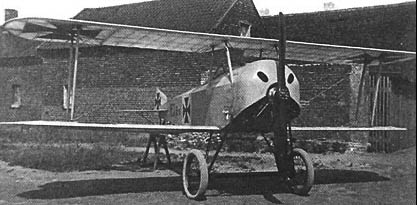
Rex D.6 1916
Early on, Cologne’s enthusiasm for the innovative aviation industry traduced first in sports balloon, and multiplied flight tests. But soon it was felt that heavier-than-air were more promising, and Cologne inventor, car manufacturer and engineer Nicolaus August Otto started right away after the Cologne Flight Week on September 30, 1909. French pilots showcased their creations, and the first German pilots showed their own planes from 1911 on the racetrack in Weidenpesch, like pioneers Werntgen and Signos. On December 1, 1914, local businessman Walter Gutbier founded the “flying machine REX GmbH” in Cologne-Ossendorf, to build monoplanes and biplanes. The company’s co-owner was Dr. Engineer Friedrich Hansen from Aachen which had already constructed in 1909 an aircraft in Zurich and worked on rotary engines.
His workshop was housed in the Bickendorfer airship hangar and later the company was renamed “REX” and received the approval and building supervision number 42. But soon the company was found unable to design a plane and chossed instead to concentrate in the maintenance of military hardware and later turned to licence-production of Albatros types. Butzweilerhof factory was setup nearby for this purpose. Orders for aircraft repairs and maintenance rose to new heights, and the company acquired the gas factory Widdersdorfer Str., creating another plant. Jakob Bungartz was in charge of the production setup. By 1918 Rex had about 300 workers but production was stopped after the end of the war as there was no market for aircraft due to the Versailles Treaty. However aircraft fuselages and wings were still lying on the property of REX for a long time, possibly waiting for a Royal Australia Air Force and British Royal Air Force orders at the Butzweilerhof airfield.
The following types of aircraft were built in Ossendorf:
A 1916 single-seater biplane designed by Friedrich Hansen, with a five-cylinder radial engine 80 HP U O Oberursel: Only one built, possibly based on the British Bristol Scout. with its lower wing ender the fuselage. Also in 1917 another fighter biplane able to move the swimmers up or down to reduce the immense air resistance, lost in April 1917 at its first flight.
These four types were the D6,followed by D7, a single scout airplane, and a biplane floatplane of 1917, designed by Ursinus (see below).
More
- Rex 1915 Scout – fighter, 1915 (1)
- Rex D.6 1916 Scout – fighter, 1916 (1)
- Rex D.7 1917 Scout – fighter, 1917 (1)
Flugmaschine Fabrik Franz Schneider GmbH
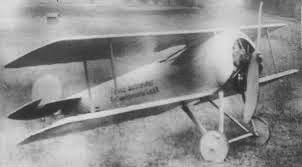
The rare Schneider Fighter 1918 (flyngmachines.ru)
Flugmaschine Fabrik Franz Schneider G.m.b.H. was founded by Franz Schneider in 1917. First the company was specialized in repairing and servicing Albatros. D.F.W. and L.V.G. planes. However prior to the war Schneider was associated with Edouard Nieuport, and later responsible for some of the best L.V.G. designs. In 1918 the company launched itself in the creation of its own single-seater about no details are available. It was obviously closely related to the Nieuport 11 although the ailerons were unusually placed at the lower wingtips. It was propelled by a 200 h.p. Goebel Goe III, much more powerful than the original Neuport, and was armed with two Spandau machine-guns on the nose, also a quite heavier armament. But we do not known if it was even officially tested. At least two photos exists of this rare plane. What’s clear is that kind of fighter was already obsolescent by 1918 standards.
Schwade Flugzeug und Motorenbau GmbH

Schwade Kampfeinsitzer NR.2 (airwar.ru)
Little is known of the company, which produced two planes at the beginning of WW1. Schwade of Erfurt worked on a new biplane fighter simply named “Nr.1”. It relied on a traditional frame braced with cables and parallel struts. The pilot was seated in a small circular nacelle, open to air. The tail was held by triangular struts supporting the tail surfaces. The nacelle housed the engine in a pusher configuration and a single 7.92mm Bergmann LMG 15 machine gun on a flexible mounting. The undercarriage was a simple two-legged, two-wheeled and a tailskid was fitted to the fuselage rear. The flexible mounting proved a failure, as it was hard for the pilot to fly and at the same time trying to aim and train his weapon on a moving target. The engine was a Schwade Stahlherz 7-cylinder rotary piston rated for 80 horsepower. Only one prototype was built, but the company turned to the improved Nr.2, a twin-boom biplane fighter.
At the end of 1916 Otto Schwade built the NR.2 equipped with a seven-cylinder rotary Schwade Stahlherz 80 hp engine, French Gnome copy, and the same 7.92-mm machine gun Bergmann LMG 15 on a mobile mounting. it was tested in early 1916, but there is no record of any production ordered.
- Schwade 1914 fighter (1)
- Schwade 1915 fighter (1)
Oskar Ursinus Gmbh
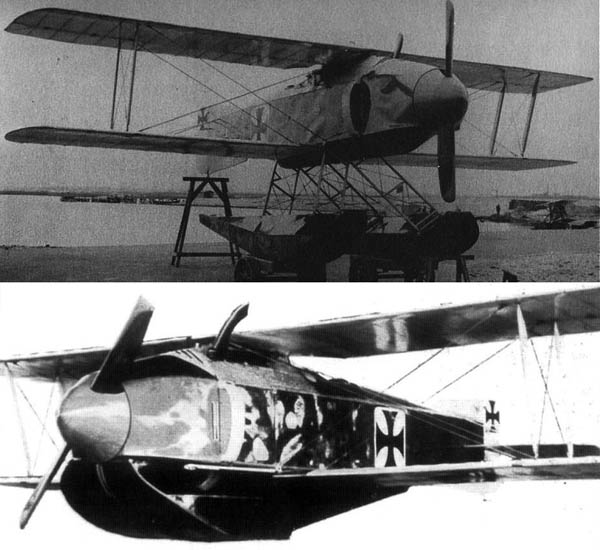
Ursinus Floatplane (flyingmachine.ru)
This fighter seaplane prototype of 1916-17 was designed by Oskar Ursinus. The latter tried to improve speed and lower drag by creating retractable floats which could be raised and lowered manually. This also required that the propellor was mounted on an extension shaft to prevent interference with the floats. One prototype was built, and production by Gotha was planned. Unfortunately, the prototype was destroyed early on and development was halted. This Seaplane fighter prototype
was propelled by a 150 hp Benz BZ III, 29 ft 6.385 in (9 m) in wingspan by 25 ft 6.5 in (7.77 m) long, 9 ft 6.25 in (2.9 m) high floats extended, and weighted 1,649 lb (749.5 kg) up to 2,205 lb (1,002 kg) fully loaded. Top speed was 124 mph (200 km/hr) as estimated.
Flugzeugbau Friedrichshafen
Manufacturer of Zeppelin airships – see dedicated page
Gödecker

Gödecker B type 1915
This early 1915 type trainer became no more than a prototype. It was a perfectly orthodox wood and fabric machine, built first as a single-bay aircraft and later rebuilt with two-bay wings. Engine, 120 h.p. Mercedes D II.
Read More
List of German Military Aircrafts by manufacturers
WW1 central power aircrafts
German and Austro-Hungarian Military Aircraft Designations (1914-1918)
German and Austro-Hungarian Aircraft Manufacturers 1908-1918 By Terry C. Treadwell
Br 14 Aircraft Challenge
Zeppelins
The mythical airship
The term “airship” appeared at the same time that the first planes. And back in the fall of the 1890s and early 1900s, it seemed clear to many that airships were clear winners in the competition with “heavier-than-air” crafts. A logical development of the Montgolfier 1770s invention, the balloon, the airship consisting in fitting engines and a new aerodynamic shape and tails to a balloon to make it independent from the power of the wind -to some extent- and dirigible, the other name for this class of aircrafts. This was an answer, driven by the first petrol engines, to the main problem of the balloon, which were like sailships driven by natural forces, the only control remaining being some vertical management by filling or depressing the envelope; The balloon needed to go and by the dawn of the XXth this was the case. The new name cherished by the press was the “airship”, a mighty sight in the sky that inspired both awe and fear, as well-envisioned by Jules Vernes in its “Robur the conqueror” novel. Henry Giffard‘ 1852 dirigible was the first attempt to drive a balloon. In French this literally means “drivable”
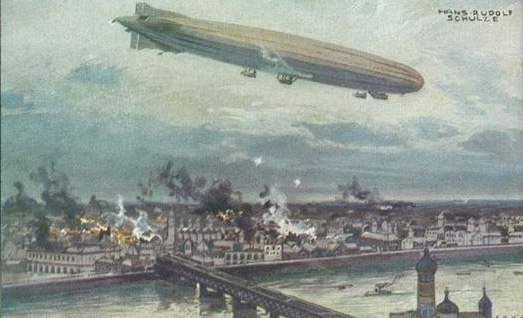
The first “Blitz”
Of most nations associated with the birth of aviation two were shining in the field or airships, France and Germany. But on the long run, only one will emerge and became synonymous with the airship type as a whole: Zeppelin. Known by all, it was to pass into imagination, like a dream. A flying cathedral of aluminum, canvas and… (true story !) cow hide. The largest man-made flying objects ever. In fact they will stay forever associated with the spirit of the raring twenties” but also to the first first “blitz” over London back in the Great war. They bring as much as fear as prestige, as well understood by the 3rd Reich. Since Lakehurst catastrophe which ended the story of the airship many aviation enthusiast had prophetised the return of the giants, thanks to new updated and safe technologies. But it never really materialized. So in the end Zeppelin stayed. Passed into legend, often displayed in fictions, having a British prog rock band named after it, forever present in out dreams…
The count’s flying ships
 Count Ferdinand von Zeppelin was THE figurehead behind the concept of airship. He did not invented the dirigible, then a French invention, but took it and after many fails, pushed the envelope in reliability and size until making the formidable machine that existed in WW1. During its relatively long history, and many imitations -never really equalled- Zeppelin’s airships were by far the most numerous type in use, with about a hundred airships built until 1937. The genericized trademark has been recently resuscitated, for tourist trips around lake constance, and no longer for long-range fights the DELAG made in the 1910-1937 period. Until indeed the introduction of transatlantic planes in the late 1930s and 1940s, the Zeppelin was the only way to travel for very long distances. But the space and luxury on board, relative slow speed made them more akin first-class cruise ship than mainstream transportation.
Count Ferdinand von Zeppelin was THE figurehead behind the concept of airship. He did not invented the dirigible, then a French invention, but took it and after many fails, pushed the envelope in reliability and size until making the formidable machine that existed in WW1. During its relatively long history, and many imitations -never really equalled- Zeppelin’s airships were by far the most numerous type in use, with about a hundred airships built until 1937. The genericized trademark has been recently resuscitated, for tourist trips around lake constance, and no longer for long-range fights the DELAG made in the 1910-1937 period. Until indeed the introduction of transatlantic planes in the late 1930s and 1940s, the Zeppelin was the only way to travel for very long distances. But the space and luxury on board, relative slow speed made them more akin first-class cruise ship than mainstream transportation.
The Count, born in the small Württemberg Kingdom, between Switzerland and Germany, bordered by Lake Constance, was a cavalry officer and observer during the American Civil War where he witnessed the use of balloons (then “aerostats”, or moored balloon) for observation. He distinguished himself as a brilliant cavalry officer in the Franco-Prussian War that saw the German unification, but was apparently sacked after the war by the high command, something he found dishonorable, leading him to resign in 1891. The Württemberg King has appointed him the rank of retired general in compensation, but the count from then on only goal would be to regain prestige and honor by giving Germany a war-winning weapon.
By the time Count Von Zeppelin started working on the concept in 1874, Dupuy de Lôme had flew an airship since 1872, with a hand-crank propeller. So this soon became a matter of rivalry between France and Germany, especially from the 1880s. Zeppelin developed his theories into plans in 1893 and then patents in 1895, and 1899 in the USA. He has been apparently at first inspired by a speech made by Heinrich von Stephan on “World Postal Services and Air Travel”. Perhaps the successes obtained by Charles Renard and Arthur Krebs’ airship La France in 1887 were the most vivid incentive for him to send a letter to King of Württemberg, warning him about Germany’s lack of interest in that matter. He battled started at age 52 on air resistance and light enough petrol engines, like those developed by Rudolf Hans Bartsch von Sigsfeld.
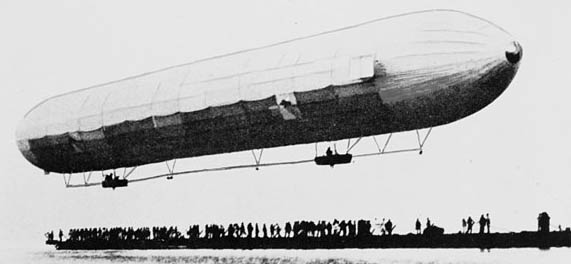
The first flight of the Zeppelin LZ1 in 1900
His 1892 design already comprised the main trademarks of the type, a rigid but modular aluminium framework covered with fabric and internal cells, as written down by engineer Theodor Kober and submitted to the Prussian high command. His 1895 patent called for a Lenkbarer Luftfahrzug mit mehreren hintereinanderen angeordneten Tragkörpern or “steerable airship-train with several carrier structures arranged one behind another”. A succesful lecture at the Association of German Engineers was followed by an enthusiastic fund raising and later a stock company was setup with the help of Carl Berg (aluminium manufacturing), Philipp Holzmann, Daimler, Max von Eyth, Carl von Linde, and Friedrich Voith in 1896, and in 1898-1900, ended with the building and first tests of the Zeppelin LZ1.
Pre-war era Zeppelins
The LZ-1 was a short-lied experiment, a “proof of concept” in the sense we give it today. This first Zepelin showed not only it was longer than the French La France but also faster, but it was dismantled nevertheless because of the lack of funds in 1901. The next one, LZ2 was ready by November 1905 and taken out of its hangar to be carried to lake Constance, but it never lifted off. After a second attempt, it flew for some distance but eventually crashed landing in emergency and was damaged beyond repair. The LZ3 of October 1906 was however a fair and unmitigated success, accumulating flight of great duration and eventually purchased by the Army. It was lengthened for the occasion and used for training until being retired in 1913. Both types were assimilated to the “B-Type”. In 1908 a C-Type was introduced, LZ-4. This larger craft completed a record 12 hours flight mission, and then 24h endurance flight but it landed because of an engine failure and was destroyed because of strong winds. The LZ5 (May 1909) of the same type also was lost during a storm, severing all its moorings and crashed landed near Weilburg in March 1910, a complete loss. The LZ7 was another military Zeppelin from 1911, of the F type also in civilian use, and named Ersatz Z II. She was used for training and decommissioned on 1st August 1914. Other military Zeppelin prewar included LZ9, 12, 14, up to LZ25 of the H, L and K types. Of these the H type was the most prolific with 6 units.
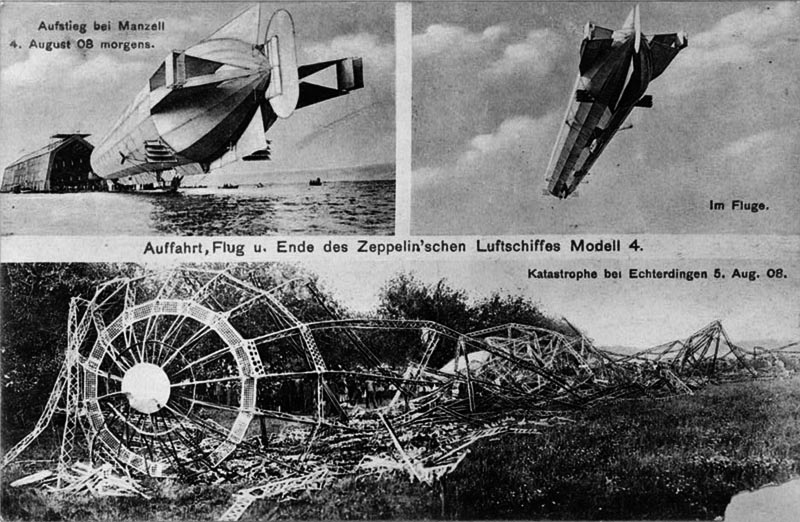
Zeppelin LZ4 gallery and wreck in 1910. Contrary to the awaited effect of such blow, the “Miracle at Echterdingen” took place: The Germans contributed 6 million marks for the construction of a new airship and gave new life to the zeppelin enterprise.
DELAG Zeppelins
LZ6 was the first D-type and also the first to experiment with wireless communication. It was also the first used for passengers by DELAG. It was lost however in a fire in its own hangar of Ooos, near Baden-Baden in September 1910. She was followed by two E-Types, this time not experimental but for regular flights: The LZ7 and LZ8, both of the new E-type in 1910-1911. but both were ill-fated. The first was introduced on 19 June 1910, but one week later, she was damaged beyond repair after crashing during a thunderstorm over the Teutoburg Forest. The second, named Deutschland II to replace the first, named “Deutschland” flew from April to May 1911: She was indeed caught by a strong crosswind while being walked out of the hangar, and so badly damaged she was scrapped afterwards. However the LZ 10 named “Schwalben” introduced on 26 June 1911, was the first true DELAG commercial success, carrying 1,553 passengers in 218 commercial flights. However in June 1912 she caught fire when a strong gust damaged its mooring near Düsseldorf, causing in addition some injuries. The Viktoria Luise or LZ 11 was the first G-Type (only two built, the second was for the military) and was used from 1912 by DELAG until 1914, when she was taken by the German military for conversion to a training airship. She was lost because of massive structural failure in her hangar on 1 October 1915. LZ 13 “Hansa” from 30 July 1912 was DELAG’s last prewar airship. She traveled 44,437 km (27,612 mi; 23,994 nmi) in 399 flights. She was also the first to carry passengers outside Germany. She was also personally commanded by Graf von Zeppelin when visiting Denmark and Sweden in September 1912. When the war broke out she was taken over by the German military, served for reconnaissance and training and was decommissioned in the summer 1916.

LZ 13 “Hansa”, a G-Type served with DELAG and was its most successful airship. Luck went on in Army service later without incident and she was retired in 1916.
Wartime Zeppelins
The serie went on with the single N-Type LZ 26 (tactical id Z XII), a successful bomber that made 11 attacks in Northern France and the Eastern front. She dropped a total of 20,000 kgs (44,000 lb) and later an additional 9,000 kg (20,000 lb) on the Warsaw to Petrograd trunk railway line and was able to carry 3,000 kg (6,600 lb) at each flight. The next large wartime serie was the M-Type (11 built), already started before the war, with LZ24 (see later). There were only two O-Types, but 22 P-Types, 12 Q-Types. The R-Type was also called the “Super-Zeppelin” class, with a volume of 55,200 m3. They were able to carry 2350 kgs (5200 lb) of bombs and more. 17 were built, the last was LZ90 in 1917. Meanwhile, Zeppelin engineers worked on the S-Type (2), Height-Climber S class, with a lightened structure to improve maximum altitude. The years 1917-1918 saw several smaller-scale classes with the T-type (2), U-Type (5), V-Type (10), W-Type (2 which saw service in the Mediterranean) and the X-Type (3) which was to be the last wartime Zeppelin ever.

LZ 89 (L50), one of the many R-Type which performed 5 reconnaissance missions and 2 raids over UK, just ran out of fuel on 20 October 1917. Her crew attempted a landing, but the control car was torn off near Danmartin in the process. Without any control, she was eventually blown over the Mediterranean, five crew members staying on board.
Technology
Between 250,000 cows to 2.5 million cows to make bladders (More to come).
Classes of Zeppelin Airships
M-Class (1914)
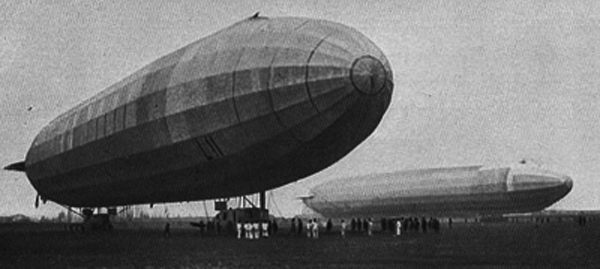
The first “mass-produced” class or military airships started just before the war and went on with about 11 airships, LZ24 to LZ37 (launched 4 March 1915). These were built at Friedrichshafen Yard. They hd 3 Maybach engines, could climb up to 2000m, out of reach of any fighters of the time, but both speed and bomb load were symbolic.

L7 (LZ 32) illustration from zeppelin-museum.dk
Specifications
Dimensions: Length: 518 ft 2 in (157.8m), Diameter: 48 ft 6 in (14.6 m), volume 794,500 sq ft
Weight: Empty 39,000 lb, Payload 18,500 lb
Propulsion: 3 Gondolas, Maybach C-X of 210 hp (630 hp total)
Performances: Max speed 52 mph (83 kmh), Range 1366 miles (416 km), Ceiling 6560 ft (2000 m)
O-Class (1914)
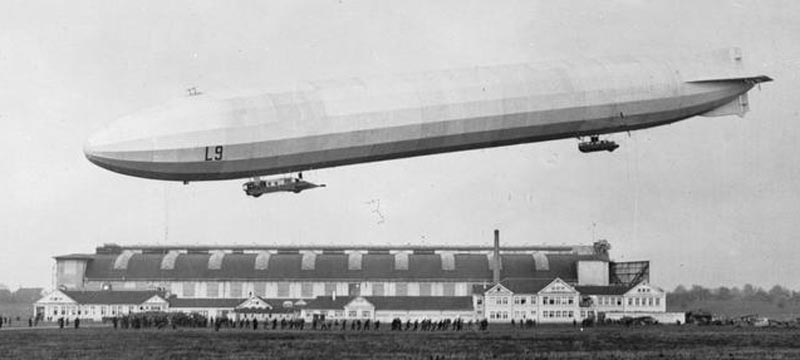
Only two, LZ36 and LZ39 were built of this serie, in March and April 1915.
The first performed 74 reconnaissance missions in the North Sea and four raids over Southern England, dropping 5,683 kg (12,529 lb) and also attacked several British submarines. She was eventually burnt out in her hangar on 16 September 1916. LZ39 launched three raids on the western fronts, and two on the eastern front (4,184 kg bombs dropped). On 17 December 1915, under orders of Dr. Lempertz, she was hit by shrapnel during an attack on Rovno. With all her gas cells punctured and front engine car badly hit. In fact it later fell it off and the crew dropped ballast, shifted loads to rebalance the ship and tried to steer it in the rear, making an attempt back to Germany. But she crashed landed later and collapsed due to the lack of gas.

Specifications
Dimensions: Length: 518 ft 2 in (157.8m), Diameter: 48 ft 6 in (14.6 m), volume 794,500 sq ft
Weight: Empty 39,000 lb, Payload 18,500 lb
Propulsion: 3 Gondolas, Maybach C-X of 210 hp (630 hp total)
Performances: Max speed 52 mph (83 kmh), Range 1366 miles (416 km), Ceiling 6560 ft (2000 m)
P-Class (1915)

The second “mass-produced” class or Zeppelins was launched in 1915 and went on until 1917. 22 were built, and in addition 12 of a the lengthened version, Q Class. Designed by Ludwig Dürr they were used both for reconnaissance and bombing. https://en.wikipedia.org/wiki/Zeppelin_P_Class
The P class was an enlarged version of the preceding M class, originally destined to the German Navy Ministry an derived from the LZ 26. First presented as a passenger airship for DELAG it was the ver first Zeppelin with a duralumin framework and a strengthening keel inside the hull. Its volume increased from 25,000 m3 (880,000 cu ft) to 31,900 m3 (1,126,000 cu ft), and a fourth engine was needed to vanquish air resistance. That size allowed also a greater range and (bomb) load plus for the first time enclosed gondola for the crew, instead of open one, making the trip more comfortable.
The P class in addition was more streamlined with only a 60 m (197 ft) section out of the total 163.5 m (536 5 in) that was cylindrical, and it was divided between sixteen 10 m (32 ft 9 in) bays for ballonets. The four 160 kW (210 hp) Maybach CX six cylinder engines were succeeded later in production by four 180 kW (240 hp) Maybach HSLu engines. Intermediate frames were fitted between each wire-braced ring frames, reduce lateral loads, and the 17 girders, housing the 16 gasbags made from three layers of goldbeater’s skin, backed by cotton, and latter plain rubberized cotton. Pressure relief valves were automated at the bottom of the gasbags, waste being simply diffused upwards between gasbags. Some of these also had manual backups. The covering was undoped to allow the hydrogen to escape.
The forward gondola was the bridge, and the crew accommodations was divided into two separate sections to avoid engine vibration and this small gap was faired over with fabric. The forward section was divided into three compartments, control area, radio compartment, and officer’s rest room. On both sides of the latter, windows had a machine-gun port. The engine compartment at the rear section contained a single engine mated to a propeller at the rear, with a reduction gear. The engine gondola carried three engines in line, with one driving the back gondola and the other a pair of propellers on each side, which could work in reverse for maneuvers. A machine-gun mounting was fitted on each side and there was another single machine at the stern, behind the rudders, in a small cockpit a bit like WW2 bombers tail gunner.
Two or three machine guns were also mounted on top of the hull in a bathtub-like arrangement, reached by a ladder accessible from the forward gondola Between the keel girders were suspended electrically released bomb, from the control gondola. The crew comprised 19 airmen, one Executive Officer, a Commander, Navigator, “Sailmaker” (responsible for gasbags), a Chief Engineer, 2 altitude coxswains, 2 steering coxswains, and 8 lower-rank engineers).
Specifications
Dimensions: Length: 163.50 m (536 ft 5 in), Diameter: 18.69 m (61 ft 4 in), Volume: 32,920 m3 (1,162,400 cu ft)
Propulsion: 4 × Maybach 3M C-X 6-cylinder inline piston engine, 160 kW (210 hp) each
Performance: Max. speed: 92 km/h; 50 kn (57 mph), Cruise speed: 63 km/h; 34 kn (39 mph), Ceiling: 3,500 m (11,600 ft)
Armament: 7/8 water-cooled MG 08/air-cooled Parabellum MG 14, 2,000 kg (4,400 lb) bombs
Q-Class (1916)
By late 1915, Zeppelin introduced the Q class, a true fliying fortress capable of a greater operation ceiling. Its hull was lengthened by 15 m (49 ft), for an internal volume up to 35,800 cubic metres (1,264,100 cu ft) and soon, all existing P class airships were lengthened and bring to the Q-Class standard.

L7 (LZ 32) illustration from zeppelin-museum.dk
Specifications
Dimensions: Length: 518 ft 2 in (157.8m), Diameter: 48 ft 6 in (14.6 m), volume 794,500 sq ft
Weight: Empty 39,000 lb, Payload 18,500 lb
Propulsion: 3 Gondolas, Maybach C-X of 210 hp (630 hp total)
Performances: Max speed 52 mph (83 kmh), Range 1366 miles (416 km), Ceiling 6560 ft (2000 m)
Zeppelins launched before and during WW1
- LZ1 (1900) test airship, dismantled 1901
- LZ2 (1906) B-class, failed to flew 1906
- LZ3 (1906) B-class decomm. 1913
- LZ4 (1908) C-class destroyed 1908
- LZ5 (1909) C-class destroyed 1910
- LZ6 (1909) D-class destroyed 1910
- LZ7 (1910) E-class destroyed 1910
- LZ8 (1910) E-class Lost 1911
- LZ9 (1911) F-class decomm. 1914
- LZ10 (1911) F-class (civilian) lost 1912
- LZ11 (1912) G-class used by DELAG, then Luft. Lost 1915
- LZ12 (1912) F-class Military service Decomm. 1916
- LZ13 (1912) G-class Made 399 flights, DELAG then Luft. decomm. 1916
- LZ14 (1912) H-Type Lost in Helgoland (storm) 1913
- LZ15 (1913) H-Type Lost in forced landing 1913
- LZ16 (1913) H-Type Crash landed in France 1913
- LZ17 (1913) H-Type DELAG then converted bomber, decomm. 1913
- LZ18 (1913) I-Class Lose in the Johannisthal Air Disaster the same year
- LZ19 (1913) H-Type forced landing June 1914
- LZ20 (1913) H-Type Lost wartime during the attack on Mława, Battle of Tannenberg
- LZ21 (1913) K-Type bomber, crash landed in Bonn
- LZ22 (1914) L-Type recce missions, crash landed in Lorraine
- LZ23 (1914) L-Type Bomber, crash-landed Brandonvillers
- LZ24 (1914) M-Class Long range overseas recce model, crash-landed at sea
- LZ25 (1914) M-class Bombed Antwerp destroyed in Hangar Düsseldorf 1914
- LZ26 (1914) N-Type bomber France Poland, Decomm. 1917
- LZ27 (1914) M-Type recce missions, Blitz, crash landed Blavandshuk 1915
- LZ28 (1914) M-Type recce mission north sea, Lost over Russia 1915
- LZ29 (1914) M-Type Bomber, Forced landing St Quentin 1914
- LZ30 (1914) M-Type Bomber eastern ft, lost accident 1915
- LZ31 (1914) M-Type Cuxhaven Raid, recce missions, lost by fire Fuhlsbüttel 1916
- LZ32 (1914) M-Type Bomber over UK. Downed 1916 by ships
- LZ33 (1914) M-Type Recce lissions western Ft. Fired by AAA 1915
- LZ34 (1915) M-Type Bomber Eastern Ft. Damaged 1915, dest. by fire at Insterburg
- LZ35 (1915) M-Type Bomber Fr Belg, Forced landing Aeltre AAA, storm
- LZ36 (1915) O-Type Recce missions North Sea, raids UK, Lost hangar 1916
- LZ37 (1915) M-Type short down near Ghent 1915
- LZ38 (1915) P-Class, Blitz, destroyed Hangar Evere
- LZ39 (1915) P-Class, Raids Easter, western ft. Damaged by AAA 1915
- LZ40 (1915) P-Class, Recce missions over North sea, Blitz, lost storm 1915
- LZ41 (1915) P-Class, Recce missions Jutland battle, Decomm. 1917
- LZ42 (1915) P-Class, Schoolship, Decomm. 1917
- LZ43 (1915) P-Class recce missions downed AAA 1915
- LZ44 (1915) P-Class Bombing raids, Lost Eifel Mt. 1915
- LZ45 (1915) P-Class 45 recce missions and 15 Raids, Decom. 1917
- LZ46 (1915) P-Class 42 recce, 17 raids missions, decomm. 1918
- LZ47 (1915) P-Class 6 Bomb. missions, Batt. Verdun 1916
- LZ48 (1915) P-Class 8 recce, 3 raid missions, downed AAA Dartford 1916
- LZ49 (1915) P-Class Eastern Ft., France, downed by AAA 1916
- LZ50 (1915) P-Class 44 recce, 12 raids, lost Nordholz 1917
- LZ51 (1915) P-Class SE and Eastern fts, downed AAA Bulgaria 1916
- LZ52 (1915) P-Class Lost accident Tondern 1915
- LZ53 (1915) P-Class 27 recce, 9 raids missions, Destroyed hangar Trondern 1916
- LZ54 (1915) P-class, Blitz, Down Dutch AAA North sea 1916
- LZ55 (1915) P-Class, 6 raids eastern ft. downed by HMS Agamemnon 1916 Vardar
- LZ56 (1915) P-Class, 7 raids, East/SE Fronts crash-landed Temesvar 1916
- LZ57 (1915) P-Class, 18 missions, decomm. 1917
- LZ58 (1915) P-Class, 14 recce, 3 raids, decom. 1917
- LZ59 (1915) Q-Class, 6 recce, 2 raids; landed Norway 1916
- LZ60 (1916) P-Class, 4 raids, lost storm 1916
- LZ61 (1916) Q-Type 17 recce, 10 raids, downed BE 2C 1916
- LZ62 (1916) R-Type, 31 recce, 10 raids, retired 1917, to Belgium 1920
- LZ63 (1916) P-Type, 3 raids, decom. 1917
- LZ64 (1916) Q-Type, 30 recce, 3 raids, short down 1917 RNAS Curtiss H12
- LZ65 (1916) Q-Type, downed AAA Feb. 1916 1st mission Vitry-le Francois
- LZ66 (1916) Q-Type, 51 recce, 3 raids, downed 1917 Sopwith pup from HMS Yarmouth
- LZ67 (1916) Q-Type raids London, Boulogne, Bucarest, decom. 1917
- LZ68 (1916) Q-Type, 1 raid, 15 recce, decom. 1917
- LZ69 (1916) Q-Type, 19 recce, 4 raids, accident Dec. 1916
- LZ70 (1916) Not built
- LZ71 (1916) Q-Type, raided SE Europe, dismantled Bulgaria 1917
- LZ72 (1916) R-Type 1 recce, 6 raids, downed aircraft Oct. 1916 north London
- LZ73 (1916) Q-Type 1 raid Calais, 7 others, Decom. 1917
- LZ74 (1916) R-Type blitz, 3 raids UK, short down 1916 RAF BE2C
- LZ75 (1916) R-Type 17 recce, 4 raids, decom. 1917, transferred japan 1920
- LZ76 (1916) R-Type Blitz, intercepted, forced landed 1916
- LZ77 (1916) Q-Type 1 raid Boulogne, Decomm. 1917
- LZ78 (1916) R-Type 3 recce, 2 raids Blitz Shot down Nov. 1916 by BE2C
- LZ79 (1917) R-Type 15 recce, 4 raids Blitz, school ship 1917, scuttled 1919
- LZ80 (1917) R-Type 13 recce, 3 raids, Decomm. 1918
- LZ81 (1917) Q-Type Transferred Navy 1917, recce Baltic, Decom Aug. 1917
- LZ82 (1917) R-Type 20 recce North sea, UL, crash landed 1917
- LZ83 (1917) R-Type 15 recce East. Ft. Baltic, 3 raids, transferred Fr 1920
- LZ84 (1916) R-Type Crash landed St Petesrburg Dec. 1916
- LZ85 (1917) R-Type 12 recce, 3 raids, forced landing Sisteron Fr. Oct. 1917
- LZ86 (1916) R-Type 3 recce, 1 raid Blitz, shot AAA Compiègne March 1917
- LZ87 (1917) R-Type 18 recce, 3 raids, Destroyed by fire Ahlhorn Jan. 1918
- LZ88 (1917) R-Type 7 recce, 2 raids Blitz, crash landed Nordholz
- LZ89 (1917) R-Type 5 recce, 2 raids Blitz lost Med. October 1917
- LZ90 (1917) R-Type 17 recce, 3 raids East. Ft. retired Oct. 1917, transferred Italy 1920
- LZ91 (1917) S-type new high altitude proto, 20 recce missions, school ship 1918, scuttled 1919
- LZ92 (1917) S-Type 6 recce missions, 1 raid blitz, shot down June 1917
- LZ93 (1917) T-Class 8 recce missions, 4 raids Blitz, shot down Lunéville Fr Oct 1917
- LZ94 (1917) T-Class 19 recce missions, 3 raids blitz, burnt Alhorn explosion
- LZ95 (1917) U-Class 1 recce mission, shot down 17 June 1917
- LZ96 (1917) U-Class 2 recce missions, 1 raid Blitz, forced landed r October 1917
- LZ97 (1917) U-Class 3 recce mission, 1 raid Blitz, lost Alhorn explosion
- LZ98 (1917) U-Class 20 recce missions, 1 raid, scuttled 1919
- LZ99 (1917) U-Class 14 recce, 2 raids Blitz, burnt HMS Furious planes Toska attack 1918
- LZ100 (1917) V-Class 19 recce missions, 4 raids blitz, short down Sop. Camel from HMS Redoubt destroyer 1918
- LZ101 (1917) V-Class 2 raids, force landed Oct. 1917
- LZ102 (1917) W-Class lost storm Oct 1917
- LZ103 (1917) W-Class 17 recce missions, 1 raid 1918, scuttled 1919
- LZ104 (1917) W-Type Afrika-Schiff based Bulgaria, crashed Otranto April 1918
- LZ105 (1917) V-Type 2 recce missions, destroyed Alhorn explosion 1918
- LZ106 (1917) V-Type 9 recce missions, 1 raid blitz, To Italy 1920
- LZ107 (1918) V-Type 2 recce missions, 2 raids Blitz, crashed helgoland 1918
- LZ108 (1917) V-Type 11 recce missions 1 raid, destroyed Toska attack
- LZ109 (1918) V-Type 13 recce missions, 1 raid Blitz, scrapped 1920
- LZ110 (1918) V-Type 3 raids blitz 1918, scuttled 1919
- LZ111 (1918) V-Type last raid Blitz 1918, scuttled 1919
- LZ112 (1918) X-Type last raid Blitz Aug. 1918, shot down DH-4
- LZ113 (1918) X-Type never used, transferred UK but scrapped
- LZ114 (1918) X-Type completed 1920 to France as Dixmude (lost 1923)
- LZ115 (1918) Cancelled
- LZ116 (1918) Cancelled
- LZ117 (1918) Cancelled
- LZ118 (1918) Cancelled
- LZ119 (1918) Cancelled
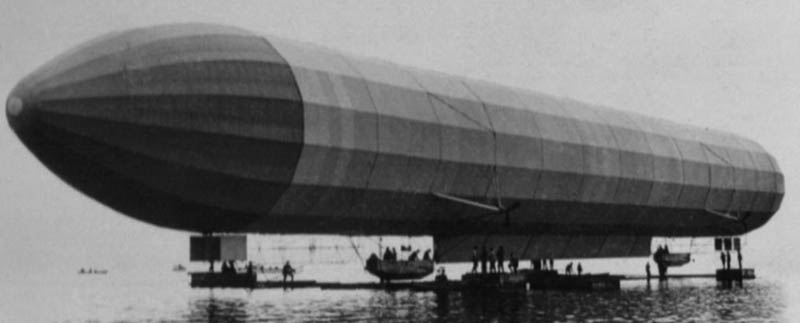 Zeppelin LZ2 in 1906
Zeppelin LZ2 in 1906
Zeppelin Aircrafts
Lesser known, Zeppelin aircrafts were mostly massive, as expected. They were manufactured in two facilities, Zeppelin in Lindau (later Dornier flugzeugbau, headed by young Claude Dornier), and at Staaken (mostly heavy bombers).
Zeppelin-Lindau R-series patrol seaplanes
Zeppelin-Lindau Rs.I model
Claudius Dornier gained the attention of Count Ferdinand von Zeppelin while working on a proposed trans-atlantic airship during 1913. Later he appointed him as chief designer of the Zeppelin-Werke at Lindau, responsible for building large patrol flying boats. Dornier’s first design to be built was the Rs.I. This was a large aircraft (Riesenflugzeug in the German classification) constructed largely of high-strength steel for highly stressed parts, and Duralumin (aluminium alloy) for low stress parts. The wings were on top of the hull and were braced with four sets per side of Warren strut style interplane structures comprising ‘V’ struts, which obviated the need for drag inducing wire bracing. The wing structure was formed with built-up steel spars, four in the top wing and three in the lower wing, and duralumin ribs riveted to the spars and braced internally. The fuselage was also made up from formed steel members built up into a framework which was then covered with fabric or dural sheeting. The powerplant arrangements were unorthodox, with the two outboard engines housed inside the fuselage, each driving a pusher propeller via shafts and bevel gearboxes, and a central pusher engine in a nacelle between the wings
- Zeppelin-Lindau (Dornier) Rs.I – giant patrol seaplane
- Zeppelin-Lindau (Dornier) Rs.II – giant patrol seaplane
- Zeppelin-Lindau (Dornier) Rs.III – giant patrol seaplane
- Zeppelin-Lindau (Dornier) Rs.IV – giant patrol seaplane
- Zeppelin-Lindau (Dornier) D.I – fighter
- Zeppelin-Lindau (Dornier) C.I – two-seat military aircraft
- Zeppelin-Lindau (Dornier) C.II – two-seat military aircraft
- Zeppelin-Lindau (Dornier) CS.I – two-seat floatplane
- Zeppelin-Lindau (Dornier) CL.II – two seat close support/ground attack aircraft
- Zeppelin-Lindau (Dornier) V1 – experimental pusher to test stressed skin structure
- Zeppelin (Ja) C.I – reconnaissance, unrelated to previous C.I
- Zeppelin (Ja) C.II -reconnaissance, unrelated to previous C.II
- Zeppelin-Staaken V.G.O.I – heavy bomber
- Zeppelin-Staaken V.G.O.II – heavy bomber
- Zeppelin-Staaken V.G.O.III – heavy bomber
- Zeppelin-Staaken R.IV – heavy bomber
- Zeppelin-Staaken R.V – heavy bomber
- Zeppelin-Staaken R.VI & Type L seaplane – heavy bomber/patrol bomber
- Zeppelin-Staaken R.VII – heavy bomber
- Zeppelin-Staaken 8301 – heavy floatplane bomber
- Zeppelin-Staaken R.XIV – heavy bomber
- Zeppelin-Staaken R.XV – heavy bomber
- Zeppelin-Staaken R.XVI – heavy bomber
- Zeppelin-Staaken E-4/20 – heavy bomber/transport
Src, Read More:
https://en.wikipedia.org/wiki/Ferdinand_von_Zeppelin
https://en.wikipedia.org/wiki/Airship
https://en.wikipedia.org/wiki/Zeppelin
http://www.airships.net/
https://en.wikipedia.org/wiki/List_of_Zeppelins
http://www.zeppelin-museum.de/
http://www.zeppelin-museum-zeppelinheim.de/
www.zeppelin-museum.dk/
http://www.zeppelin-lz.com/lz-archiv.html
https://www.wired.com/2014/10/world-war-i-zeppelins/
https://www.independent.co.uk/news/world/europe/q-how-many-cows-does-it-take-to-build-a-zeppelin-a-250000-8782723.html
https://www.militaryfactory.com/aircraft/ww1-airships.asp


 Latest Facebook Entry -
Latest Facebook Entry -  X(Tweeter) Naval Encyclopedia's deck archive
X(Tweeter) Naval Encyclopedia's deck archive Instagram (@navalencyc)
Instagram (@navalencyc)





 French Navy
French Navy Royal Navy
Royal Navy Russian Navy
Russian Navy Armada Espanola
Armada Espanola Austrian Navy
Austrian Navy K.u.K. Kriegsmarine
K.u.K. Kriegsmarine Dansk Marine
Dansk Marine Nautiko Hellenon
Nautiko Hellenon Koninklije Marine 1870
Koninklije Marine 1870 Marinha do Brasil
Marinha do Brasil Osmanlı Donanması
Osmanlı Donanması Marina Do Peru
Marina Do Peru Marinha do Portugal
Marinha do Portugal Regia Marina 1870
Regia Marina 1870 Nihhon Kaigun 1870
Nihhon Kaigun 1870 Preußische Marine 1870
Preußische Marine 1870 Russkiy Flot 1870
Russkiy Flot 1870 Svenska marinen
Svenska marinen Søværnet
Søværnet Union Navy
Union Navy Confederate Navy
Confederate Navy Armada de Argentina
Armada de Argentina Imperial Chinese Navy
Imperial Chinese Navy Marinha do Portugal
Marinha do Portugal Mexico
Mexico Kaiserliche Marine
Kaiserliche Marine 1898 US Navy
1898 US Navy Sovietskiy Flot
Sovietskiy Flot Royal Canadian Navy
Royal Canadian Navy Royal Australian Navy
Royal Australian Navy RNZN Fleet
RNZN Fleet Chinese Navy 1937
Chinese Navy 1937 Kriegsmarine
Kriegsmarine Chilean Navy
Chilean Navy Danish Navy
Danish Navy Finnish Navy
Finnish Navy Hellenic Navy
Hellenic Navy Polish Navy
Polish Navy Romanian Navy
Romanian Navy Turkish Navy
Turkish Navy Royal Yugoslav Navy
Royal Yugoslav Navy Royal Thai Navy
Royal Thai Navy Minor Navies
Minor Navies Albania
Albania Austria
Austria Belgium
Belgium Columbia
Columbia Costa Rica
Costa Rica Cuba
Cuba Czechoslovakia
Czechoslovakia Dominican Republic
Dominican Republic Haiti
Haiti Hungary
Hungary Honduras
Honduras Estonia
Estonia Iceland
Iceland Eire
Eire Equador
Equador Iran
Iran Iraq
Iraq Latvia
Latvia Liberia
Liberia Lithuania
Lithuania Mandchukuo
Mandchukuo Morocco
Morocco Nicaragua
Nicaragua Persia
Persia San Salvador
San Salvador Sarawak
Sarawak Uruguay
Uruguay Venezuela
Venezuela Zanzibar
Zanzibar Warsaw Pact Navies
Warsaw Pact Navies Bulgaria
Bulgaria Hungary
Hungary

 Bundesmarine
Bundesmarine Dutch Navy
Dutch Navy Hellenic Navy
Hellenic Navy Marina Militare
Marina Militare Yugoslav Navy
Yugoslav Navy Chinese Navy
Chinese Navy Indian Navy
Indian Navy Indonesian Navy
Indonesian Navy JMSDF
JMSDF North Korean Navy
North Korean Navy Pakistani Navy
Pakistani Navy Philippines Navy
Philippines Navy ROKN
ROKN Rep. of Singapore Navy
Rep. of Singapore Navy Taiwanese Navy
Taiwanese Navy IDF Navy
IDF Navy Saudi Navy
Saudi Navy Royal New Zealand Navy
Royal New Zealand Navy Egyptian Navy
Egyptian Navy South African Navy
South African Navy






























 Ukrainian Navy
Ukrainian Navy dbodesign
dbodesign